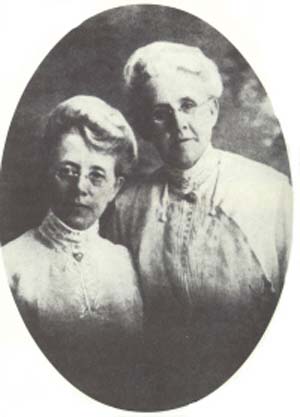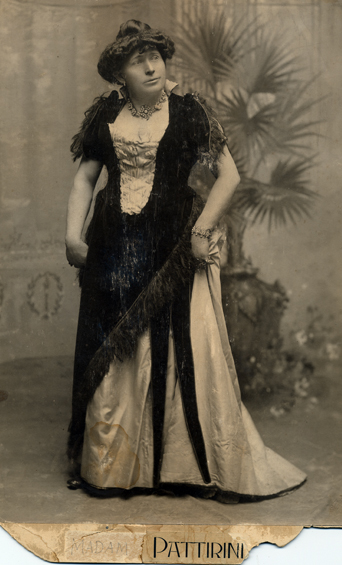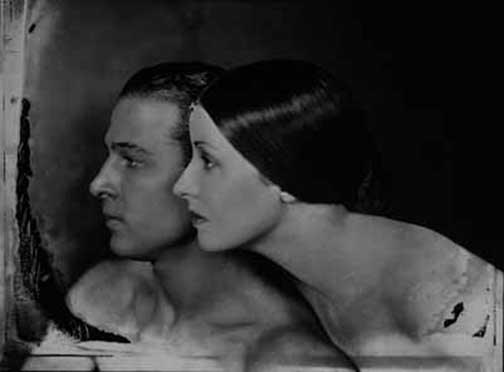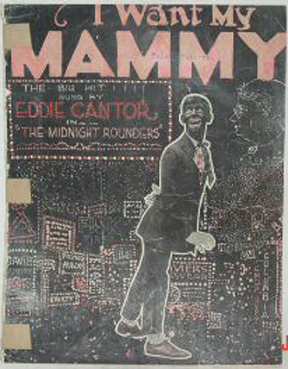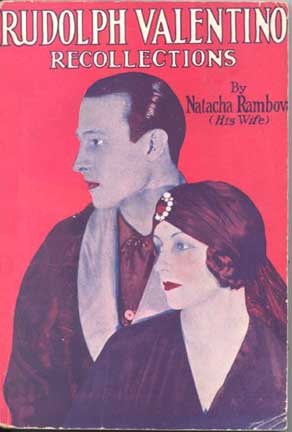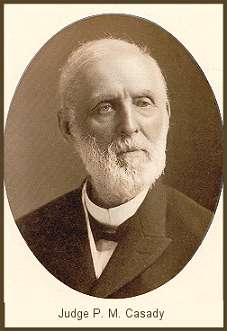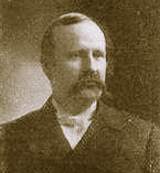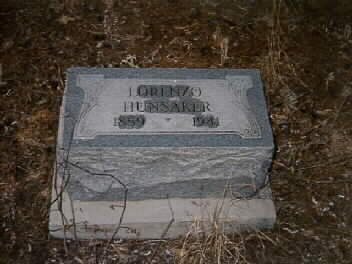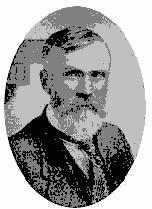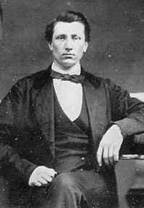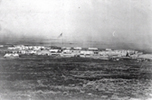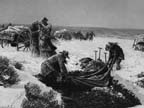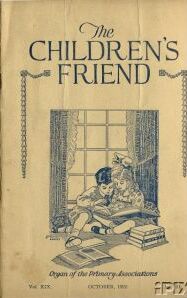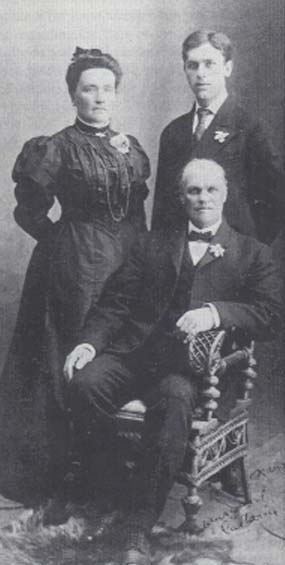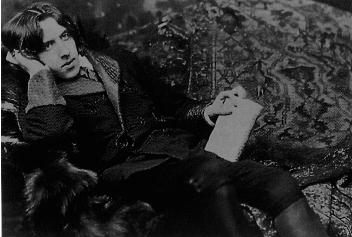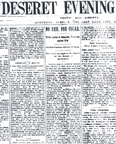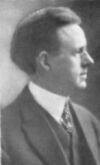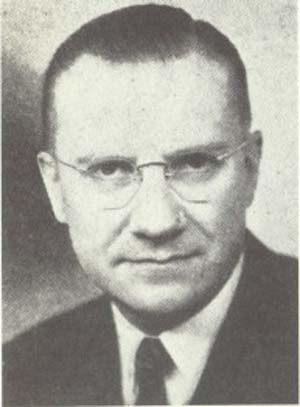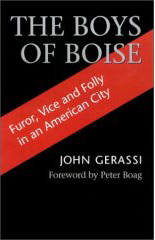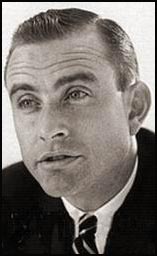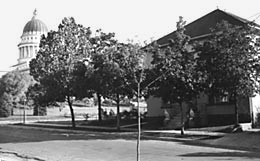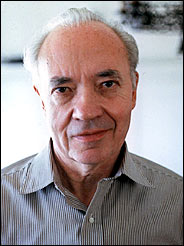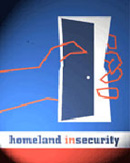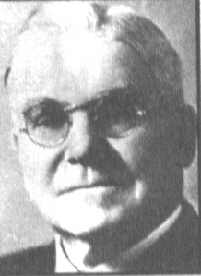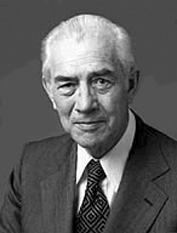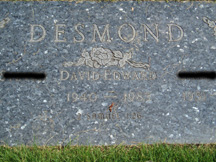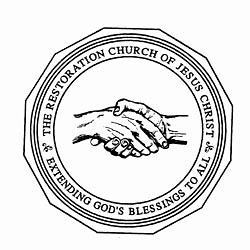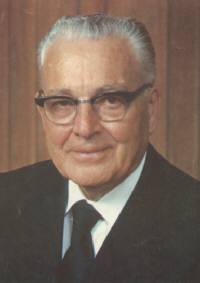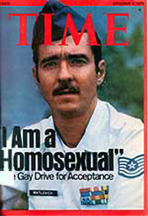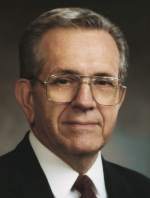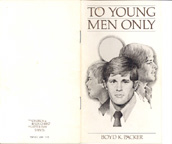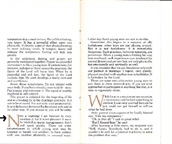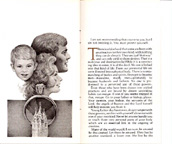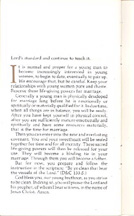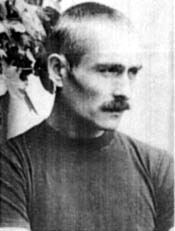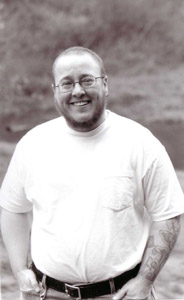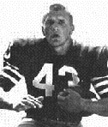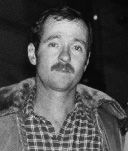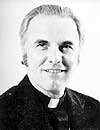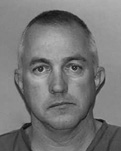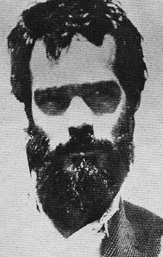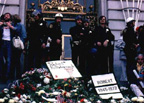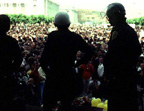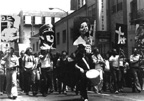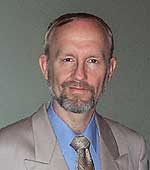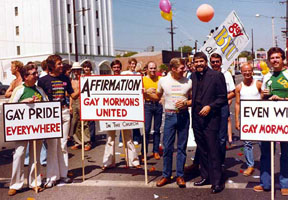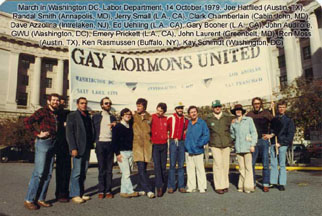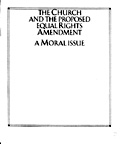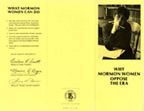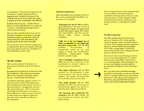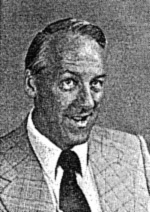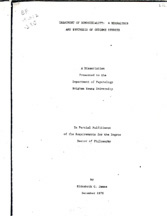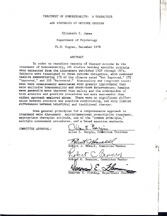I must point out that the LDS priesthood leader is
not once instructed to feel or demonstrate love or compassion for the
homosexual. In fact the only time the word love occurs in this entire
pamphlet is when the leader is promised that homosexuals "will love
your for all eternity for your help to them"!
A year after "Hope for Transgressors" was distributed
to bishops and stake presidents, Kimball published "New horizons for
Homosexuals" through Deseret News Press, for distribution throughout
the church to all members who were dealing with homosexuality. Written
initially for a close relative of Kimball's, either on December 12,
1965 or sometime during 1966, it was revised in 1971 for a more
general audience, but retained its "letter" format and saccharine,
ingratiating paternalism. [97] [CLICK
HERE FOR SCANS OF "NEW HORIZONS FOR HOMOSEXUALS"]
Kimball first informs the homosexual reader, "I am
your friend, your real friend, for I am trying hard to help you save
yourself frompitfalls, which I am sure, you do not fully realize are
gaping wide to swallow you, the victim". He then indicates that while
each homosexual has free agency and "may do as you please", "the Lord
did not waive penalities and it is an unalterable decree that every
man shall suffer or enjoy the due rewards of his deeds." Heterosexuals
may "begin the ruinous practice of perversion through curiosity and
then become entangled in its tentacles (p. 3). Yet for even those
"deeply entrenched, there is hope". Kimball warns that "[s]ex
perversion is a hidden menace at first but eventually undermines and
destroys its victims" (p. 4). Because sexual impurity is "[n]ext to
the crime of murder", no "rationalization can really neutralize the
pollution". Kimball then almost wistfully reminds the reader that the
"death penalty was exacted in the days of Israel for such wrong-doing"
(which both he and Petersen repeat several times throughout the coming
years, perhaps to manipulate Gays into believing that the torturous
programs the church will promote in the coming decades are nothing in
comparison to capital punishment, for which "compassionate leniency"
we should be grateful). However, "[t]hese sins are forgivable and can
be overcome if there is adequate restraint and repentance" (p. 5).
Finally in this pamphlet Kimball does state that "[t]he Lord, His
Church, and we, His leaders, love you." However this single
affirmation of ecclesiatical "love" rings completely hollow when
compared with the rest of the 34 pages of condemnatory language in
which Gays and their desires are described as utterly despicable and
completely controlled by Satan.
With such increased attention directed at
homosexuality, it soon became evident that there were a surprising
number of homosexuals in the Church. Kimball's biography mentions
several episodes of his counseling homosexual Mormons during the
mid-1960s, including four Mormons in the northwestern United States,
two of whom were college teachers. After two hours of meetings with
them Kimball recorded in his journal that "they claim they see no sin
in the matter, but that it is merely a new way of life....I was weary.
I had worked so hard and put so much of myself into it trying to
persuade them in the very few moments they gave me." Kimball also
vistied an excommunicated homosexual engineer in Los Angeles and told
him "that we loved him, the Lord loved him; we knew that basically he
was a good man; and his eyes dimmed with tears and he said, 'This is
the first time anyone from the Church has ever been kind to me in
connection with this.'" Kimball also recounted another interview with
a young Mormon who was "very curt and almost insulting" to Kimball.
The young Gay man told Kimball that he "was not qualified to handle
his case or to understand it or to help him, and that it was his
problem and that he did not wish to be pressed or hurried or
pressured." Ignoring his wishes, Kimball insisted that "as long as he
as a returned missionary and held the priesthood and was a member of
the Church that we did have jurisdiction and that we did not intend to
let him continue on with his sin; unless he was willing to cooperate,
he would need to be immediately excommunicated from the Church."
Bowing to such incredible brow-beating and ecclesiastical pressure
from an Apostle, Kimball smugly reported that the young man "finally
began to yield and was willing to cooperate to some degree." When
Kimball "personally reported" to President David O. McKay in 1968 on
his and Petersen's work in counseling male and female homosexual
Mormons, McKay "agreed to an enlarged committee". Kimball then
lamented, "We have lost some who did not cooperate and were
belligerent and went to the large cities to hide, but I feel there are
many happy people today because of the work that Brother Petersen and
I have done through the years".[98]
However, it must be pointed out that many (if not
all) of the "testimonials" that Kimball oft quoted and used as proof
of a homosexual cure were in fact lies, signed by people who were
tired of the ecclesiastical harassment, and found escape only by
deception. For example, in the early 1970s, Cloy Jenkins met a Mormon
man who was engaged to a female friend of Cloy. This man
confidentially disclosed to Jenkins that "he was homosexual, that he
had received counseling from the church, but that it had had no
effect. He had, however, told his counselor that he had changed. After
moving away from Utah, he had received what appeared to be a form
letter sent by President [sic] Kimball, stating that he had, through
his counseling, been cured of homosexuality. He was asked simply to
sign his name at the bottom and return it to the church offices, which
he did. He felt it was the only practical thing he could do, although
he knew full well it was not true. He was and is [homo]sexually
active. Yet, through the years, his letter has been held as proof of
the 'miracles of forgiveness.'" Several other Gays I have interviewed
also told me that they had been sent or personally given similar
letters to sign as "proof" that they were "cured" of homosexuality.
All signed them in order to decrease ecclesiastical surveillance and
punishment. [99]
After ten years of preparation, Kimball finally
published in 1969 his classic treatise on sin and repentance, The
Miracle of Forgiveness. In chapter six, "The Crime Against
Nature", he detailed his absurd theory that masturbation leads to
homosexuality, which in turn, can lead to bestiality. He also claimed
that "the sin of homosexuality is equal to or greater than that of
fornication or adultery," effectively placing homosexuality next to
murder in the Mormon hierarchy of sins. As Kimball's biography states,
while preparing the text of The Miracle of Forgiveness for
publication, he believed that homosexuality "would yield to consistent
prayerful exercise of self-restraint. He pointed out that homosexuals
rarely were excommunicated for their past acts but usually only for
their unwillingness to make the effort to change" their sexual
orientation.
Kimball and Petersen were formally released in 1972
from their assignment to "assist" homosexuals in changing their sexual
orientation and repenting of their "sinfulness". The assignment was
turned over to the "Personal Welfare Service of LDS Social Services".
By 1978, the "church director" in charge of working with homosexuals
in LDS Social Services was a man named Kent Petersen. However, Kimball
continuted to make homosexuality a priority and went out of his way to
counsel LGBT Mormons. In 1977, Victor L. Brown Jr. (of the Values
Institute) told Duane Jeffrey, BYU Zoology professor, that as of 1976,
Kimball had extensive files on some 1500 homo-, bi-, and transexual
Mormons. [100]
During the October 1977 General Conference Kimball
gave a speech called, "The Foundations of Righteousness" in which once
again he severely attacked homosexuality. Kimball told the faithful
that "Homosexuality is an ugly sin, but because of its prevalence, the
need to warn the uninitiated, and the desire to help those who may
already be involved with it, it must be brought into the open. It is
the sin of the ages....There is today a strong clamor to make such
practices legal by passing legislation....We do not hesitate to tell
the world that the cure for these evils is not in surrender....As we
think back upon the experiences of Nineveh, Babylon, Sodom and
Gomorrah, we wonder - will history repeat itself?"
While Kimball and Petersen were vociferously
attacking homosexuality, Gay Mormons began to dissent and resist.
Michael Quinn has documented that in 1966, 26 year old David-Edward
Desmond founded a break-off from the Church of Jesus Christ of
Latter-day Saints (Mormons) in Denver, Colorado. "The United Order
Family of Christ" was founded specifically for young Gay men only,
ages 18 to 30. Because they practiced a uniquely Mormon form of
communalism in which they held "everything in common", Desmond
affirmed that the Family was "not for the great majority of the Gay
LDS". This Mormon schismatic church thus became the second Gay
Christian church founded in the United States, the first being a
Catholic schism founded by Father George Hyde in 1946 in Atlanta,
Georgia and called the Eucharistic Catholic Church, which later moved
to New York City. Desmond's "homosexual Church of Jesus Christ" lasted
at least until 1973, when Desmond was still corresponding with David
C. Martin (then editor of the Restoration Reporter).
David-Edward Desmond was born in 1940, in Spokane, Washington to
19-year old Joyce Betty Grasty and her husband named Desmond (first
name unknown). David-Edward Desmond died on 11 May, 1983, in Pullman,
Washington. Grace Lutheran Church's Rev. Vernon Johnson held the
funeral and he was buried in Fairmount Memorial Park, Spokane.
In 1985, a group of six Gay men in the Los Angeles
Chapter of Affirmation formed another Mormon schismatic church for
Gays, called the Church of Jesus Christ of All Latter-day Saints
(later the Restoration
Church of Jesus Christ; not to be confused with the Restoration
Church of Jesus Christ of Latter Day Saints). Antonio A. Feliz
(a former Mormon bishop) was named the first president but he was
ousted eight months later because of changes he was making to the
church without consent of its members. Controversy and dissent have
marked its history since and its membership currently is almost
non-existent. The Restoration Church's book of modern scripture is
called Hidden Treasures and Promises.[101]
The LDS Church responded vociferously to the new
homosexual militancy. In March 1970, the First Presidency sent a
letter to the church at large, stating that "homosexuals can be
assured that in spite of all they may have heard from other sources,
they can overcome and return to normal, happy living."[102]
A month later, Victor L. Brown Sr., then second counselor in the
Presiding Bishopric, gave a speech during General Conference on
morality in the family, and addressed homosexuality in the context of
pornography. "The chief psychiatrist at one of Washington's largest
hospitals says, 'A normal 12- or 13-year-old boy or girl exposed to
pornographic literature could develop into a homosexual". Brown added,
"Some are even saying, 'What is wrong with becoming a homosexual?' In
one church, a leader recently performed a marriage between two male
homosexuals. As a matter of fact, some of the world news media made
quite a story of it. And yet who is responsible for this moral decay?"
Church President Harold B. Lee then delivered a speech on
eschatological signs during the Priesthood Meeting of October 1972
General Conference in which he stated,
The circular letter of 1970 and Lee's comment of 1972
were but precursors to the more official (and ecclesiastically
binding) First Presidency statement of 1973 which declared that
"homosexuality in men and women runs counter to...divine objectives
and, therefore, is to be avoided and forsaken." Gays and Lesbians who
refused to find their sexuality evil were promised "prompt Church
court action."[103] Excommunication to faithful
Mormons means eternal exclusion from the "Celestial Kingdom" - a hell
in and of itself.
In 1973, Victor L. Brown, Jr. of LDS Social Services
wrote the twenty page Homosexuality: Welfare Services Packet I
for use in counseling Lesbians and Gay men throughout the church. The
packet indicated that "an essential part of repentance" was to
disclose to Church authorities the names of other homosexuals, in
order "to help save others". The packet also stated that the Lesbian
"needs to learn feminine behavior" while the Gay man "needs to
learn...what a manly priesthood leader and father does." It also
explained that "excommunication cleanses the Church....There is no
place in God's Church for those who persist in vile behavior."[104]
Ironically, church leaders concluded that the Packet was so
"weakly" written that the church could only use it on a very limited
basis, only for the simplest of orientations to the controversial
topic. In 1980, Gay Mormon bishop Antonio Feliz recorded in his
journal that he had found evidence that the Packet had been
written in response to the founding of an "apostate group", which he
incorrectly identified as "Affirmation"
(the support group for Gay ande Lesbian Mormons, founded in 1977 - see
below). However Affirmation wasn't an "apostate group" (i.e. a
schismatic religion) but merely a support group, and it wasn't even
organized until 1977, so it is possible the Packet instead
was a response to the 1972 and early 1973 articles that appeared in
David C. Martin's Restoration Reporter on the formation of
David-Edward Desmond's "homosexual Church of Jesus Christ". [105]
After his court victory against the Air Force (which
ultimately ended in Matlovich resigning with a large settlement in
hand) he moved to San Francisco, and then appeared on the Phil
Donahue television show in 1978. On October 12, 1978, "Mat"
Matlovich received yet another summons from the Church, this time from
the San Francisco Stake President, Jonas J. Heaton of Daly City, to
investigate "conduct in violation of the law and order of the Church";
his second excommunication trial was scheduled for November 15.
Matlovich was unable to make that trial date and Heaton wrote an
identical letter on November 20, 1978, requesting a trial on January
17, 1979. In January 1979, both the California Sentinel and
the Bay Area Reporter published stories of how the LDS
church was shortly going to excommunicate Matlovich yet again.
Metropolitan Community Church Elder James Sandmire, an excommunicated
Mormon “high official” said in the media interviews that he had “had
seen or heard of hundreds of these cases where gays have either been
‘disfellowshipped’ or ‘excommunicated’” once, but not twice.
President Jonas Heaton also told the reporters that
there “is a move to drop the upfront Gay activist because of ‘conduct
in violation of the law and order of the church’- namely his
homosexuality.” Leonard in turn vowed, “that the attempt to remove him
from Mormon rolls will be a media event.” Leonard admitted he "[was]
confused on how he [could] be removed twice from the same church. When
Heaton was asked about the double excommunication, the official said,
‘This is a private matter within the church - I know a great deal
about Mr. Matlovich that I am not going to discuss.’” Matolovich was
then excommunicated a second time from the Mormon Church. As of 1978,
due to the unethical treatment he received by the Mormon Church, his
faith was crushed and he considered himself somewhere “between an
agnostic and an atheist.”
The publicity surrounding him was enormous, and he
received thousands of letters from all over the nation and even
Europe, praising his courage and bravery for coming out. Of the many
letters I read in his archived collection, only two were negative; the
rest were heart-wrenching expressions of gratitude. For example,
Joseph Allen, a native of Vienna, Austria, wrote him to say, "I saw
your picture on the front cover of Time and cried. It is, indeed, a
new awakening for us....I feel it happening because of people such as
you who are unafraid." Matlovich also befriended and corresponded with
several other Gay Mormons. For example, C.R. "Joe" Smith, corresponded
regularly with "Mat" in 1978 and 1979, encouraging him in his
activism, and frequently mentioning their bond as ex-Mormon Gays.
Smith had been raised in Utah but then excommunicated. He had moved to
Yucca Valley, California where he and his partner lived for many years
together, running an animal shelter in the high desert. Eventually the
media circus around Matlovich exhausted him and he grew weary of being
at the brunt of the Gay rights movement. However, he did continue to
speak out against homophobic crusader Anita Bryant, and in June 1977
was a featured speaker at a large Gay rights convention held in Salt
Lake City, during which Affirmation: Gay Mormons United was founded.
In 1980, a federal judge ordered the Air Force to reinstate Matlovich
with back pay. The Air Force, disgruntled that their policy was found
to be discriminatory and illegal, pressed Matlovich to drop his case
and settle out of court, or they would appeal the case to the US
Supreme Court. Finally Matlovich gave in and accepted $160,000 tax
free, and explained to angered Gay rights advocates that "he believed
it to be less likely to win a government appeal in front of an
increasingly conservative U.S. Supreme Court." Leonard Matlovich
announced that he had HIV on "Good Morning America" television show in
July of 1987 and died from AIDS in West Hollywood at the home of a
friend on June 22, 1988. His famous epitaph at the Congressional
Cemetary in Washington DC reads, "When I was in the military they gave
me a medal for killing two men and a discharge for loving one". [106]
During the priesthood session of October LDS general
conference in 1976 Apostle Boyd K. Packer gave a speech entitled "To
Young Men Only", that discussed situations in which young men
are "tempted to handle one another, to have contact with one another
in unusual ways." He commented that "such practices are
perversion....Physical mischief with another man is forbidden." Packer
also essentially advocated anti-Gay violence in his speech when he
recounted the story of a male missionary who had "hit" and "floored"
his mission companion, apparently for simply revealing his sexual
orientation. Because Packer does not specify the reason for the
violent response, he leaves the interpretation up to the reader.
Packer told the missionary, "Well, thanks. Somebody had to
do it and it wouldn't be well for a General Authority to solve the
problem that way." Packer told his audience, "I am not recommending
that course [of violence] to you but I am not omitting it. You must
protect yourself".[107] I myself was present at
this speech in the Tabernacle as a 15 year old Teacher in the Aaronic
Priesthood. His missionary story left me with the harrowing sense that
any future violence directed at me for my sexuality was justified by
"God and His servants". This antiquated, homophobic speech was later
made into a pamphlet by the same name and was distributed worldwide by
the LDS Church for use in counseling young men until quite recently.
As of 2011, Packer's speech has been deleted from both the "Conference
Addresses" and "Ensign articles" of the LDS church's official website,
lds.org.
While it is good that Packer's toxic and uneducated statements are no
longer accessible to the vulnerable, still he has not apologized or
been held accountable for his statements in any way. It is as if he
simply never gave the speech.
Radicalized Gay and Lesbian Mormons in the late 1970s
turned to the publishing world to help bring a voice of liberation to
the stifling oppression of homophobia. A year after millionaire David
Goodstein purchased the small "Los Angeles Advocate" Gay newsletter,
he moved it to San Francisco, called it simply The Advocate,
and hired Gay returned missionary (and son of a Mormon bishop) Robert
Isaac McQueen as editor-in-chief. McQueen had worked at the University
of Utah and as a journalist for the Salt Lake Tribune
previously. Robert had known both Brent Tommy Harris and Ray Larson
(Gay Mormons) from his days in Salt Lake City and hired them as
associate editor and art director respectively. Pat Califia, a lesbian
from a "blue collar Mormon family" in Salt Lake also joined the Advocate
staff soon thereafter, mainly as the sex advice columnist. These four
formed the nucleus of what would jokingly be referred to as "the
Mormon Mafia" of the Advocate.
The late spring and early summer of 1977 (especially
the month of June) was a momentous and explosive time for Gays and
Lesbians both in Utah, as well as nationally. Mormon politicians
refused Gays the constitutional right to assemble on state property,
Anita Bryant’s homophobic and heterosexist “Save Our Children, Inc.”
crusade based in Florida was gaining national attention and momentum
resulting in increased violence directed against Gays (including one
brutal murder), the ERA was under attack by right-wing extremists
using homophobic tactics, a support group for Gay Mormons was formally
organized as a reaction against increasing Mormon homophobia, the
Mormon-dominated Utah state legislature made homogamy illegal in the
state, and it was Gay Pride month nationwide, celebrating the 8th
anniversary of the Stonewall Riots in New York City, drawing hundreds
of thousands of Gays into the streets of the nation in previously
unseen numbers.
In April 1977, a formal dance for the Salt Lake "gay
Christian community" had been scheduled for the Utah State Capitol
Rotunda. However, Lt. Governor David Smith Monson (a Mormon) canceled
the dance, disingenuosly citing the safety and security of the dance
attendees as his concern (thus blaming the "victim"). Monson said "he
was afraid that since the [Metropolican Community] church [sponsoring
the dance] admits homosexuals there could be trouble from onlookers."
The Metropolitan Community Church filed a suit to force the governor
to allow the dance but despite the constitutional guarantee to freedom
of assembly, the Third District Judge Dean Conder "wrote a minute
entry saying permission was discretionary with Monson and he wouldn't
force him to allow the dance." [109]
Also that spring, Gay community members Kenneth A.
Kline, Rev. Robert Waldrop, Paul Larson, and Dorothy Makin (all former
Mormons) helped organize a convention for the "Salt Lake Coalition for
Human Rights" to discuss the plight of Gay rights in America. Kline
scheduled the convention to be held at the Mormon-owned Hotel Utah
across the street from the Salt Lake Mormon Temple. Ken Kline
allegedly informed hotel staff that same-sex dancing would occur at
the "Grand Ball" scheduled as part of the convention's activities.
(Bob Waldrop, no longer a reverend in MCC, in a recent email to me,
admits that he "only had Ken's word for it. My gut feeling was that he
had NOT told them, but...I was not about to break ranks on something
like that given the way everything was coming down" and Waldrop told
the press conference that the Hotel Utah staff had been informed about
the convention.) At the beginning of June, the board of directors for
the hotel grew alarmed at the advertising published around the city
for the convention, making it clear that the "human rights" in
question were in fact Gay rights.
In the meantime, voters in Dade County,
Florida overwhelmingly repealed its Gay rights ordinance after
heavy-handed crusading by orange juice spokeswoman Anita Bryant on
June 7, which was greatly lauded on the front page of the Deseret
News. According to Gay ex-Mormon historian, Ben Williams, just
two weeks earlier, on May 24, 1977 conservative LDS Utah Senator Orrin
Hatch addressed the listeners of Salt Lake radio station KSXX stating,
“Well I can tell you this, I think if you take what she [Anita Bryant]
says as truth, that she is not prejudiced against the homosexual, but
she realizes what they have done, that she does not want them teaching
her children. I tell you this — I don’t want them teaching my
children, and I don’t want them teaching your children either, and I
think they are becoming too blatant in our society, and I don’t want
to take other rights away from them, but I sure as heck don’t want
them teaching, and I don’t want them in sensitive areas around
children.”
The board met on the following day, Wednesday, June
8, and canceled the reservations for the convention's facilities, just
three days before the large convention was to begin. Victor L. Brown,
Presiding Bishop of the LDS Church and president of the Hotel Utah
Company claimed that "Hotel officials...were unaware of the nature of
the convention when it was first booked". Brown wrote a letter to
organizer Ken Kline saying the booking had been dropped by the board
of directors. "When you made arrangements for booking space at the
hotel, no mention was made as to the nature of your organization nor
the cause it seeks to advance," Brown wrote. "According to the
organization's advertising of the convention, those attending will be
encouraged to follow homosexual practices contrary to the laws of the
state of Utah and prevailing standards of public morals and decency,"
Brown continued. On Thursday, June 9, 1977, Shirley Pedler, director
of the Utah chapter of the ACLU issued a statement to the press
"condeming the hotel's action". Pedler cautiously avoided the issue of
whether or not the hotel management knew that "human rights" really
meant "Gay rights", and instead focused on the fact that the
"convention is being held for purposes of discussion and association
only and the refusal of the Hotel Utah to make good its commitment to
provide facilities violates the spirit of the U.S. Constitution, if
not the letter of the law." The convention planners quickly switched
venues to the nearby International Dunes Inn (the only hotel in Salt
Lake that would take the controversial group) and the convention
proceded as planned. Recently excommunicated Leonard Matlovich (see
his biography above) and Gay professional
football player David Kopay were the keynote speakers. (Although
Matlovich had been LDS, he never mentioned this at the press
conference in Salt Lake, nor did he tell any of the conference
organizers, according to Bob Waldrop. Despite his notoriety, Matlovich
was a very private person.) Symposia held at the Dunes on June 11
included "parents of gays discussing their attitudes towards their
children, Salt Lake City Police Dept. Vice Squad officers discussing
the legal treatment of gays and a former LDS church Stake President, Rev.
[James Earl] Sandmire, discussing the religious implications of
homosexuality." [109A]
During the June 1977 convention members of the "gay
Christian community" in Salt Lake City asked Gov. Scott M. Matheson (a
"liberal" Mormon Democrat) to appoint a commission to "study the
problem of gay rights in Utah". However Michael Youngren, the
governor's press secretary said it was "doubtful Matheson would form
such a commission" and added that the governor had declined even to
meet the group of petitioners.
Most importantly of everything that happened at the
convention, Gay and Lesbian Mormons formally organized a support group
called "Affirmation: Gay Mormons United, on Saturday, June 11. As Rev.
Waldrop recently recalled to me, the Mormons at the convention "had a
separate meeting, like a caucus meeting, at the hotel" to found
Affirmation. (See Affirmation section for
details.) Note that it was also in June 1977 that Gay BYU student,
Cloy Jenkins (assisted by Gay Mormons Jeff and Lee Williams, Howard
Salisbury, and Donald Attridge) wrote his infamous rebuttal, Prologue,
as a response to the homophobic lectures at BYU by Dr. I. Reed Payne.
(See Prologue section for details.) His
well-reasoned essay remained undisputed by BYU faculty (despite
several attempts) and eventually brought an end to the anti-Gay
"Values Institue" on campus.
In ever-increasing press coverage of homosexuality
that summer, a homophobic article entitled "Hollow Homes" appeared in
the Mormon-oriented magazine Sunstone by Bruce Steed,
referring to "sodomy and self-abuse" as a "disease" caused by the
machismo of "the mythical male role" and a lack of "genuine intimacy"
in the home. While Steed didn't agree with Spencer Kimball that
masturbation leads to homosexuality (which Kimball had taught in The
Miracle of Forgiveness), he did feel that "all who are
homosexuals masturbated seriously".[110]
The violence culminated on the night of June 22, just
three days before the San Francisco Gay Pride Parade, a San Francisco
city-employed gardener and religious brother in an Orthodox order, 33
year old Robert Hillsborough, and his on-again-off-again boyfriend,
Jerry Taylor, were assaulted by four knife-wielding young men just
outside Hillsborough's home in the Mission district. Taylor
escaped with severe injuries, but John Cordova and Mike Chavez
cornered Hillsborough and while their two friends, Tom Spooner and an
unnamed 16 year old, watched, Cordova brutally stabbed Robert 15
times. A neighbor testified that Robert's last words before dying
were, "Oh my god, oh my god! What are you doing to me?" All the
while, the four men shouted anti-Gay epithets like “faggot”, “queer”,
and (allegedly) “this one's for Anita!” Neighbors awakened by the
ruckus immediately rushed to the aid of the well-liked man and his
partner, but were too late to save Hillsborough. (Cordova was later
convicted of second degree murder and sentenced to 10 years.) [111]
This heinous hate-murder galvanized Gays and Lesbians
in the city and they turned out for the march in unexpectedly massive
numbers (estimates run between 100,000 and 300,000 strong), turning it
into a protest and “massive Civil Rights March” against Hillsborough’s
murder and Bryant’s incendiary homophobia and bigotry. The steps
of City Hall at the end of the parade route became an impromptu
memorial site where marchers laid photos and flowers in Hillsborough’s
honor.
For the San Francisco Gay Pride march, Larry Agriesti
created a series of large posters representing historical bigots,
including Joseph Stalin, Idi Amin, Adolt Hitler, and the Ku Klux Klan
– and at the very center, a large poster of an angelic Anita Bryant
singing "Battle Hymn of the Republic".
Agriesti writes, “The response from the crowds and
media was overwhelming; something I hadn’t expected…” and his entry
won a “Cable Car” award from the Parade Committee for best parade
entry called “Bigots on Parade”.
The Deseret News alarmingly reported that the Gay Pride
Parade in San Francisco that year was even larger than any of the
anti-war demonstrations of the 1960s. Just one year earlier, the
parade had drawn between 12,000 and 90,000 people. It was
becoming apparent that Anita's campaign and the subsequent rash of
anti-Gay violence in San Francisco and elsewhere- especially Robert
Hillsborough's murder - brought Gays out of the closet in record
numbers. (I myself came out to my high school Mormon religion teacher,
Robert Woods, in June 1977, spurred by these national events, even
though I was only 15 at the time. Woods then had me immediately
contact my bishop, Sheldon Childs - a 2nd cousin of my mother and now
a General Authority - and I was put in the church's "program" of
fasting, prayer, weekly interviews, and "therapy" to make me
heterosexual.)
Robert’s mother, Helen Hillsborough, told the press
that her “son’s blood is on [Bryant’s] hands”. The mayor of San
Francisco, George Moscone, accused "demagogues" like Bryant and other
prominent homophobes of the day of creating a "climate of hate and
bigotry" against Gays, then offered a substantial reward for
information leading to the arrest of the perpitrators (who were soon
caught), and ordered the city's flags lowered to half-mast on the day
of Hillsborough's funeral. (Note that one year later, Mayor
Moscone himself and Gay city supervisor Harvey MIlk would be
assassinated by fellow supervisor Dan White, in a brutal anti-Gay hate
crime at City Hall.) Anita Bryant was later named as a defendant in a
$5 million civil law suit which contended that her “Save Our Children”
campaign against homosexual equal rights had inspired the fatal
assault on Robert Hillsborough. By the end of November 1977,
however, Bryant had been dropped as a defendant. [112]
In October 1977, 27 year old Thom L. Higgins, a Gay
rights activist posing as a journalist, hit Bryant in the face with a
banana cream pie during one of her anti-Gay rallies in Des Moines,
Iowa.
Humiliated and forever tarnished by the image of the
pie dripping from her face, a stunned Anita finally bowed her head and
prayed in front of a national news audience that Higgins “be delivered
from his deviant lifestyle”. After sobbing briefly she
then quipped, “At least it was a fruit pie”.
Gay rights activists successfully retaliated with an
important moral victory when a Gay-lead nationwide boycott of Florida
orange juice resulted in Bryant losing her job as spokesperson for the
Florida Citrus Growers' Association. And Bryant's "Save Our
Children" campaign ultimately failed, as one activist wrote, in that
she "provided a focus for the [Gay] community and a platform for
presenting our case. 'Gay' became a household word. We
became front page news." An August 1977 report by Mother Jones
on the effects of Bryant's campaign agreed, noting that she "has done
more to politically energize American homosexuals than anything since
the 1969 Stonewall riots in New York's Greenwich Village launched the
modern-day gay liberation movement." The magazine also interviewed Robert
McQueen, former LDS editor of the Gay newsmagazine The
Advocate, who stated "It's really more significant than
Stonewall....Bryant has crystallized the issue. She's declared war,
and she's got a lot more people coming out of their closets to fight
back. Gay people are being politicized like never before." The article
concluded by understating that "there is a growing sense of outrage
among American homosexuals - an anger that is expected to be felt
increasingly in the political arena in the months to come."
Just two weeks before the devastating International
Women's Years conference in Utah (see section on
the Equal Rights Amendment), Barbara B. Smith, general president of
the LDS Relief Society, sent a telegram to Bryant, saying,
Adding fuel to the fire, Utah State Fair director
Hugh C. Bringhurst announced on June 28 that Anita Bryant, "songstress
and antigay rights publicist" would be singing and holding a rally at
the Fair on September 18, 1977. Outraged by this choice, the Salt Lake
Coalition for Human Rights began in June to organize a counter protest
at the Fair. Barbecues, t-shirts, bumper stickers, and posters were
used to raise money for the protest. The Coalition received official
support from the Salt Lake Metropolitan Community Church, the Gay
Services Coaliton of Utah, the Gay Student Union (at the University of
Utah), Women Aware (a Lesbian-feminist organization in Salt Lake) and
the Socialist Workers' Party of Utah. As a result, over 100 Gay
activists turned out to form a picket line at the Fair. Some of the
picketers were spat upon by attendees and some people were escorted
out of the stadium, but no violence broke out. The protesters later
circumnavigated Temple Square chanting slogans against oppression of
Gays. Some 500 Gay rights supporters attended a vigil that night at
Memory Grove in downtown Salt Lake, partially as a memorial for the
murdered Robert Hillsborough. Waldrop also reports that at the vigil,
"somebody hiding up above the group on a hill tossed a canister of
tear gas down on the crowd. It fell into an open space and everybody
drew back even more when they smelled what it was." (Waldrop also
remembers that during that same month, he was outside a Salt Lake Gay
bar handing out invitations to attend the Metropolitan Community
Church when four youths wielding bats drove up to him to assault him,
but then hastily departed upon seeing he was dressed in his
ministerial shirt.)
In response to Gay organzing against the former
"beauty queen turned fruit-juice peddler", on July 9, Mormon Apostle
Mark E. Petersen claimed in an editorial in the Church News that
"every right-thinking person will sustain Miss Bryant, a prayerful,
upright citizen, for her stand", which Petersen hoped would "keep this
evil from spreading, by legal acceptance, through our society." In
November of that same year, Spencer Kimball, now church president,
told reporters that Bryant was "doing a great service" because church
leaders feel that "the homosexual program is not a natural and normal
way of life." Yet when asked if Kimball fully "endorsed" Bryant's
campaign, Kimball felt that he would not go that far. [113]
On June 29, 1977, House Bill 3 (HB3), by LDS Rep. Georgia Peterson,
R-Salt Lake, fresh from her controversial victory at the IWY
Conference, passed the Utah State House of Representatives by a
landslide vote of 71 to 3, making "homosexual marriages in the state
of Utah...illegal". The Deseret News noted that "the
issue of homosexual marriages was not even discussed on the floor of
the House", there being no question of voting in favor of the
homophobic bill.
Toward the end of the month, two non-Mormon anti-Gay editorials
appeared in the pages of the Mormon-owned Deseret News, one
by a nationally syndicated reporter and conservative Catholic
professor of religion at Syracuse University, Dr. Michael Novak, and
the other by Jewish professor of child development at the University
of Utah, Dr. Elliott Landau.
Lauding the triumph over Gay rights in Dade County, Florida, Novak
admits that "the state should not intrude on the private life of
citizens". But distinguishing between "the state" and "society",
he claims that society "has not only the right but also the duty to
make moral distinctions". He appeals to Freudian views by
listing the narcissism of homosexuality as the first of "two basic
deficiencies in the homosexual way of life". Heterosexuality,
unlike the easily shattered "shell" of homosexuality, is to be
privileged by society because it "is rooted in the cycle of the
generations, that long prosaic realism of familial responsibilities
which is the inner rhythm of the human race."
The second deficiency "follows from the first": homosexuality is
"structurally" transient and restless, while the affections that
homosexual feel is merely "seasonal". Heterosexual unions on the
other hand are "difficult" and to "help them succeed is of
indispensable priority" to society. Finally, "only a repressive
society would try to punish homosexuals. Only a decadent society
would grant them equal status." [114]
Dr. Landau also penned a lengthy piece attacking homosexuality, this
editorial exclusively for the Mormon paper, despite the advise of many
of his colleagues to the contrary. Landau began by carefully,
almost thoughtfully explaining both points of view, pro-Gay and anti-
(as stated in the article's title). But then he quickly admited
that he "could never go along" with the belief that homosexuality is a
"viable, acceptable and psychologically healthy sexual preference" and
considered "homosexuality undesirable behavior". Despite
the promised varying opinions, Landau merely regurgitated a very
Freudian and Oedipal view that "most importantly, the family seems to
play a vital role" in sexual orientation, especially "negative
childhood interaction with...fathers". He then, in a bold
anti-feminist tactic (designed to keep women in their place), blamed
matriarchal homes, where the father is "less dominant than the
mother", as being the ideal breeding ground for homosexuality.
"While having the proper kind of father [described earlier as warm,
nurturant, yet dominant] is no guarantee of a male growing up
heterosexual, the odds for normal development are better."
Ultimately, Landau believed that only through heterosexuality can a
person have a "happy, healthy, normal kind of life in
adulthood". Obviously the leadership at Deseret News
felt it important to have non-Mormon (and even non-Christian)
religious and educated voices that perfectly harmonized with their
own, shoring up important alliances in defense of their misinformed
bigotry. [115]
The sharp increase in homophobic discourse, policy,
and politics in the mid-70s rankled Gay Mormons. Informal social
networks were effective on an individual basis, but as a few strong
and courageous people gave up their "Gay shame", they realized that
something more formally organized and lasting was needed in order to
respond to the misconceptions and disinformation being spread by LDS
and BYU leaders. In early 1977, a group of Gays started meeting
quietly on the BYU campus. However, "after hearing about all the
suicides taking place" among Gay Mormons (especially the suicides of
Gay BYU professor Carlyle Marsden, and of two men who had gone through
electric shock "therapy" at BYU the year prior with Ford McBride and
Dr. Eugene Thorne), the group decided to take more formal action. One
of this group, 22-year old Gay convert from Davis, California, Stephen
James Matthew Price (going by first by Matthew Price and then a later
alias of Stephan J. Zakharias), "became very enthused at the idea of a
national organization of gay LDS people and began to promote it with
gusto." As Zakharias told The Advocate in the November
1977 issue, "We have said 'We've had enough.' Gay people are not
second-class citizens. We are children of God. We are important people
and we have just as much worth as our heterosexual brothers and
sisters in the church."
A new national organization was then formed at the
Human Rights Conference held in Salt Lake City on June 11, 1977.
Zakharias was made National Director of what was then called
Affirmation: Gay Mormons United. (The name would later change to
Affirmation: Gay and Lesbian Mormons.) Zakharias decided to move
Affirmation's national headquarters to Denver that fall "to avoid
church oppression." As he explained to The Advocate, "There
is a lot of paranoia in our group right now....Each one of us is still
in love with the church and we still adhere very strongly to its
teachings. But at the same time we cannot deny what we are....[I]t's
time we started meeting our own needs, because the church hasn't
provided a positive atmosphere in which to do this." Members were so
paranoid about being discovered that the mailing list was kept in a
safe deposit box in Denver, and members wer encouraged by
Price/Zakharias to go by their middle names plus their mother's or
grandmother's maiden names, and in fact his own grandmother's maiden
name was Zachares. [115A]
In both 1979 and 1980, Affirmation's national leaders
requested audiences with the First Presidency but their requests were
denied.
From July 1977 to July 1979, Apostle Mark E. Petersen
wrote six extremely harsh editorials for the Mormon Church News attacking
the national Gay rights movement. For Petersen, homosexuality was "a
menace to the population at large". According to him, Lesbian and Gay
pleas for tolerance and legal recourse for discrimination "should
disgust every thinking person". The following are quotes from five of
Petersen's editorials, highlighting his homophobic viewpoint:
After the publication of Petersen's second egregiously homophobic
editorial, Rev. Robert Waldrop of Salt Lake Metropolitan Community
Church published a very well-written response in April 1978. Waldrop
first clarified that Gays were not seeking "special rights" - just
the right to life, liberty and the pursuit of happiness. He then
questioned why Mormon leaders (Kimball and Petersen especially)
continually point out (and bemoan?) the fact that homosexuality is
no longer a capital crime. He rightly questions, "Is the hidden
desire of the LDS leadership one of seeing this put back into law?"
Waldrop also questioned how Petersen could lump homosexuals together
with "thieves and robbers". He notes that "many people seek to
deprive of us livelihood, property, credit, employment, etc."
because of their homophobia and asks, "now you tell me, who are the
real thieves and robbers today?" Waldrop finished his "open
response" with a public challenge for Petersen to meet with him for
a public debate on these issues. Waldrop concluded that, "Secure in
our faith, beliefs and life-style, we are willing to talk and
discuss and dialogue. It remains to be seen, however, if the other
side is similarly secure." Tellingly Petersen did not respond to
Waldrop's challenge. [117]
Utah congressman Gunn McKay (D-Utah) announced to the press in
September 1977 that, "I do not believe that the Gay's right to be
free from discrimination is greater than the right to live and work
in a community whose moral standards reject homosexual activity.
People should not be compelled against their will to hire, rent to,
or have their children taught by homosexuals." Utah Supreme Court
Justice, Albert Ellett, ruled in favor of Salt Lake City's obscenity
ordinances in November 1977. In upholding the ordinances, the Mormon
judge born in Alabama controversially denounced "depraved, mentally
deficient, mind-warped queers" in his judicial opinion. The website
for the University of Missouri School of Law nominates Ellett's
decision for "the most intemperate judicial opinion of all time". [118]
When the Washington State Supreme Court in 1977 upheld
the 1972 firing of Gay high school teacher James Gaylord, offical
LDS Church spokesman Jerry Cahill announced to the Utah media that
he was "sure the church would consider it the appropriate decision"
because church members felt that homosexuality "is deviant and
sinful behavior", destructive to families and family life. In Gaylord
v. Tacoma School District, Gaylord was summarily deprived of
his livelihood, teaching, "without any evidence of any overt or
improper conduct whatsoever; merely this admission of being gay was
all that was required to be fired". In a remarkable reversal of
fortune, Gaylord's dimissal was recently cited by Thurston County,
Washington Superior Court Judge Richard Hicks as an example of
previous jurisprudential injustices committed against homosexuals by
the state, in his decision which ruled that the state of Washington
cannot give the privilege of marriage to one group of people and not
to others without good reason for the discrimination. Because he
could find absolutely no "rational" reason for said discrimination,
Judge Hicks ruled in September 2004 that the state ban against
homogamy (same-sex marriage) is unconstituional.[119]
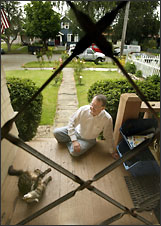
James Gaylord on the porch of his Tacoma home in 2004,
the exact spot where he was fired in 1972 when his Vice Principal
simply asked him if he were Gay and he responded, "Yes".
Paul Lynde, the campy comedian of Bye Bye Birdie, Bewitched,
and Hollywood Squares fame, was arrested outside the Sun
Tavern (a Salt Lake City Gay bar) on January 11, 1978, for
interfering with a police officer. The drunk and mean-spirited Lynde
had been in the gay bar drinking and had returned to his limousine
with a man he had met in the bar, only to find that his car had been
broken into and his brief case was missing. Police officer Scott
Candland was already in the area investigating another complaint
about vehicle vandalism at the Gay bar, when he was accosted by the
drunken Lynde, who tried to coerce the cop into looking for his
briefcase. Candland arrested Lynde (a charge for public intoxication
was dropped) and he spent three hours in Salt Lake City jail before
posting his $50 bond. His arrest was publicized in the Salt
Lake Tribune on the January 12th, and in the New York
Times on the 13th. A favorite guest on the Donny and
Marie Show, Lynde contacted the Osmond matriarch, Olive
Osmond, to secure bail for him in Salt Lake. Unfortunately, the well
publicized scandal of his being arrested at a Gay bar caused the
Osmonds to fire Lynde from the show. [120]
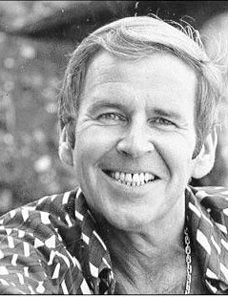
Paul Lynde, arrested outside Salt Lake Gay bar,
then fired from the Donny and Marie Show
As reported in the June 1978 issue of Sunstone, a Mormon
living in San Jose, California named Richard Harrington became
chairman of the "Citizens Committee Against Gay Pride Week". In
March 1978 he had informed the San Jose City Council, "We do not
want San Jose recognized as a city which honors homosexuals, and we
do not want San Jose to become a symbol of sexual deviation."
Harrington told the city council his group represented sixty
churches with 60,000 members and presented a petition signed by
30,000 people protesting the city's approval for "Gay Pride Week" in
June. The city council obliged by rescinding the Gay Pride
resolution, but then in a stunning reversal designated the week "Gay
Human Rights Week" instead. Vice-Mayor of San Jose Susanne
Wilson reported that she was "grieved" at the "animosity expressed
in letters" she received from Mormons and other Christians "who
opposed the special-week proclamation". That same summer, a Mormon
police officer in Seattle, Washington named David Estes began a
voter initiative to repeal Seattle city ordinances protecting
employment and housing for Gays and Lesbians. Estes told voters that
"as a priesthood holder in my church, The Church of Jesus Christ of
Latter Day [sic] Saints, or the Mormon Church, I have the obligation
to say what's right whether or not people listen." In a chilling
statement to the press, Estes stated that he believed that those
convicted of sodomy should be "given mental health care at state
expense, voluntarily if they agree, involuntarily if they do not".
Besides repealing protective ordinances, the proposed initiative
would also "forbid any government agency or any agency that receives
government support of any kind, from advocating rights for sexual
minorities." The initiative was strongly supported by "avowed
Christian fundamentalists" and leaders from the ultra right-wing
John Birch Society (which had strong ties to Mormon Apostle Ezra
Taft Benson). On November 7, 1978, the anti-Gay initiative was
soundly defeated with 64% of Seattle voters opposed to it. David
Estes would attempt to pass a very similar initiative again in 1980,
and again would be defeated. [121]
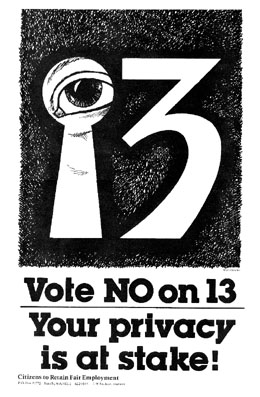
Walt Crawley's poster opposing Mormon sponsored anti-Gay
"Initiative 13" in Seattle
.
The Equal Rights Amendment and
the International Women's Year (IWY) conference in Salt Lake City
The same month that the Salt Lake Human Rights Convention was held
(during which Affirmation was founded), Mormon feminists were also
taking the LDS church to task for not supporting the Equal Rights
Amendment (ERA) to the US Constitution. The LDS church used the
homophobia it had spawned among its members over the previous decade
to help defeat the ERA nationally; and in turn, these homophobic
tactics galvanized and radicalized many Mormon Lesbians. While the
initial October 1976 statement from the First Presidency on the ERA
made no mention of homosexuality (only that passage of it might
"bring ambiguity"), within a year fears of endorsing homosexuality
and a "unisex society" were cited frequently by Mormon leaders as
reasons to oppose it. 22 October 1976-The LDS First Presidency
issued a statement against ratification of the Equal Rights
Amendment to the U.S. Constitution saying "We fear it will even
stifle many God-given feminine instincts." The first Presidency
stated its first objection to passage of the ERA fearing "an
increase in the practice of homosexual and Lesbian activities, and
other concepts which could
alter the natural, God-given relationship of men and women." [122]
Dr. Jan Tyler, a BYU professor, became chair of the state
conference held for International Women's Year, in Salt Lake on June
24, 1977. While some 3,000 women were expected at the state-wide
event, some 10,000 actually showed up because the LDS church had
sent word through its women's auxiliary organization, the Relief
Society, for every Mormon woman in the state "to attend the meeting
and vote against every proposal offered". Debra Burrington, a
still-closeted Lesbian graduate student at BYU and intern for LDS
Welfare Services, had been asked by her boss to attend. It was
during the conference that Burrington saw her "first actual
lesbian", who was there attempting to pass out copies of Salt Lake's
first Lesbian newspaper. However, her "over-the-top butchiness
[Lesbian masculinity], the lavendar arm band and the word 'lesbian'
in the title of the newspaper caused most of the people to whom she
offered it to recoil in fear".
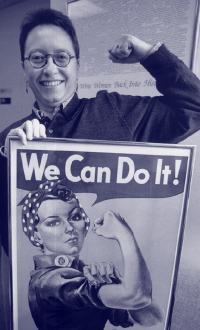
Dr. Debra Burrington, LDS Lesbian and IWY attendee
Burrington noted that besides the hordes of right-wing LDS women at
the conference, the John Birch Society had also shown up both with
walkie-talkies and "a prepared list of the 'approved' candidates who
should be voted as Utah's delegation...in Houston". Of course all
proposals regarding women's right to choose and homosexual rights
were easily voted down. However, when a proposal to promote world
peace came up, Burrington voted for it, and was struck in the back
of the head with the purse of a woman from Utah County who was
sitting behind her. Burrington writes that "I can still smell the
fear emanating from her, the fear that her world would come to an
end if a single one of these proposals made it out of the meeting".
The IWY conference in Utah "has always held the distinction of being
the only state-level IWY meeting that voted overwhelmingly against
every proposal that had been made by the guiding task forces".
Burrington and a number of other Utah and Mormon Lesbians I have
known through the years were galvanized by the unethical tactics
used by Mormons at the conference. Burrington wrote to me that
"International Women's Year was a radicalizing and damaging
experience for a lot of women...but I didn't come out as a lesbian
unil another year and a half alter. I was still afraid that I
couldn't be both a Momron and a feminist at that point, and IWY
solidified, for me at least, that the two identities are
fundamentally incompatible." It was also "a given that if feminism
and Mormonism are incompatible, that lesbianism and Mormonism exist
even farther apart". Another "actual" Lesbian at the event was
another BYU graduate student who was chair of two of the largest
task forces for the IWY conference. She and Burrington only met many
months later, but what brought them together first as friends, and
later as lovers, "was the anger and pain both of us felt in the wake
of IWY". Thus like the mythological Phoenix, out of the ashes of
"damaging" events like these, great things are born. As Burrington
queries, "Do conservatives understand that their foaming at the
mouth often has an effect opposite to what they intend? Some
of us may spend years in fear of disapproval and of being foisted
from our communities, but even more of us recover and go on to fight
another day, to fight even better than before, to forge new paths,
new ways of being family to one another, and discover even more
creative ways to make fabulous lives together." (Debra Burrington
went on to teach Women's Studies at the University of Utah in the
late 1980s and early 1990s, where I had the immense pleasure of
taking classes from her, as a double-major in History and Women's
Studies myself. Her "Introduction to Women's Studies" course forever
changed and improved my life and the lives of every student in that
class. She and I have maintained a solid friendship over the years
and both live in California currenlty.) According to church
spokesman, Jerry Cahill, "homosexuality has become an issue
recently...with International Women's Year", "discussions have
pointed to that problem." Subsequently the church reissued its
earlier edicts against homosexuality to all priesthood leaders,
reminding them of the church's "firm stand". Cahill also promised
that "there's no end to the things that the Church will do to
assist" church leaders in counseling LGBT Mormons.[123]
At the national IWY conference held in Houston, Texas in November
1977, members of the press received a packet of official press
releases as they received their credentials, originating from the
U.S. Commission on the Observance of International Women's Year,
indicating that the LDS Church was part of a "radical right-wing
group" that had tried to "take over and distrupt the state IWY
conferences". Others in this alleged radical, anti-feminist group
were the Ku Klux Klan, the John Birch Socity, Ciitizen's Forum,
Conservative Caucus, coalitions of fundamentalist churches, and
Right to Life. [124]
Also in 1978, the First Presidency issued a lengthy statement
opposing the proposed Equal Rights Amendment (ERA).
|
|
|
|
|
|
1978 Pamphlet cover and excerpt
(Click on images to enlarge)
|
1979 Relief Society Pamphlet
(Click on images to enlarge )
|
.
Preying upon the homophobia of church members, the church's
official statement claimed that passage of the ERA would bring about
an "encouragement of those who seek a unisex society, an increase in
the practice of homosexual and lesbian activities, and other
concepts which could alter the natural, God-given relationship of
men and women." These and other anti-Gay phobias were reiterated in
subsequent anti-ERA propaganda published by the church in 1979 and
1980. In June 1979, AP reporter David Briscoe interviewed Mormon
President Spencer Kimball on the ERA and noted in a subsequent
article for Utah Holiday that his "personal impression
after the interview was that the 'homosexual issue' is a major
factor in President Kimball's opposition" to the amendment.
This fear of a "unisex society" lies at the core of Mormon
homophobia, for the hierarchy has a vested interest in keeping
gender lines firmly drawn. Any blurring of those lines, any
weakening of gendered activities, places Mormon men in a locus where
they can only lose power, authority, and prestige. As the First
Presidency wrote in 1991 in an anti-Gay letter to the entire church,
"A correct understanding of the divinely appointed
roles of men and women will fortify all
against sinful practices" such as "homosexual and lesbian behavior"
(emphasis mine). [125]
Mormon men fear the "homosexual within". If church leaders believe
that homosexuality is contagious and the entire world can "convert"
to homosexuality as easily as to Mormonism, then they must include
themselves in that conversion. Spencer Kimball, in New Horizons
for Homosexuals asked readers to "imagine, if you can, the
total race skidding down in this practice...just one generation of
gratification of lusts and the end." Furthermore, "where would the
world go if such a practice became general? The answer: To the same
place other unbridled civilizations have gone."[126]
Earlier, Kimball proclaimed that "if the abominable practice became
universal it would depopulate the earth in a single generation".[127]
Mormon bishop T. Eugene Shoemaker ironically denied the idea that
homosexuality is a "crime against nature", going so far as to argue
that "homosexuality is wrong, not because it is unnatural, but
rather because it is too natural, and
unless the human species changes utterly, men and women will
continue to choose freely to do evil".[128] I
get a sense from these statements that Mormon leaders believe that
they have such fragile and weak sexual identities that the slightest
nudge might send them careening "over the edge".
At the same time, Mormon leaders are aware that homosociality
(which they vigorously participate in) is very closely aligned to
homosexuality on the "homo-continuum". Just four days before
Christmas 1977, LDS therapist and Values Institute member Victor L.
Brown, Jr. told Duane Jeffrey of a "recent case of a man (a bishop?)
who with his wife came to Utah to get help in overcoming his
homosexuality: there were times when he felt so good, so fond of
other men that he wanted to hug them to express it. He was repulsed
by any suggestion of sexual involvement, however!" Brown explained
to this man that the General Authorities of the church "so hugged
each other at [general] conference, sometimes for rather long
periods of time, that this was not homosexuality at all!! The man
left, and his wife [was] very relieved and enlightened. Six months
later [Brown] got a letter from them saying what a tremendous
difference it had made to him to realize that these feelings of
genuine love and rapport were normal and not homosexual! The
man's guilt burden had been totally lifted."[129]
Brown, also addressing the church's awareness of female
homosociality, said that "it is fairly common to find women who are
turned off by the male society, and who find friendship and
companionship from another female, but between the pair there is
absolutely no sexual situation at all, just companionship. [The]
Church is aware and sensitive to this; the [definition] of
homosexuality [in church manuals?] has been 'carefully re-worded' to
try to steer around this, the word 'relations' was changed to
'relationships' for this reason". Brown indicated that the "gospel
ideal" of the male gender role actually "has many feminine
qualities" because a Mormon man "should be tender, loving, gentle,
etc., [which] implies femininity". Brown believed that a "male does
not give up his masculinity when he behaves this way", and society
"must get rid of idea that to be male a male must be aggressive,
brutal, pugnacious, possessive."[130]
During the "Gay Pride Week" activities held in Salt Lake City on
June 24 and 25, 1978, a seminar was held called "Religion and the
Gay Person". Discussion centered aroud "guilt feelings many
homosexuals experience because of fears of losing their salvation".
Rev. Robert Waldrop said that "many of the gays in the audience were
members" of the Mormon Church "and had been on missions or through
the temple." He added that "those who had that kind of commitment
experience the guilt far stronger than Mormons who had not". He
encouraged Gays to "liberate ourselves", feeling that we Gays can be
"our own worst oppressors". [131]
A 21 year old Gay Mormon who was on his mission wrote a touching
letter to the editor of the Open Door in September 1978,
describing his "surrender" to his sexuality despite Kimball's
"damnation" of it:
I have adhered to and lived by the Church's counsel and
guidelines most of my life, while at the same time being tormented
by something inside me that countered some of the Church's most
steadfast rules. Something that defied change and quietly but
stubbornly rebelled against everything that it was claimed to be
by President Kimball in his seemingly endless and merciless
damnation of it. Something that has caused me endless nights of
lost sleep and endless days of struggle, denial, guilt and tears.
Something defined as homosexuality.
I suppose I am, and have been for a number of years (if not
always), a homosexual.
The events which led up to my going on a mission for the Mormon
Church are another chapter entirely. Perhaps, as much as anything,
it was hope and faith which harboured the rationale of 2 years
devoted service to the Lord in exchange for the withdrawal of that
something which President Kimball never failed to blacklist.
If I have accepted my sexuality, it has not been out of defiance,
pride (or shame), adventure, or understanding. Merely surrender.
After years of hope, prayer, faith, work, and unending anguish, I
cannot go on playing Don Quixote fighting a windmill for which
there is no conquering. However, my surrender is by no means
resignation to the bleak and sordid lifestyle which the Church
paints as a future for the homosexual. I believe in myself and all
the blessings and opportunities of life which have been given me
and I intend to make the most of my life and talents regardless of
the sex of the person I share that life with. I am a man and I
respect the male race for what it is and what it should be and I
am proud to be a part of it. I expect the same from any other
male.
Finally, for just exactly what I am writing, I cannot say.
Perhaps for hope. An understanding, through experience, of the
very real dilemma which we face. Perhaps for an alternative
solution to the one which the Church offers. Perhaps I write
simply for the comfort of knowing that there is, out there
somewhere, someone else with the goals, aspirations and the
optimism for life that I feel. [131A]
One month after this heart-wrenching letter was published, members
of Salt Lake's Gay community, weary from constant police harassment,
began a concerted campaign to end it through legal pressure. Sgt.
Harkness of the Salt Lake Police Department had recently been quoted
in a Salt Lake Tribune article as stating that "there are
10,000 practicing open homosexuals in the Salt Lake Valley and if
any local officers need practice in busting homosexuals, this is an
ideal training ground." A Deseret News article of July 29,
1978 suggested that "if Homosexuals were removed" by the police from
active participation in society, the current epidemic of venereal
diseases circulating in the country "would virtually clear up".
The Gay community also protested the selective and "excessive"
police enforcement of public nuisance and public intoxication
statutes. Gay bars were constantly and regularly targeted by police
while straight bars with much worse public intoxication problems
remained untargeted. Mel Stuck, head of the liquor control tactical
squad, allegedly entered the Radio City Lounge (the oldest
continuously operating Gay bar west of the Mississippi, open on
State Street since the 1940s) and told the bartender on duty, Larry
Pacheco, "you must not like working very much or else you would find
a job anywhere else, because I'm going to nail the damn doors closed
if it's the last thing I do." Similar threats were also received by
staff at the Sun Tavern. The Gay community formally appealed to the
the local chapter of the American Civil Liberties Union to assist
them in fighting these policies. [131B]
As the Salt Lake community geared up to end police harassment, Gay
men in San Francisco decided the time had come to share a message of
acceptance and advocacy of homosexuals through music. In October
1978, 115 Gay men met for the first rehearsal of the San Francisco
Gay Men's Chorus, the first such musical group in the world. One of
the men at the first rehearsal was Gerald Pearson, a Gay Mormon
originally from Utah. Carol Lynn Pearson records in Goodbye, I
Love You that "Gerald learned that a group was forming called
the San Francisco Gay Men's Chorus. He immediately joined." Carol
Lynn went to their premiere on December 20, 1978, for a beautiful
and profoundly moving Christmas concert. After the performance
Gerald introduced his ex-wife to a man named Tom who had been a
Mormon bishop until 1977 and now was a member of the Gay men's
choir. Gerald humorously informed Carol Lynn that "there's a whole
group of us [Mormons] in the chorus. We're sort of the Tabernacle
Choir section." Leonard Matlovich, the
famous Gay ex-Mormon Air Force Sergeant, was also a member of the
Gay Men's Chorus in its infancy.
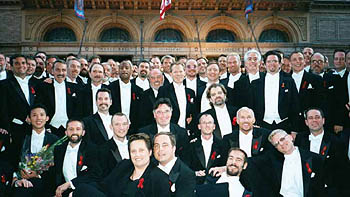
The San Francisco Gay's Men Chorus, 2003
Carol Lynn reports that "the San Francisco Gay Men's Chorus became
his home" and in 1980 Gerald Pearson became co-chairman of the
choir, mainly responsible for fundraising and scheduling concert
halls. The chorus soon began preparations for its first national
tour in June 1981. The chorus became Gerald's "mission, his hope,
his gift to the world....It would build bridges, Gerald was certain.
It would help destroy prejudice." Despite bomb threats and strikes
by the teamsters who refused to deliver the programs for the
performances, "reviews were glowing, opinions were changing,
families were being reunited." Fourteen choruses were immediately
formed across the country as a result. In 1982, thirteen Gay men in
Utah formed the Salt
Lake Men's Choir, which is now comprised of fifty singers and
has gained a wonderful reputation and become a staple in the musical
landscape of the intermountain west. Tragically, 42 year old Gerald
Pearson died from AIDS in his ex-wife's arms in 1984. Carol Lynn
Pearson's 1986 publication about her husband's life and death in Goobye
I Love You is perhaps the single most important event in the
history of homosexuality and Mormonism. Her account finally softened
the hearts and opened the minds of so many Mormons that its
significance cannot be underrated. [131C]
"ACCIDENTS OF NATURE"? - MORMON
DOCTRINE & TRANSGENDERISM
The LDS Church's stance opposing transgenderism, transsexuality,
and transvestism is clear: Spencer W. Kimball twice made uninformed
remarks disparaging transsexuality in 1974. At BYU on September 17,
1974, Kimball gave an address called "Be Ye Therefore Perfect"
(which he also delivered to the University of Utah Institute of
Religion on January 10, 1975) in which he stated that "we're
appalled to find an ever-increasing number of women who want to be
sexually men and many young men who wish to be sexually women. What
a travesty!** I tell you that, as surely as they
live, such people will regret having made overtures toward the
changing of their sex." At October General Conference that same
year, Kimball gave a speech entitled "God Will Not Be Mocked" in
which he claimed that the "high purposes of life are damaged and
destroyed by the growing unisex theory. God made man in his own
image, male and female made he them. With relatively few
accidents of nature, we are born male or female. The Lord
knew best. Certainly, men and women who would change their sex
status will answer to their Maker." Here Kimball makes some room for
intersexed people (those born having reproductive organs and/or the
chromosones of both sexes - his "accidents of nature") but those who
know that their external sex does not match their internal sex are
at cross-purposes with God, in his view.
[**N.B. Humorously the word "travesty" comes from
"transvestite", although I doubt Kimball knew this.]
Victor L. Brown Jr., DSW (son of the Presiding Bishop who kicked
the Salt Lake Human Rights Convention out of the Hotel Utah in 1977)
reported the following story at the first convention of the
Association of Mormon Counselors and Psychotherapists (AMCAP) in
1975:
I had a unique experience in this regard with a person who wished
to have an operation to change his sex. He was a returned
missionary, a father, and an extremely capable, talented
individual. He went to President Kimball and spent many sessions
with him....and over a period of several months to other church
leaders throughout the western United States. It was quite a saga
as he went from community to community seeking answers. He
indicated that he had been obsessed with these attitudes, although
he had never acted out, over the majority of his lifetime. When I
met him he told me his story of 25 or 30 years of struggling with
this issue. I was sort of overwhelmed with what a great fellow he
was. I thought it showed tremendous strength to have never given
in. He finally reached the crisis point where he just couldn't
continue any further. His wife had divorced him. He had lost his
children and he was broke. He was a high living person which hurt
him a lot. He was, at that point, where he had to do something.
So President Kimball, in his special Christianity, arranged for a
blessing from President Lee [Harold B. Lee, President of the LDS
Church from mid-1972 until his death in December 1973], and I was
privileged to be part of the circle. But before President Lee gave
the blessing he spent twenty minutes rebuking the man in a kind
but firm way. I confess, I sat there and thought, "President Lee,
you don't understand. This is a strong fellow. He made a
magnificent effort." I was bright enough, though, not to say
anything. Then President Lee gave the blessing and rebuked him a
little further. It was a beautiful blessing. He made specific
promises. Then we went up to President Kimball's office and
President Kimball gave him specific instructions. President
Kimball didn't interfere with his free agency. He said, "I'll be
able to help you if you will do these several things," and he
listed them.
While I was there, President Kimball called a stake president in
another city and arranged for an appointment for that man. As we
were leaving President Kimball's office, I was still a little
concerned about President Lee's approach. However, I watched this
man over the next 3 years and I watched his former wife's life and
the children. I came to know her very well. They were from another
state, but circumstances brought us together. I found, of course,
that President Lee was inspired; he was absolutely correct. This
man had put up what might be called a commendable struggle, but he
was so turned inward and had become so self-focused that he could
not think of anyone else but himself. And then a lot of other
things began to make sense. I helped him move once, and I had
helped him pack his clothing. He wore clothes that I could never
afford. His indulgence in himself in every way was total to the
exclusion of his very attractive and loving wife and his lovely
children - to the exclusion of any consideration, frankly, except
his need to assume the woman's role, so that he could be taken
care of. He had no real homosexual tendencies. He was just
self-centered. There was no psychological or emotional
justification for the change of sex, and President Lee had seen
that as an inspired Priesthood leader. [131D]
As with Brown's reaction noted here ("he had no real homosexual
tendencies"), Mormon authorities consistently have conflated
homosexuality and transsexuality, often speaking about "gender
confusion" when addressing homosexuality, or, like Brown, they
inaccurately speak of a transsexual's "homosexuality".
Three years later, on March 5, 1978, Boyd Packer gave his "To
the One" speech at a BYU fireside. Although the speech was
mainly on homosexuality, he did briefly diverge into the topic of
transsexuality, unleashing strange and unfounded theories about its
etiology and development (and, as usual in Mormon rhetoric,
conflating it with homosexuality), especially invoking narcissism:
It is normal for a male to want to become more masculine, or for
a female to want to become more feminine. But one cannot
increase masculinity or femininity by deviate physical contact
with one of his own gender. There are many variations of
this disorder, some of them very difficult to identify and all of
them difficult to understand. When one projects himself in
some confused role-playing way with those of the same gender in an
effort to become more masculine or more feminine, something flips
over and precisely the opposite results. In a strange way,
this amounts to trying to love yourself.
A male, in his feelings and emotions, can become less masculine
and more feminine and confused. A female can become, in her
emotions, less feminine and more masculine and confused.
Because the body cannot change, the emotional part may struggle to
transform itself into the opposite gender. Then an
individual is on a hopeless, futile quest for identity where it
can never be achieved.
There is even an extreme condition in which some individuals, in a
futile search, will undergo so-called “change” operations in an
effort to restructure their identity and become whole. Do not
even consider that. That is no answer at all! That has
eternal, permanent consequences. If an individual becomes
trapped somewhere between masculinity and femininity, he can be
captive to the adversary and under the threat of losing his
potential godhood. (pp.
7-8)
In 1979, a wealthy Mormon Elder (having been a missionary in
Argentina) in his mid-30s and living in Orange County, California
decided to undergo gender reassignment surgery to become a woman,
calling herself Kristi Independence Kelly. She was subsequently
excommunicated from the LDS Church, although she fought this at
every level. One biogrpahy of Kelly, written by a friend named Kay
Brown - herself a transsexual - claims that Kristi Kelly owned a
financial company called the Sunshine Group, employing some 500
people, many of whom were Mormons. After getting a separation from
her wife, Kristi fell in love with another transsexual named Liz
Thomas and Liz was hired to be the Director of Advertising for the
Sunshine Group. Taking advantage of the church crisis brought on by
the feminist movement of the late 1970s, Kristi threatened to start
a "feminist branch" of the Mormon Church "and take her many
supporters with her", althought this alleged threat never
materialized. At the same time, Kristi's ex-wife refused to allow
Kristi to see their three daughters so Kristi took the matter to the
courts. Unfortunately in June 1980 Ms. Kelly lost the case and she
was not allowed to see her daughters again, because, as a friend of
hers noted, the court felt that Kristi, "as a transsexual person, is
now unsuitable as a parent because she deviates from the 'accepted'
norms of parenthood in the father role." However this didn't stop
the court from assessing her $25,000 a year in child support. Kristi
then became "a prominent cultural figure in the Hollywood scene".
One month after her excommunication, Kristi, an accomplished pilot
who owned her own corporate plane, died when the plane she was
piloting crashed in northern California. Another transsexual onboard
(apparently not her partner Liz) also died in the crash. Members of
the Los Angeles transsexual community immediately began circulating
rumors that Danites (an early Mormon secret paramilitary vigilante
group, which almost certainly no longer exists) had assassinated
her, since some of her plane mechanics were allegedly faithful
Mormons upset by her growing dissidence and apostacy. While I
strongly doubt the current existence of Danites, in recent years
Mormons Lance Wood and Russell Henderson have tortured to death Gay
men (Gordon
Ray Church, and Matthew
Shepard respectively) in horrific hate-based crimes. In
addition, Tracy Val Kendrick and Shayne E. Rhodes, two large teenage
LDS football players from Logan, Utah, also nearly beat to death
bisexual Utah State University student Harold Dean Hawker (who
weighed less than 120 lbs) with their fists and boots in 1989,
leaving him naked in a gravel pit parking lot in the middle of
winter. Hawker's hypothermia saved his life although he suffered
severe skull fractures, some brain damage, a crushed eye socket, and
punctured lungs from the beating, resulting in over $125,000 in
uninsured medical bills. (Incidentally, the LDS church
excommunicated Hawker for his bisexuality, but not his assailants
for their brutal crimes against him.) The two youths only served
three-year sentences for their heinous crimes. Therefore while the
Danites might no longer exist, the accusations that Kristi Kelly
died as a result of "rogue" Mormon intervention may have some truth
to them. [132]
ANTI-HOMOSEXUAL POLICIES AT BYU (1957-1980)
Meanwhile, problems had been brewing at Mormon-owned Brigham Young
University because private policies developed during the late 1950's
through the 1970's began to receive public criticism both by
students and the national press, influenced in part by the rise of
the Lesbian and Gay liberation movement. BYU's response to
homosexuality is important for several reasons: its large (and
surprisingly open) Gay and Lesbian population; its semi-open
bureaucracy which has allowed selected important documents
concerning homosexuality to surface for the public; and the tension
created by religion and academia which provides interesting (and
recently, traumatic) dilemmas for the people who work, teach, and
study there. Close examination of policies, practices, and attitudes
regarding homosexuality at BYU reveals the homophobic mechanisms
which were created, reproduced, modified, and sustained (even when
unethical and/or illegal) by church and university leaders,
sometimes even at the expense of great criticism from external
sources. BYU and church administrations have operated behind doors,
carefully and deliberately attempting to eradicate "the Queer
experience" without even once challenging the supposition that
homosexuality (desire and/or practice) might not be an illness,
abnormality, sin, or crime at all. Because Mormon apostles comprise
BYU's board of trustees (with only one or two exceptions), the
attitudes of the church hierarchy directly affected BYU's policies.
However, because BYU is also an academic institution where free
enquiry is encouraged, at least in principle, the school's policies
on homosexuality have changed over the course of time. Thus BYU has
in turn influenced the church's position on homosexuality like no
other "outside" institution.
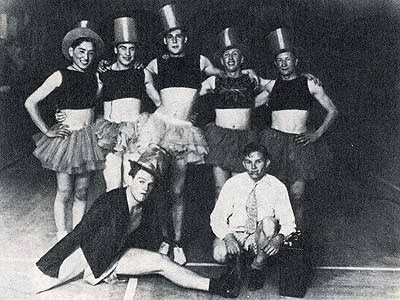
Drag Burlesque by BYU Social Unit, ca. 1930
Prior to the 1950s, Gay life at BYU was surprsingly open and
unrepressed. Lesbian, Gay, and Bisexual students and faculty enjoyed
good rapport with each other and relatively healthy amount of
freedom in their lives. Earl B. Kofoed, a Gay student at the"Y" from
1946-1948, has reported extensively on the social network that
thrived on campus for LGB people. Both women and men formed a
tightly-knit group, the women from athletics and social work, and
the men mainly from the campus French Club. Kofoed reported to me in
a 1989 interview that Dr. Leona Holbrook, the first Chair of the
women's Physical Education Department at BYU (serving from
1937-1975, died in 1980), was a Lesbian active in this social group.
Holbrook was an extraordinary individual who was extremely
well-respected at BYU, and received numerous international honors
and awards for her contributions to athletics in higher education
(especially for women). Among her many honors, Holbrook was the
first woman ever appointed to the Board of the US Olympic Committee,
and was voted Woman of the Year at BYU for three years. She still
ranks as one of the top ten best professors ever to teach at the Y.
Her enduring legacy is witnessed by the annual "Leona Holbrook
Spirit of Sport Award" given to one senior female athlete on campus
who exemplifies "the true spirit of sport in athletics and life". [Click
here for a brief biography in PDF of this extraordinary Mormon
Lesbian.]
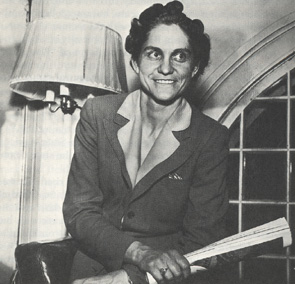
Dr. Leona Holbrook of BYU wearing 1940's "Lesbian chic"
[Click for larger image]
Earl Kofoed also informed me that the group received a
semi-official nod from LDS church president George Albert Smith,
when two of their number, Kent Goodridge Taylor (1925-2002) and his
lover Richard Snow, met with Smith in the Spring of 1948. President
Smith merely told the two men to live their lives together honorably
and God would accept them. They eagerly reported this strong
affirmation of support to the group, bringing them all even closer
together. Unfortunately this time of a Gay "Camelot" at BYU was all
too brief and the advent of the 1950s would bring a severe change to
the campus. (I also report here that Jay Bell, who worked with
"Affirmation: Gay and Lesbian Mormons" on amassing archival and
bibliographic materials on homosexuality and Momronism, reportedly
found that in 1951, "the editor of BYU’s student newspaper wrote
of members of 'a small group of homosexuals,' including a
president of the LDS married branch, and a star basketball player",
as quoted at http://www.utahstonewallhistoricalsociety.com/welcome_files/Page1685.html)
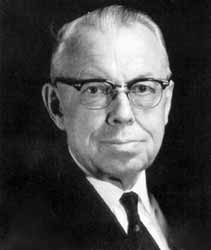
BYU President Ernest L. Wilkinson
Arch-homophobe
The single person most responsible for the harsh, discriminatory
campus environment that began at BYU in the 1950s was Ernest L.
Wilkinson, a rabid anti-Communist and arch-conservative lawyer, who
became BYU president in October 1951. He could be a vicious and
tyrannical man (he himself admitted that he was "too blunt, not
tactful with people, and impatient"), disliked by many of his
faculty (who pejoratively called him "Ernie the Attorney" behind his
back), and who especially delighted in humiliating women, harping ad
infinitum on the length of their skirts. He was notorious
for giving bone-crushing handshakes to young female students,
bringing them to their knees in pain, as over-compensation for his
extremely small stature. A child of his vice president Earl Crockett
recounted to me in 2002 that sometime around 1970 Wilkinson and then
church president Harold B. Lee were at a formal dinner in Hawai'i.
Wilkinson held out a chair for his wife, Alice, to sit on, and then
as she started to sit, as a "joke" he pulled the chair out from
under her so that she hit the floor and was thoroughly humiliated in
front of all those important people in attendance. President Lee was
"horrified and held it against him forever afterward" and Wilkinson
in essence hit a "glass ceiling" with the church. When Wilkinson
left BYU in 1971, the well-known lawyer expected to help set up the
new J. Reuben Clark Law School on campus, but instead he was asked
only to write a centennial history of the school. Wilkinson
therefore privately retained three out of five of his BYU
secretaries to help him write his memoirs and to keep
"track of all the dirt on the general authorities that could be
unearthed", ostensibly to help advance his own "career". Wilkinson
obviously learned the power of keeping exhaustive files on his
"opponents" during his years at BYU baiting homosexuals. While
subsequent BYU presidents have later become General Authorities,
Wilkinson tellingly never joined their ranks.[133]
Another large role in the persecutorial campus atmosphere was
certainly played by the BYU Security Office. That office's first two
chiefs, Leonard E. Christensen (from 1952 to 1961) and Swen C.
Nielsen (from 1961 to 1974) had come to BYU from the Los Angeles
Police Department. (Nielsen's successor in 1974, Robert W. Kelshaw,
was a local man and graduate of BYU but had started his career as a
Military Policeman at the age of 17.) The LAPD during their time in
service (the 1940s to early 1960s) was nationally notorious for
their illegal, immoral, and unethical persecution of Gays in the Los
Angeles area. Members of the LAPD routinely harassed and entrapped
Gays, made thousands of unwarranted arrests, refused to acknowledge
the constitutional right for Gays to assemble, and on at least one
occasion beat an unarmed, unresistant Gay man to death in front of
several witnesses (but were not held accountable for it). These
actions prompted Gays in southern California to become more
radicalized than elsewhere in the nation, forming the country's
first Gay liberation ("homophile") organization in 1948 (the Mattachine
Society), the first Gay news magazines, and organizing
protests and encouraging rioting, specifically in response to LAPD
harassment. LA police entrapment also prompted California Gays to
take their cases to trial, leading to the first ever Gay legal
victories in US courts. News of this pioneering resistance spread
across the country and abroad, and laid the foundation for the
modern international Gay rights movement. In like manner, the
unethical means used to persecute campus homosexuals at BYU by the
administration in general (and LAPD-trained Security in particular)
led to increasing acts of personal, political, and ecclesiastical
resistance. Campus Gays then began to organize collectively and so
experienced a deepening sense of "community" with other LDS
homosexuals in the same situation that is still felt in Utah and
throughout the LDS Church today.[134]
In 1957, a Gay Mormon named David
Chancellor Martin entered BYU as an undergraduate student. He
soon discovered that his homosexuality "wasn’t isolated, but a
universal practice, found everywhere, even in Provo at BYU". In an
autobiographical letter he wrote in 1982, Martin explained that in
1957 "the basement of the old Grant Library [on the BYU campus] was
an active meeting place for gays, frequented by students, faculty
and townsmen alike." By 1958, Martin had made about a dozen close
Gay friends at BYU who were all students (and knew several more gay
faculty members). Eventually most of them were "outed" (including
Martin) by another Gay student. Martin reports that "we all had to
go see Brother [Kenneth A.] Lauritzen [head of University
Standards], we all 'repented' and were much more cautious after
that." Soon thereafter Martin writes that the Gay student "who
had 'snitched' on us...was mysteriously beaten one night on campus,
and dropped out of school." By the summer of 1959 these dozen Gay
men had all left BYU for missions to Australia, New Zealand, Brazil,
Denmark, and other countries, but they all kept in touch by mail,
exchanging both typical "inspirational missionary stories" and
"information on gay life we managed to find there" in the countries
where they proselyted. [135]
On May 21, 1959 BYU president Ernest L. Wilkinson met with the
executive committee of trustees. He asked the committee "whether the
Dean of Students should send questionnaires to bishops asking
whether students had a propensity for stealing or immorality or
anything of that kind", effectively breaking the confidentiality of
the confessional; and he also wondered about "the growing problem in
our society of homosexuality".[136] Wilkinson
recorded that "these two problems interested the Brethren very, very
much" and that church president David O. McKay had recently voiced
"his view [that] homosexuality was worse than immorality; that it is
a filthy and unnatural habit." Wilkinson was instructed that unless
homosexual students were "really repentant and immediately working
out their problems", the school "should suspend them".
Administrators then wondered if they should record on transcripts
that the student had been expelled for homosexuality. The executive
committee recommended avoiding the possibility of law suits and so
no such notation would appear. Wilkinson was also told to come up
with a "better plan to find out from bishops the information
requested by the Dean of Students." Although progress on Wilkinson's
questionnaire was temporarily halted, he would eventually receive
permission to implement it.
President Wilkinson and Vice President Earl C. Crockett on May 17,
1961 interviewed Carl Fuerstner (a non-Mormon, 1912-1994), who had
been professor of music (piano) at BYU and had been terminated some
weeks earlier by Crockett merely for suspicion of being Gay
(although Fuerstner was not informed of the reason for the
termination). Wilkinson had heard that Fuerstner was being openly
critical of the administration for firing him, so Wilkinson wanted
to interview him to get a confession out of him to justify the
firing. After more than an hour of being drilled by both Wilkinson
and Crockett, Fuerstner finally admitted he was Gay but had not
acted on his sexuality while teaching at the Y. Wilkinson smugly
concluded in his journal that night, “we will have no further
trouble with him over his dismissal because he does not want any
publicity over the matter any more than we.” Earlier that same year,
Dr. Fuerstner published his "'Valse' from Little Dance Suite,
Opus 39" in BYU Studies (3:2:50). Fuerstner went on
to become conductor and opera coach at the Indiana University School
of Music and the Bloomington Symphony Orchestra from 1981 to 1987.
He also composed the opera Berceuse and trained the opera
divas Jessye Norman and Ghada.
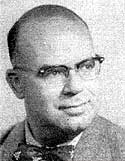
Carl Fuerstner, non-Mormon Gay music professor at BYU
Terminated and harassed by Wilkinson
On September 12, 1962 Wilkinson, himself a lawyer, met with the
school's general counsel, Clyde Sandgren, the new Dean of Students,
J. Elliott Cameron, and apostles Spencer Kimball and Mark Petersen
"on the question of homosexuals who might possibly be a part of our
studentbody". They decided that the number of homosexuals on campus
was "a very small percentage of the whole" and therefore
administrators "ought not to dignify it by meeting with the men or
women of the university in a [public setting] but handle each case
on its own." They then worked out a cooperative plan whereby Mormon
general authorities and other church administrators would give BYU
any information they obtained about homosexuality on campus, and BYU
would give church administrators information about homosexual church
members. They decided "as a general policy that no one will be
admitted as a student at the B.Y.U. whom we have convincing evidence
is a homosexual."[137]
However BYU started finding more homosexuals on campus than
initially anticipated. First, Apostle Spencer Kimball felt compelled
to condemn homosexuality in his "Love versus Lust" address to the
assembled studentbody on January 5, 1965. Then in the fall of that
year, Ernest L. Wilkinson reversed the decision of 1962 and finally
went public with anti-Gay policies during an address to the student
body. As part of his speech hypocritically titled "Make Honor Your
Standard", Wilkinson indicated that BYU does not intend "to admit to
our campus any homosexuals. If any of you have this tendency and
have not completely abandoned it, may I suggest that you leave the
university immediately after this assembly; and if you will be
honest enough to let us know the reason, we will voluntarily refund
your tuition. We do not want others on this campus to be
contaminated by your presence."[138] By
resorting to the metaphor of viral contagion, Wilkinson voiced his
own - and presumably others - fear of the "homosexual within"
himself which merely needed the presence of another homosexual to
activate it. His unfortuante rhetoric also ironically underscores a
profound sense of Mormon weakness and susceptibility to this alleged
contamination. Our mere physical presence terrifies Wilkinson.
David C. Martin returned to BYU in 1962 to finish his undergraduate
work, graduating in 1964. However Martin soon discovered that
although he had "confessed" and been absolved by the church and
school, the school administration had not forgotten. In fact, his
name was on a list of "known perverts", and upon his return to BYU,
he had been spied on. At the time of graduation, BYU sent a campus
police officer to Martin's home to speak with his wife, telling her
that her husband "IMMEDIATELY" needed to speak to the Dean of
Students (J. Elliott Cameron), or he would not be allowed to
graduate. After their meeting, Cameron then sent Martin to Salt Lake
City where he had to be interviewed by Apostle Spencer Kimball "and
literally beg to be allowed to graduate". He lied to Kimball,
telling him that he was "cured" and promised Kimball that he and his
wife would move out of state to avoid sullying the church's image. [139]
The Suicides
of 1965
A 1975 article
that appeared in the national Gay newsmagazine, The Advocate,
recounted that Gay Mormon Robert McQueen had met five young Gay BYU
students a decade earlier. All in their 20s, three had recently
completed missions for the LDS Church. Four of these men "had been
trapped in the on-going homosexual witch hunts at BYU and subjected
to the church's disciplinary program", McQueen wrote. The fifth
young man had confessed voluntarily to church leaders that he was
Gay. Each one was interviewed in 1965 "by the counselor to
homosexual problems", Apostle Spencer Kimball. McQueen felt that
"they wanted to be better people, but believed in their church more
than they believed in themselves". Unfortunately, "when their church
rejected them because they were gay, it destroyed them." McQueen
knew, after his own soul-searching, that because they had been
unable to "reconcile...the opposing forces of a rigidly homophobic
religion and homosexuality", the five students killed themselves.
Two of the students committed suicide by over-dosing on drugs, one
hung himself, another blew his own head apart with a gun, and the
last jumped seven storeys to his death. These horrific deaths
profoundly influenced McQueen and started him on his own crusade to
hold the Mormon Church and its leaders accountable for its actions.
[140]
The "Witch Hunts of 1968"
Finally in 1967 Wilkinson received approval to ask Mormon bishops
at BYU to provide the BYU Standard Office with lists of students who
were "inactive in the church" or who had confessed to "not living
the standards of the church". Unwittingly, this would lead to a
massive "witch hunt" for Gay Mormons both at BYU and within the
church at large. With Wilson now obtaining lists of inactive and
"unworthy" students, the numbers of students visiting the Standards
Office subsequently rose dramatically. The first year of the new
policy, Standards counselled seventy- two students who were
"suspected of homosexual activity". The report of this high number
"flabbergasted" BYU and church leaders, spurring them to action. [141]
The administration began to keep security files on suspected Gay
students, facutly and staff, school officials collaborated with
local police to entrap campus Gays, student spying was encouraged
and expanded [142], and expulsions from the
school increased significantly. Even prospective teachers at the
Language Training Mission on BYU campus had to be interviewed by a
General Authority, because a "homosexual ring" had seemingly
infiltrated the campus. Church leaders wanted to be assured that no
Lesbians or Gay men were teaching the missionaries at the language
school for missionaries.[143] On campus
entrapment by local and campus police reached a peak in the late 70s
(see the Chipman case below) and continued
well into the 1990s: in 1992, a Gay PhD candidate named Don
R******** was almost entrapped at the Harold B. Lee Library
bathrooms by undercover Orem City police officers. [144]
Gay (but deeply closeted at the time) missionary Buckley Jeppson was
interviewed on September 10, 1968 by Elder Loren C. Dunn. Dunn was
visiting the missions in Columbia to hold conferences and meet with
missionaries privately. Jeppson's journal for that date reports that
a fellow missionary was stationed outside Dunn's door to time each
missionary interview, knocking at 2.5 minutes as a warning that time
was almost up. Jeppson initially thought Dunn was asking the
missionaries about missionary work, his family, or how his mission
was going. To his utter shock, instead Dunn was simply asking each
missionary, "Are you homosexual and do you have a problem with
masturbation?"
As part of the student spy program initiated by BYU administration
in 1967, Gay student E. Donald Attridge was recruited to be an
informant after he was outed by another student he had been intimate
with named Brent. Don Attridge had befriended a "flamboyant
costumer" in the Drama Department named George. After kissing each
other, George told Don that he had "passed the test" and began
introducing Don around to the social network of Gay students. This
group would usually meet at the step-down lounge in the Wilkinson
Center and then go out to socialize, sometimes even driving the
sixty miles north to visit the Radio City Lounge gay bar in Salt
Lake. Around January of 1968, Don met Gay anthropology student Brent
while studying in the library. Brent was apparently a 17 year-old
freshman, although Attridge did not realize his age. Eventually they
shared "affection and a form of sexual intimacy" with each other,
but then Brent disappeared. Around early March, Don was called in to
see Kenneth A. Lauritzen, head of the Standards Office. Brent's
girlfriend had found out he had been intimate with Attridge, and in
turn she told her bishop who then informed Kenneth Lauritzen. Don
Attridge denied all charges and left Lauritzen's office, hoping for
the best. Unfortunately his nightmare was only beginning. Lauritzen
interrogated Attridge a second time, now threatening to press
charges for statutory rape of a minor...that is, unless Attridge
would provide a list of names of other homosexual students. Then
Attridge was immediately expelled from the University, lost all his
college loans, and was fired from his campus job as a janitor at the
Harris Fine Arts Center, leaving him "broke financially and
emotionally".
After being suspended from BYU, Attridge was manipulated into
spying after a heavy-handed meeting with (and several follow-up
phone calls) from Apostle Spencer Kimball, who promised Attridge
that the reason he wanted a list of Gay students from Attridge was
"to help them". Don later recalled, "I imagined a discussion group
with all the gay group attending with Apostle Kimball helping us
all". He trusted the church leaders and felt that they would help
him to understand that, "If I were so repulsive to God maybe now the
leaders could show me how to change? Maybe there would arise a plan
to help all of us work out the situation of being homosexual and
being members of the Church." Indeed there was a plan involved, but
through it the lives of many people were destroyed, not assisted.
Attridge almost single-handedly instigated the devastating "Witch
Hunts of 1968", as they came to be called. Sometime towards early
spring of 1968, Attridge attended a large party of Gay students at a
private home in the Provo area. Although he knew almost no one
there, he tried to introduce himself to everyone there, carefully
noting their names. Attridge also snooped into a Gay friends "little
black book" and noted many of the names therein, adding them to his
list for Kimball. Although he was to turn this list into Kimball at
his Provo apartment, Kimball called and told him instead to meet him
at the basement lobby of the Wilkinson Center. Knowing that Attridge
was financially destitute now because of the church and school's
reaction, Kimbally gave Attridge a loan of $30 and Attridge gave
Kimball the list of names, believing that the end would be the
loving assistance promised by Kimball. Instead a storm of scandal
and controversy broke out with far-reaching consequences for all
involved.
Kimball contacted those people on the list, told them that they had
been caught, informed them that Don Attridge had turned them in
(which could have seriously endangered Attridge's life and physical
well-being, but graciously all those on "the list" remained very
sympathetic toward Don despite what happened as a result of his
spying for Kimball), and demanded to know more names of campus
homosexuals, or face school expulsion, church excommunication, etc.
The relative of a General Authority of the LDS church, who was
caught in this witch hunt, recalled ten years later, "It was always
the same. The initial approach was the expression of a desire to
help. Conditions for remaining at B.Y.U. were their supplying of
additional names and the approval of [Elder] Kimball." If the
student cooperated and supplied more names, there was little
castigation. If the student did not cooperate, however,
"interrogation procedures were put into effect, threats of immediate
expulsion or worse, being confined in a room alone (solitary) to
think about it, a barrage of insistent questions,....Some reported
that even after being detained for hours they had still refused to
supply additional names, only to later seem to disappear from
campus, apparently forced to leave so suddenly that friends did not
know when they had left or where they had gone." Some gave
fictitious names or only the names of others who had already been
reported. Many of those on Attridge's list were expelled from
school. One man had his transcripts "permanently altered" resulting
in a "serious curtailment" of his career choices. Another man, up
for an ROTC officer promotion lost his commission and his entire
scholarship, and another Gay man had his teaching credetials denied.
A man on the list named Jason, who was the relative of another
General Authority, escaped from being expelled by denying all the
accusations. Yet another man caught via Attridge's list , Brad G.
Lauritzen (apparently no relation to Kenneth Lauritzen) was
hospitalized by his family in a mental institution but later escaped
and ran away to San Francisco, where he tragically committed suicide
just before Christmas, on December 18, 1971. [145]
These claims of spying, "security" lists, expulsions, and a
ubitquitous surveillance network during the "witch hunts" are
verified in a BYU
inter-office memo sent by Kenneth Lauritzen to
Ernest Wilkinson on June 18, 1969. This memo indicates that one year
earlier, on June 1, 1968, a man on "the list" named Frank ***** was
expelled from BYU because of this "security report indicating he was
a homosexual". Five days after his suspension, Frank was sent a
letter from Lauritzen detailing that he was restricted from "BYU
campus at all times unless he received permission from the Dean of
Students" or Lauritzen himself. During the intervening year, Frank
had been to see Spencer Kimball but had "not received clearance from
him to return to BYU" and had denied to Kimball that he was
"homosexually inclined". Frank had also informed Kimball that "he
could supply the names of a hundred students and faculty at BYU who
were involved in homosexual activities", however Kimball had
informed Laurtizen that ultimately Frank had provided no such list.
On April 30, 1969, Frank "was observed on campus without permission"
so a complaint for trespassing had been filed against him by BYU,
and he was to appear in Provo City court on June 20, exactly one
week before the infamous "Stonewall Riots" in New York City would
initiate the Gay Liberation movement nationally. Frank also had
called Lauritzen to tell him that he would be taking this matter to
LDS president David O. McKay, since Frank was a hair stylist and had
cut the hair of McKay's daughter-in-law many times. Frank had
arranged through one of his female clients to get an appointment
with McKay for June 18, 1969. This revealing memo always leaves me
amazed at the ability of BYU Security and the campus administrative
machinery to recognize and respond so quickly to the presence of a
banned student a full year after his expulsion. [146]
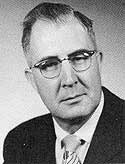
Kenneth A. Lauritzen
Head of University Standards during the anti-Gay "Witch Hunts"
Ten years later, Attridge would write a lengthy, anonymous letter
(using the initials LML for "Let Me Live") detailing some of these
events from the Witch Hunts of '68. The University of Utah's campus
paper, the Utah Daily Chronicle ran it as a front page
feature at the end of January, 1978. This unleashed virulent public
debate in subsequent editorials, with several Mormons questioning
the accuracy of Attridge's tale. A week later however, one of the
men actually from Attridge's list who had been caught and punished
by BYU wrote to the Chronicle and confirmed all the
details of those tragic days at the "Y". This former student
(another relative of a General Authority) had chosen to leave school
at the end of the term rather than see Kimball. However when he
tried to transfer his credits elsewhere, he discovered that
"B.Y.U....coded my records so that I could not obtain an official
transcript...because of a problem with Standards which had not been
cleared." Some months later, this same student learned that BYU had
released his hold though and he was eventually able to attend
another university. [147]
According to BYU
Board minutes of 1973, in January of 1969, the BYU
Board of Trustees (usually comprised of several General Authorities
and the University President) ruled that Lesbian, Gay and Bisexual
students "would not be admitted or retained at BYU without approval
from the General Authorities".[148] Three years
later, 1972 Board
minutes reveal that Apostle Marvin J. Ashton was
asked by trustees to help further define a clearer policy on
homosexuals at BYU because the new president of the university,
Dallin Oaks, was concerned about what to do with those students or
school personnel who had homosexual desires but were not "overtly"
homosexual. [149] Six months later, the
Trustees ruled that those who were not "overt and active
homosexuals" could remain on campus at the university's discretion
and upon recommendation by the "ecclesiastical leader having
jurisdiction over the case". However, those who were "overt and
active" would still be automatically expelled unless a General
Authority recommended otherwise. [150]
.
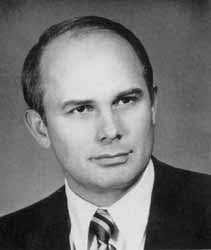
Lawyer and BYU President, Dallin Oaks
In 1973, David C. Martin tried to return to BYU for his graduate
work. Prior to admission though, he had to be interviewed again by
both the Dean of Students and Apostle Kimball. He and his wife now
had six children, so he was able to convince them that he was indeed
"cured" of his homosexuality and apparently signed a statement
testifying to that. After getting his graduate degree, he moved his
family to Nauvoo, Illinois, where he started the Mormon
Miscellaneous newsletter and became well-known in the "Mormon
Underground" of scholars, collectors, and dissidents. Unfortunately,
David contracted HIV during the 1980s and died of AIDS in San Diego
in 1992. [151]
Two other Gay BYU students were caught in 1973 and threatened with
expulsion from the school. However, they were then informed that
they could remain if they would "work for security as spies", to
entrap other Gays attending the school. The were told that if they
refused the assignment, they would be expelled. According to a 1982
interview with Dave, who knew these two men, "Security was obnoxious
and knew how to push people into things they didn't want to do".
Apparently a few other people who had been coerced into spying
"became fed up" with their treatment by BYU and went to TV stations
in Salt Lake City with their tales. With such negative publicity
focused on the Y in 1973 and 1974, the Security Office became less
aggressive in their tactics. Dave admitted that "After that blew
over things were quiet for a while". Joseph Morrow, a BYU security
guard in 1973, testified that BYU security investigations of
off-campus Gay spaces were commonplace in the early 1970s. He stated
in an interview that once he ws asked by his supervisor, Paul
Tanner, "to go to Salt Lake City to check for BYU parking permits on
cars gathered around specific bars. The bars...were known homosexual
haunts". When Marrow expressed dismay over the assignment, he was
told "it was a regular weekend practice". [152]
The "Witch Hunts of 1975"
In the aftermath of the Stonewall Riots in 1969, Gay and Lesbian
rights rhetoric finally reached BYU by the early 1970's, inducing
many students to come out of the closet, despite fears of academic
and ecclesiastical repercussions. In January 1975 BYU administrators
sent its security officers to quash an alleged "homosexual ring" on
campus. Security officers descended en masse on the Harris
Fine Arts Center and took all male drama and ballet students out of
their classes to interrogate them in hallways and in front of other
students, humiliating them publicly. BYU security also apparently
sent undercover officers and volunteers to Gay bars in Salt Lake
City to record the license plate numbers of cars with BYU parking
stickers on them. Rev. Robert Waldrop reported that he had seen men
recording license plate numbers outside gay bars on several
occasions and upon approaching one of these men, the stranger
refused to explain his activities, jumped into a car with a BYU
parking sticker and left. Joe Redburn, the owner of the Sun, Salt
Lake's most popular Gay bar, also had witnessed BYU security
officers actually come into his bar quite regularly, trying to catch
Gay students in compromising situations.
Ben Williams reported to me that in November 1975, Security began
intense surveillance of the men's bathrooms in the Wilkinson Center,
where students met each other for sexual encounters. Williams was
caught in the Wilkinson bathrooms by a Security officer named
Shephard (probably BYU detective Malin Shephard, later involved in
the arrest of David Chipman, below), simply for witnessing Shephard
entrap a Gay American Indian student (whom Williams recognized as
being from the BYU performance group for Indians called the Lamanite
Generation, who had just returned from their first international
tour to Central and South America). Shephard hauled Williams to the
Standards Office, where Shephard told Williams that "there is a
problem at BYU and you are part of the problem". He also informed
Williams that he had arrested another Gay student earlier in the
day, but that student had been very rebellious and had told Shephard
that BYU was the problem, not the Gay student. (Williams was
subsequently disfellowshipped on April 10, 1976 by his branch
president at BYU, Paul H. Thompson, who became president of Weber
State University in 1991; Williams was then expelled from BYU).
In a humorous moment of open dissent, some of the students who were
caught in the witch hunt or "Purge of '75" got some assistance in
the design of a t-shirt from a Gay art student named David N-------;
they then had the shirts printed up at the BYU bookstore. The
T-shirts read sarcastically, "I'm on the list - are you?" Their
audactiy was even reported in the New York Times. [153]
Not all Gays on campus could respond to this situation with such
audacitous humor however. As the purge continued into 1976, in a
joint effort between Utah County Sherriff's officers and BYU
security during March 1976, fourteen men were arraigned in Pleasant
Grove (near BYU) on charges of "lewdness and sodomy" at two nearby
freeway rest stops. During surveillance of these rest stops, police
and campus officers documented more than 100 men, many of whom were
from BYU, who were "believed to engage in homosexual activity"
there. [154] One married student named Larry
C--------- was arrested on March 28th at the rest stop. He attempted
suicide by swallowing a bottle of aspirin and then showed up at the
door of his boyfriend, Ben Williams. When Ben noticed Larry getting
drowsy, he drove him to Utah Valley Hospital. Medical personnel
there pumped Larry's stomach and then illegally reported Larry's
suicide attempt to BYU Security without his permission. Security
already had a file on him due to his recent arrest at the rest stop,
so they in turn informed his BYU branch president and his wife of
the situation, again without his consent. This devastated the
already emotionally fragile man. His wife showed up at the hospital
but refused to stay with him, so Ben was asked by one of the nurses
to remain with Larry to help him through his first hours of
recovery. Larry was soon threatened by his branch president with
excommunication unless he provided the names of other Gay students.
Larry gave the bishop a list of names, omitting only Ben's because
he had been so helpful and in fact, they were in love. Larry was
then "watched like a hawk" by Security so Ben never contacted him
openly again.
Another of these men arrested at the rest stop was 54 year old BYU
professor of music, father of five, and World War II Army veteran
(of the Pacific Theater), Carlyle D. Marsden of Kaysville, Utah.
Humiliated and distraught over his arrest, Marsden left his home in
the morning, drove down the street just a short distance from his
home, and shot himself in the heart with a pistol on Monday, March
8, 1976, two days after his arrest. Marsden had served a mission to
the New England States and then attended the College of Southern
Utah for two years but received his bacherlor's degree from BYU, a
master's degree from the University of Utah, and had done more
graduate work at Claremont College, Occidental, and California State
LA (now UCLA). In 1944 he married Adelaide Lund in the Salt Lake
Temple. He was the member of the bishopric and Stake High Council in
Pomona, California and was a Sunday School superintendent in Salt
Lake. As a gifted musician, he later served as a Music Regional
Representive for the church, stake and ward organist and choir
director. By career, he was a music teacher at both Brigham Young
University and Eisenhower Junior High School in the Granite School
District in Salt Lake. His death was a tragic loss for his family
and the many social, religious, educational, and musical communities
in which he circulated. Oddly, only the Ogden Standard Examiner
carried notice of his suicide. The Daily Universe at BYU
and the Provo Daily Herald did not even mention that he
had died, let alone killed himself. [155]
|
|
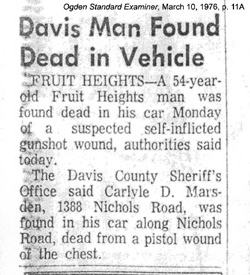 |
Carlyle D. Marsden
Gay BYU professor who shot himself to death
|
Notice of Marsden's suicide, Ogden Standard
Examiner, March 10, 1976, p. 11A
|
The public outcry against these tactics and their results led to
President Oaks giving an interview to the Salt Lake Tribune
in March 1976. Oaks was asked 'if BYU security agents checked known
homosexual haunts looking for BYU students". Oaks cautiously replied
that he personally didn't know but "he wouldn't be surprised if
security officers made such investigations over a period of time".
BYU Security Chief Robert W. Kelshaw admitted in 1982 that "in the
past we have gone off campus to seek [Gays]" and also confirmed that
"we do communicate with other law enforcement agencies and check
court records periodically." Efforts were also being made on campus
to find and spy on suspected homosexuals using ecclesiastical
channels. For example, Larry M****, a closeted homosexual and member
of BYU's 71st Ward, was given the assignment by his bishop and his
Elder's Quorum president to spy on a certain other man in the ward
whom the bishop suspected was a homosexual. Larry and the Elder's
Quorum president were to relate to the bishop anything suspicious
and not tell anyone about this "special assignment". [156]
The Values Institute
In the midst of its second major purge of homosexuals in less than
eight years, BYU and church officials grew so alarmed about the
on-campus infiltration of this alleged homosexual "ring", that in
1976 they established the Institute for Studies in Values and Human
Behavior on campus (hereafter Values Institute). [157]
The Values Institute was proposed by Dallin Oaks at a "Combined
Boards" meeting (meaning the Boards of Trustees for both BYU and the
Unified Church Educational System) on September 1, 1976. [Click
here to see the minutes of the "Combined Boards".]
The minutes do not indicate at all what the true nature of the
institute was. Instead, the purpose of the institute was given in
the minutes as innocuously sponsoring and conducting "research that
would assist in preventing and changing problem behaviors which lead
people away from eternal life". Oaks promised that "there would be
close cooperation with LDS Social Services, which would provide some
resources to assist in the work", and that the "knowledge gained
would be shared through appropriate channels" in and out of the
Mormon Church. BYU Psychology professor Allen E. Bergin was also
recommended to the Boards as the director of the institute. Note
that the word homosexual was not used or implied in any way in the
minutes.
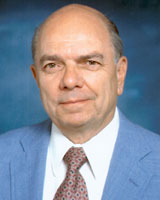
Dr. Allen E. Bergin,
Director of the anti-Gay "Values Institute"
Four weeks later, the campus paper publicly announced the formation
of the Values Institute. The
450 word article in the Daily Universe
again never once informed the public what its true goals were, again
never even implied that homosexuality would be the focus of the
Values Institute. In fact, the day the article came out, Oaks had a
lunch meeting with Bill Evenson and Kent Harrison (members of BYU's
College of Biological Sciences) and told them that "he had
personally reviewed this announcement very carefully before it was
published to insure that it said precisely what he wanted to be
said", ensuring that the Mormon public would have no concrete idea
what the Values Institute was really up to. In the most oblique of
terms, the newspaper article stated that the Values Institute would
"attempt to harmonize professional concepts with a religious
approach to human problems" and "also study the effects of lack of
belief on human behavior, the role of the father in child
rearing...and find a new way in the study of man which takes into
account that he is an offstrping of God". The article also announced
that Bergin would head the institute and gave his credentials, which
included serving as president of the Society for Psychotherapy
Research from 1974 to 1975, diplomate in clinical psychology of the
American Board of Professional Psychology, Fellow of the American
Psychological Association, and member of the American
Psychopathological Association. Despite the innoffensive-sounding
nature of the Values Institute and the credentials of its director,
the true purpose of this organization was far more sinister.
The Values Institute was in fact charged primarily with producing a
manuscript "which would set forth significant empirical evidence in
support of the Church's position on homosexuality".[158]
This book, funded by the church tithing monies, would be written for
a "New York Times type of audience" by Bergin and Victor L. Brown
Jr. (of LDS Social Services), approved of by at least one General
Authority, published by a popular eastern press, and made to appear
as though it had no ties at all to the church. The resulting book
would then be available as "secular evidence" to back up the
church's anti-Gay stance. [159]
Other Values Institute goals included: (1) reviewing "the means by
which the [homosexual] 'opposition' attempts to indoctrinate our
people", (2) preparing anti-Gay papers and rebuttals, (3) supporting
academic and scientific research that would vindicate the church's
homophobic position, and (4) recommending to the First Presidency
"specific steps the Church might take in combating homosexuality and
other sexual misconduct". [160] Anti-Gay
papers and research conducted, sponsored, or supported by the Values
Institute included Elizabeth C. James' 1976 Ph.D. dissertation at
BYU, "Treatment of Homosexuality: A Reanalysis and Synthesis of
Outcome Studies" (with Allen Bergin as chairman of her dissertation
committee), Bergin's 1979 paper, "Bringing the Restoration to the
Academic World: Clinical Psychology as a Test Case", and Ed D.
Lauritsen's 1979 paper, "The Role of the Father in Male
Homosexuality".
|
|
|
Elizabeth James's Dissertation for
the Values Institute
[Click on image to enlarge]
|
James's Abstract
[Click on image to enlarge]
|
Victor L. Brown Jr. reported to Academic Vice President Robert K.
Thomas in a November
1978 memo that he and Bergin had made a two-hour
presentation to the Presiding Bishopric earler that month on the
anti-homosexual activities of the Values Institute. This
presentation was made in order to secure church funding for the
Institute through the Presiding Bishopric Office, which handles all
the tithing funds that church members contribute for "humanitarian
projects". In their presentation, they recommended "specific steps
the Church might take in combating homosexuality and other sexual
misconduct" and affirmed that their "basic theme is that truth lies
with the scriptures and the prophets, not with secular data or
debate". Brown summarized that their presentation to the Presiding
Bishopric had been given in two parts. "Part One is a review of the
means by which the 'opposition' attempts to indoctrinate our
people", specifically: "the fallacious claims in the Payne
papers"; "LDS people unwittingly legitimizing worldliness"
(with an example of the Daily Universe advertising the
rock group Seals and Croft on the same day it reported Spencer
Kimball's campus address on standards); and oddly the "'macho'
behavior of priesthood leaders as reported by their long-suffering
wives". The second part of their presentation consisted of "examples
of truth being on our side", including: (1) "consistent and clear
statements of inspired men"; (2) data from the work supported by the
Values Institute; (3) "explication of the developmental pattern of
sexual deviance"; (4) the creation of a "clinically oriented
document" of both religious and secular data for parents and other
church members; (5) creation of "an LDS book on human behaviors";
and (6) the creation of a "politcal action kit for use of
member-citizens in local legislative efforts" to oppose Gay rights.
This two-hour presentation was then made before the First Presidency
on November 17, 1978, and after that, it was made before all the
General Authorities and last of all, to BYU president Dallin Oaks.
At a symposium for pyschotherapists held in San Francisco around
January 1979, Allen Bergin gave a presentation called "Psychotherapy
and Religious Values", espousing to his colleagues an "orthodox
theistic value structure" over a humanistic one. Bergin then
recounted what happened at the symposium during an address he gave
at the 16th Annual Distinguished Faculty Lecture held on February
21, 1979, at BYU. Bergin informed his BYU audience that there "were
several homosexuals who were mental health professionals in the
audience." A man from New York stood up during the question and
answer portion and asked what Bergin's "personal value is with
respect to homosexuality". Bergin reported that
There was a stunned silence in the audience. I was stunned
myself. For three seconds I contemplated how I was going to react.
But then I felt that there was no way to react except with total
transparency. It was a very honest question so I would give a very
honest answer. The first thing I said was that as far as I am
concerned homosexuality is sinful. The silence deepened. Then, I
stated that this does not mean I hate homosexuals; I can have
respectful associations with them and I can treat them
therapeutically. But then I described a recent study of
homosexuality and also said that my beliefs led to the hypothesis
that homosexuality had ngative consequences. I said that while
that may be a hypothesis from my value structure, I believed there
was support for it. I referred to a study just published which
indicated that 50% of white male homosexuals in San Francisco had
had at least 500 sexual partners, 28% had 1000 partners, and 25%
of them had had relationships with boys under the age of sixteen.
By the time I had finished with the data on homosexuality, no one
said anything more, although afterward some came up and talked
with me.
The study that Bergin referred to is Bell and Weinberg's 1978 book,
Homosexualities: a Study of Diversity Among Men and Women. It
is unfortunate that despite 500 pages of statistics which clearly
indicate that homosexuality is "simply a natural variation of sexual
expression", Bergin culled only the three most scandalous
statistics that can be found in the entire study, ignoring all the
positive data. Bell and Weinberg had tried to pre-empt just such a
homophobic tactic by pointing out that, "the fact that homosexual
liaisons... are not encouraged or legally sanctioned by society
probably accounts for their relative instability." It should be
pointed out as well that Bell and Weinberg had gotten their study
subjects by approcahing Gay men in bars and other sexually-charged
environments in San Francisco, rather than simply sampling people
from the far more sexually settled Gay neighborhoods.
For Bergin, "this symposium experience was a transition point" in
his career; he noted that most significantly was overcoming his fear
of being physically assaulted, beaten up for his beliefs. However,
Bergin's paper was not without its consequences. Bergin received an
overwhelming response to "Psychotherapy and Religious Values", both
pro and con. Two renowned mental health professionals, Albert Ellis,
of the Institute for Rational-Emotive Therapy in New York, and Gary
B. Walls, of Miami University, were invited to speak on a panel with
Bergin and rebut his paper; their responses were subsequently
published. Though Ellis and Walls disagreed with some of Bergin's
categories and his theism, they did not attempt to deny the major
points Bergin outlined, and they agreed there is a need to be more
honest and objective in psychotherapy as to one's religious value
system. Ellis and Walls did question the data that Bergin had
collected from LDS students at BYU. At one point Ellis told the
audience that BYU students will "just tell you what you want to
hear", rather than give honest answers. Even other Mormons
psychotherapists distanced themselves from Bergin and his work. One
LDS professor complained to Bergin that what he was doing was
"maverick-type stuff, and it's not going to have credibility. You
are well enough known nationally that everyone will think all of the
other Mormon professionals are like you. And I don't want to be
labelled as [being] like you." [160A]
While Bergin was stirring things up at secular symposia, Ed D.
Lauritsen presented a paper he wrote for the Values Institute at a
seminar on homosexuality sponsored by LDS Social Services in Salt
Lake City on February 6, 1979. In "The Role of the Father in Male
Homosexuality", Lauritsen theorized that "nurturant
fathering...almost serves as a form of psychological immunization
against homosexuality in most cases". He also told his audience that
"it is incumbent upon...all LDS clinicians to labor for the prevention
of homosexuality" (emphasis in original). He indicated that every
time "we assist a man toward improving his relationships with his
children...we are, in effect, helping him reduce the possibility of
homosexuality among his children, and in turn, among his children's
children". Lauritsen even went so far as to claim that this would
fulfill the biblical "prophecy" in Malachi of "turning the 'hearts
of the fathers to the children and the...children to their fathers
lest the earth be smitten with a curse", "a part of which curse
homosexuality may very well be". [161]
In March 1979 Marion G. Romney, then Second Counselor to Spencer
Kimball, asked Thomas Monson to get a more concrete budget on the
Brown-Bergin "Special Project on Values". Oaks in turn wrote a March
1979 memo to Presiding Bishopric member, J. Richard
Clarke, in which he felt that "the conclusion of a professional book
by December 31, 1979 is totally unrealistic. It would require at
least six months and perhaps as much as twelve months after that
time to complete the necessary work on manuscript and galleys for
publication". Copies of this request for church funding from the
Presiding Bishopric also went to Apostle Monson, and Church
Commissioner of Education, Jeffrey R. Holland.
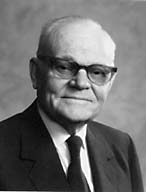 |
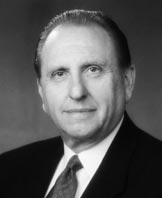 |
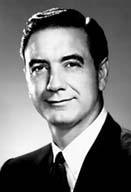 |
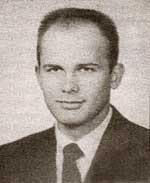 |
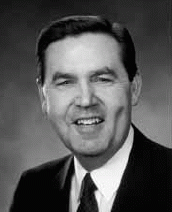 |
|
Marion G. Romney, Apostle
|
Thomas S. Monson, Apostle
|
J. Richard Clarke, Counselor,
Presiding Bishopric
|
Dallin Oaks,
BYU President
|
Jeffrey R. Holland, Commissioner
of Education
|
|
Five high ranking LDS leaders
involved in securing church tithing funds for the anti-Gay
"Values Institute" at BYU
|
Victor L. Brown Jr. again reported to Academic Vice President
Robert K. Thomas in a September
1979 memo that things had not been going well with
the Values Institute, although Brown felt optimistic about the
future. First, Brown noted that "a certain personal emotionalism
about our 'crusade'" had given way to the "careful, empirical
development" of their work. He then reported that Bergin's work had
been thoroughly discussed, pro and con, at the recent American
Psychological Association meeting in Oxford. Brown noted that "while
the cons are vigorous, the pros are moreso" and therefore Bergin had
been invited to East Germany to give a presentation in the spring of
1980. Brown felt that this was an indication that "the tide is at
flood and we should take advantage through serious empirical work".
Brown also stated that the Values Institute leaders had met with
Thomas S. Monson and others (possibly Marion G. Romney) on August 9,
1979 to ask for approval to "write the [anti-Gay] book for a New
York Times type of audience" and to create "more technical articles"
to enhance the book. Monson and his committee then recommended this
to the First Presidency on August 10, 1979, and immediately received
approval to move ahead with the book project. This memo also
included a recommended budget for church funds to support their
research until they could secure funding from either the National
Science Foundation or the National Institute of Mental Health.
However, by late 1979, the Institute for Studies in Values and
Human Behavior had not succeeded in achieving most of its goals.
Bergin and Brown had not successfully rebutted Jenkins's paper (aka
"the Payne Papers"); Bergin's "scholarly
objectivity" was consistently challenged during professional
conferences and his professional standing was being questioned
because of the backing provided by the LDS Church; and President
Dallin Oaks was annoyed at what he perceived to be an undermining of
his own authority by members of the Values Institute who had
sidestepped the campus and church lines of authority and gone
directly to the First Presidency for approval of their projects. The
anti-Gay manuscript project was also not working out. On September
13, 1979 a rather rankled Oaks wrote to Apostle Thomas Monson [CLICK
HERE TO SEE THE LETTER] to explain the overwhelming
problems of the "Bergin-Brown Book on Values"; school administrators
had become persuaded "that we cannot achieve the original objectives
to the extent hoped" by having the book appear through the
"independent popular publisher". By 1980, the Values Institute had
spent almost $150,000 in church funds unsuccessfully trying to
produce the manuscript. According to Oaks, LDS General Authorities
were getting "squeamish" over the project. Pressure on the Institute
became too great for Allen Bergin, who resigned as chair. The
manuscript project was scrapped and the Values Institute was
disbanded.
One of Allen Bergin's Gay twin sons, Michael
R. Bergin (a delightful, intelligent young man who tragically
died of pneumonia in 2003), criticized his father's role in the
hypocritically-named Values Institue, when he wrote to me that he
knew that his father was a "Church spokesperson regarding
homosexuality in the mid-1980s [sic], but not until I semi-moved
into my dad's office [and read his files] did I become aware of just
how deceitful, unethical, and literally contrary to official Church
doctrine the 'bretheren's' actions were. Things have changed since
then, but that doesn't negate the facts of what happened back then."
[162] Victor Brown did eventually go on to
publish a rather insipid book based on some of the research of the
Values Institute, in Deseret Book's 1993 Human Intimacy:
Illusion or Reality. Evergreen
International (the anti-homosexual "cure ministry" of
Mormonism) currently uses Brown's book as part of their curriculum
for heterosexually married homosexuals.
Shocking
Events at the Y
On September 5, 1935, New York University professor Dr. Louis W.
Max informed a meeting of the American
Psychological Association (APA) that he has successfully
treated a "partially fetishistic" homosexual neurosis with electric
shock therapy delivered at "intensities considerably higher than
those usually employed on human subjects," the first documented
instance of aversion therapy used to "cure" homosexuality. (Note
that the APA's 2007 Task
Force on Appropriate Therapeutic Responses to Sexual Orientation
has concluded that "efforts to change sexual orienation are unlikely
to be successful and involve some risk of harm.") As far as I can
tell, the earliest experiments with aversive therapies at BYU to
"cure" homosexuality date to the mid-1960s and were spearheaded by
D. Eugene Thorne, head of BYU's Psychology Dept. By 1968, he had
gained enough information to report his findings from BYU in a paper
given in San Francisco that year for the annual convention of the
American Psychological Association. Then in 1969, school
administration became more careful in its use of controversial
therapies for treating "sexual deviancy" as they put it. The
administration publicly claimed that use of such therapies had been
curtailed but unofficially they continued unabated. BYU's Academic
Vice President, Robert Thomas, advised college deans to alert those
who were using aversive therapies to be "particularly cautious in
utilizing them" not because they might prove harmful per se,
but out of fear for law suits.[163]
In 1975, the BYU Psychology Department administrators organized a
Board of Review for Psychotherapeutic Techniques to recommend
"policies governing the use of sensitive treatment techniques" on
campus. Within a year, the review board had assembled a list of
eight therapies being used at BYU which "could conflict" with church
teachings. However, most of the therapies were not stopped
(including electric shock, vommiting aversion, and the use of
pornographic materials).
Gary Bergera interviewed Gerald Dye, chair of the University
Standards office, in February 1978, and Dye reported what the "set
process" was for "homosexual students referred to Standards" for
counseling:
- They are asked to a personal interview with Standards...to
determine the depth or extent of involvement; previous
involvement, if any, of offender; does the student understand the
seriousness of the matter; if the branch president or bishop [is]
aware.
- The individual's branch president or home bishop is contacted.
- Standards is to determine if the offense is serious or not
- a. serious: repetition; anal/oral intercourse.
- b. less serious: experimential [sic]; mutual masturbation.
- Action taken.
- If determined to be serious, the student is expelled.
- If less serious, the student may remain at BYU on a probationary
basis.
- Standards also acts as an intermediary between the student who
remains and counseling service; Students who remain are required
to undergo therapy. [164]
Although "therapy" was required for homosexual students, Dye
promised Bergera that "no student working through Standards will
ever undergo aversion therapy". Electric shock and vomiting aversion
therapies were nonetheless used in special cases. [165]
Max Ford McBride's PhD dissertation, completed in August
1976 under the direction of BYU psychology professor D. Eugene
Thorne (note that Dr. I. Reed Payne, of the "Payne
Papers" infamy, was also on his dissertation committee), is an
excellent example of clinical dehumanization practiced by Mormon
"therapists". In the Mormon worldview, the end certainly justifies
the means: heterosexuality must be attained and maintained AT ANY
COST - even if it means using pornography (which the Mormon Church
is usually vehemently opposed to) and physical torture.
Under the oversight of his committee chairman, Dr. Thorne, McBride
experimented on fourteen Gay male subjects to determine if using
photographs of nude men and women from Playgirl- and Playboy-type
magazines was helpful in electric shock therapy. The 14 Gay BYU
students in McBride's study were compared after being "treated" on
an out-patient basis during 22 sessions of shock therapy. Each of
the 22 sessions lasted 50 minutes. 10 of those minutes were spent in
"assertive training" and the remaining 40 minutes in "aversive
conditioning." The average duration of treatment for the men was
three months. The release form these men were required to sign
informed them that "damage to tissue or organs may occur," that they
would be looking at "sensitive materials" possibly contrary to their
values [ie. pornography], and that BYU would be released from any
responsibility for any damage done to them. [Click
here to see the dissertation listed in BYU's Lee Library
online catalog.]
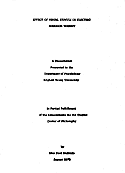 |
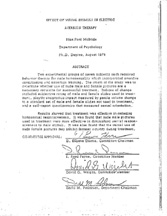 |
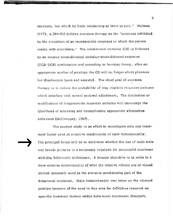 |
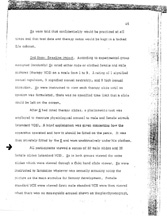 |
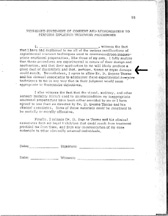 |
|
Cover Page of
McBride's Dissertation
|
|
McBride's Use of
Pornography on Campus
|
Subjects told
to sexually fantasize
|
Release Form warning of
physical damage
|
Click on images above to enlarge
OR VIEW THE COMPLETE DISSERTATION BELOW, VIA
GOOGLE DOCS
The longterm effects of the electric shock "therapy" these men were
subjected to has been crippling. Two of the men committed suicide
soon after completing this torturous study. Every survivor I have
interviewed has suffered life-long emotional, spiritual, and
sometimes physical damage. In 1999, John Cameron, one of the 14 men
who went through this horrific experience in 1976 when he was a 23
year old BYU student and member of the Young Ambassadors, wrote to
me, "For 22 years now I have lived with the scars of the experience
- unable to articulate a personal suffering and longing that have
almost crippled me....I didn't completely come out of the closet
until I was 34, and only after much angry, pissed-off therapy. I
spent a lot of money just so I could yell at my psychologist and
break things in his office for an hour every week for two years. But
it was a hell of a lot more fun than Ford McBride and the
electrodes." [166]
A Gay psychology intern at BYU named Ray actually assisted in
giving elcectric shock therapy to fellow Gay men in the late 1970s.
In an interview he did for Sean Weakland's documentary on aversive
therapies at BYU called Legacies, Ray gave the following
report on his activities and their results (which I quote here
extensively because Ray has so much "insider" knowledge):
"A lot of times BYU security would catch people in compromising
positions on campus. Those people would have the choice to either
be kicked out of school and have their families notified about
what they had done or they could go through this therapy. We had
quite a few people who were going through it. There were others in
the therapy who felt so much guilt for being the way they were or
they had been promised that if they underwent the therapy they
would be able to marry and have children and they would be turned.
Of course they had to have the desire to change, and if the
therapy failed (which it always did), it was their fault for the
failure since they didn't have enough desire.
"Anyway, they would come in usually three times a week. I would
be behind a glass one-way mirror, and they would be on the other
side of it. They had their choice to look at pornographic
magazines or watch porno videos. We would tape electrodes to their
groin, thigh, chest and armpits. We had another machine that would
monitor their breathing and heart rate. If there was a difference
in their heart rate when looking at homosexual pornography, we
would turn a dial which would send a current to shock them. If
they were a new patient, we would use a very low current. From the
reaction that I saw there were muscle spasms which looked very
painful.
"After that was over, we would switch the pornography over so
that it was a man and a woman having sex, and we would play very
soothing music in the background to try and get the mind to relate
to that. For the people that had been doing the therapy longer we
turned the voltage way up so that you could see burn marks on the
skin and quite often they would also throw up during the therapy.
This is speculation, but most of the students at BYU probably
hadn't even seen pornography before.
"After undergoing that kind of pain over a number of months,
everyone said that they had completely changed. They kept records
for as long as the people were at BYU. After they had graduated,
there was no records kept to see what kind of success rate they
had. The BYU statistics were wrong because the people were lying.
They were desperate to get their degree and get out of the
situation. They had been blackmailed into the situation in the
first place.
"We did have some people who became completely asexual after
undergoing the therapy. But no, we never changed anyone from gay
to straight....We had several people who committed suicide during
the therapy. We had three different people who hung themselves in
the Harris Fine Arts Center on BYU campus." [167]
In the late 1970s, Carol Lynn Pearson, a famous Mormon poet whose
husband Gerald Pearson was Gay, met one of Gerald's Gay friends at
BYU named Sam. Sam told Carol Lynn that "they strapped me in a chair
and attached wires to me. Then they showed me porno movies of men in
sexual activity. When I got turned on, they gave me a shock." At
first they just shocked his hands. "After that they added my
forearms, and then my calves and thighs. That was when they started
cranking up the voltage. I had to go in two or three times a
week....Only it didn't work. All I wanted was not to touch anybody,
not to be with anybody. I felt like I was being turned into a
zombie. I would walk down the street and be freaked by everyone. The
idea of touching anyone, even my family, made me sick."
After enduring several "treatments", Sam started to question his
participation in his own torture. "I made myself walk up those steps
and go into that building and sit down in that chair. And take
the shocks. Until I gave up....There were burns on my arms
but inside there was nothing different. Nothing! Just more pain."
Sam left and never went back.
Later, Sam told Gerald and Carol Lynn Pearson about another Gay BYU
student named John who had committed suicide after going through
electric shock treatments at BYU. After leaving BYU both Sam and
John had decided to move to Los Angeles together, although just as
friends, not lovers. "We were going to drop everything and go make a
new life. [John] told that to the General Authority that was on his
case, and the man told him he'd be better off at the bottom of the
Great Salt Lake with a millstone tied around his neck than to stay a
homosexual. John believed him. He believed everything they said to
him. He drove back to Provo, told his roommates he was going to the
laundromat, drove up Rock Canyon, laid out a blanket, and blew his
brains out." Sam fared almost as badly as John. In 1981, after
leaving a Gay bar in San Francisco, without any warning he was
attacked in a vicious anti-Gay hate crime by two young men wielding
a crow bar. He nearly died when they smashed his head in. Sam went
through five major surgeries and $70,000 in plastic surgery to
repiece his face together again. He was also blinded in one eye,
which was replaced by a glass eye.[167A]
I also personally recall an Affirmation meeting in 1988 when a man
showed up calling himself only David. He sat alone in a corner
during our meeting and became extremely jittery when anyone
approached him. I spoke with him but he requested that I remain at
least six feet in distance away from him. He then rolled up his
shirt sleeves and showed me his arms. The deeply-scarred skin on the
inside of his arms looked like raw hamburger and I almost vomitted
from the sight. He informed me that he had participated in electric
shock therapy at BYU in 1977 and had been allowed to turn up the
voltage as high as he wanted to. The results were badly burned arms
and a complete inability to come physically close to any male
without him emotionally breaking down from the trauma. His
homosexual desires were as strong as ever but he was unable to touch
another man even for a simple hug, he had no heterosexual desires
whatsoever, and he was constantly on the verge of suicide. David
never returned to Affirmation and I suspect from his fragile
emotional state that he did not survive his ordeal for much longer.
I also met two Lesbians in 1990 at the Gay Pride festivities in Salt
Lake who claimed that they had also gone through electric shock
therapy at BYU in the 1970s but I was not able to conduct a formal
interview and we lost contact. That is the only knowledge I have of
women being subjected to this torturous treatment at the hands of
so-called therapists.
Another Gay BYU student named Randy Smith went through aversion
therapy at BYU in the late 1970s, but when it failed to make him
heterosexual, he was excommunicated and expelled from the school.
Disillusioned by his treatment by the church and school, in 1981 he
organized a protest against the LDS Church during it's semiannual
conference in October. After he got legal permits to do so, he and
16 other protesters marched around Temple Square with signs and
banners protesting the unethical treatment of Gays by the Mormon
Church and then held a press conference, calling for the end of
aversion therapies. Almost all Mormons present simply ignored the
vocal protest in their midst. [168]
Robert McQueen, a Gay returned missionary and editor in chief of The
Advocate, published an article on Gays at BYU called "The
Heterosexual Solution: A Dilemma for Gay Mormons", accompanied
by a very intense depiction of the shock therapy, as well as a
scandalous cartoon depicting Spencer Kimball, Brigham Young, and
Joseph Smith showing a picture of a naked woman to two Gay men in
bed together (which is essentially what McBride was doing with his
"therapy" at the Y).
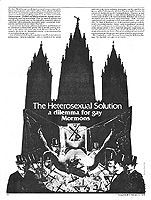 ________
________ 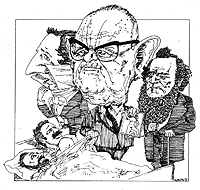
Images from The Advocate critical of LDS shock
"therapy"
[click on images to enlarge]
Andrew Welch, a former Daily Utah Chronicle staff member,
produced a 16 minute documentary on electric shock therapy at BYU in
1977 and early 1978. San Francisco public television station KQED
helped produce the documentary, which they broadcast in July of
1978. For the documentary, Welch interviewed 40 Gay men and
two BYU psychologists, and showed the electric shock therapy device
being used at BYU. Utah's PBS station, KUED, refused to air
the program on these torturous practices however, citing religious
differences, and the belief that the program had nothing to do with
civil rights - only "morality". (In 1982, BYU student Keith Mitchell
also produced a three part documentary on homosexuality at BYU.
However only the first two parts were aired. Part 3, scheduled to
air on August 6, 1982, was cancelled for not meeting "the standard
of accuracy set by the station". Part 3 simply contained interviews
with Gay BYU students and was thought to be "too sensational".) [169]
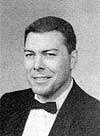
BYU Professor and lawyer D. Eugene Thorne
Overseer of Electric Shock "therapies" at the Y
Dr. Eugene Thorne's career after BYU has continued to be
controversial. Thorne became co-owner and Executive Director of the
Provo Canyon School (for severely "troubled teens") in March of
1979. In Milonas v. Williams, two students named Timothy
Milonas Jr. and Kenneth Rice sued Provo Canyon School
administrators, including D. Eugene Thorne, for causing Milonas,
Rice, and other students at the school to "suffer and to be
subjected to cruel and unusual punishment, anti-therapeutic and
inhumane treatment, and denial of due process of law." The school
(and Dr. Thorne) were found guilty of violating the students' First
and Fourteenth Amendment rights by monitoring and censoring student
mail, using isolation rooms unnecessarily, and using physical force
to coerce behavior modification. The guilty verdict was appealed but
the rehearing was denied by the Court of Appeals on November 9,
1982. Despite being successfully sued for inhumane treatment of
students, Thorne left the Provo Canyon School and became director of
the Discovery Academy, a school similar to Provo Canyon School, but
located in the city of Provo itself. Dr. Ford McBride is also
currently in practice in Provo, Utah.
In April 1997 I made a call for BYU to admit what had been done to
these people, apologize, and make financial reparations to them.
However despite the massive evidence to the contrary, Merrill Joseph
Bateman, then President of BYU and a high ranking LDS General
Authority, issued a
statement to me via email on April 9, 1997 in response to my
call, indicating that, "we have not been able to verify your
assertion that electric shock therapy...was ever used on gay and
lesbian students at BYU." At least a dozen other people over the
course of several years thereafter received similar denials from
Bateman or his office, when they have contacted him about this
issue. To my knowledge, Bateman has never retracted his denial.
Bateman is currently a member of the First Quorum of the Seventy. [170]
The 'Payne Papers' and Prologue
Ultimately the Values Institute's greatest challenge came from an
unexpected quarter: Gay BYU student Cloy Jenkins. At the same time
that the nucleus of Gay students on campus was forming what would
become Affirmation, about June 1977, after attending an anti-Gay
lecture by BYU psychology professor I. Reed Payne (a member of the
Values Institute), Jenkins quickly prepared a thoughtful,
comprehensive response to Payne's lecture (initially referred to as
"the Payne Papers"), calling for a "well reasoned dialogue on these
issues". Jenkins received editorial help from three friends (Gay
brothers Lee and Jeff Williams, and a Gay former professor and chair
of the Humanities Division at Ricks College in the 1950s, Howard
Salisbury, with cover art work by Donald Attridge) in editing his
response. (It is now published by Affirmation as a pamphlet entitled
Prologue).
Jenkins then somehow arranged to have copies of the "Payne Papers"
mailed out through the Church Office Building mailroom in Salt Lake
City, to all LDS General Authorities, as though it had originated
from the Department of Psychology at BYU.[171]
Jenkins's paper was soon circulating among faculty and
administration at both BYU and Ricks College, as well as television
and radio stations, and newspapers throughout Utah and Idaho,
drawing both rebuke and praise from its readers.[172]
The church's reaction was immediate. According to a social services
counselor at BYU, Jenkins' paper caused "a real stir at BYU and in
the Church - officials in both places are very touchy over it". [173]
Allen Bergin however wasn't impressed by Jenkins' paper, calling it
"a fabrication. Those guys aren't interested in facts", and as
director of the Values Institute at BYU, was ordered by LDS Social
Services and the BYU Comprehensive Clinic to prepare a rebuttal.
This proved to be difficult, however, because Jenkins had actually
made several "really good and undisputable points", his figures on
the numbers of Gays at BYU were accurate, and, according to BYU's
Executive Committee, he had used a "rather sophisticated
pro-homosexuality platform".[174] Bergin
finished his rebuttal on August 22, 1977 and titled it "A Reply to
Unfounded Assertions Regarding Homosexuality". BYU's executive
ecommittee immediately hailed it as "an excellent paper refuting
[the] major claims" of Jenkins. [175] Despite
this initial optimism, one BYU professor said that Bergin's rebuttal
on behalf of the church was so poorly written that "it was an
embarrassment to all involved".[176]
Bergin's reply states that:
"a small, but increasingly vocal, number of homosexuals still
alleging adherence to Latter-day Saint beliefs has claimed that --
1. They are not responsible for their homosexual behavior because
it arises from conditions beyond their own control; 2. The course
of homosexuality, once entered, is irreversible and irremediable;
and 3. Homosexuality is a harmless and benign alternative
lifestyle, the legal and religious proscription of which is a
fundamental denial of human rights."
These are actually three rather pertinent points that Bergin
summarizes here, which indicates to me that Bergin had read or
heard, and at least partially understood, the demands that the
Lesbian, Gay, Bisexual and Transgendered community were making at
that time. And unflinchingly reactionary, Bergin asserted that "an
examination of the relevant scientific information shows that there
is no evidence that any of these claims are true."
Bergin then replied individually to these three points, stating
that there was indeed, "a large volitional element in the selection
of sexual orientation", that "homosexuality is not obligative
because it can be and has been cured", and thirdly, claims that
homosexuality is benign "may be deeply rooted in the psychology of
anxiety, guilt, and defense". Bergin concluded that an "overall
review of the scientific literature" on homosexuality "is consistent
with the Counsel of Church leaders who have define...unacceptable
sexual behavior by means of revelation from the Lord." Mormon
leaders could rest assured that their authority claimed by
revelation was backed by the heavy weight of scientific "fact".
However because Bergin's rebuttal was such an "embarassment", word
went out that "all copies be returned [to Bergin] as he hopes to
rewrite his reply", although fortunately several copies survived his
recall. [177] Apparently, Bergin did try to
rewrite his response, without much success. Bergin's colleague,
Victor L. Brown, Jr., also tried to rebut Prologue, but his
response was also so poorly done that it was never released to the
public either. BYU
Executive Committee Meeting minutes for September
15, 1977 reveal that Church Commissioner of Education, Jeffrey R.
Holland, and BYU President Dallin Oaks were "working very closely
with Elder Boyd K. Packer concerning this matter". The Executive
Committee at that time was composed of Victor L. Brown, Gordon B.
Hinckley (chairman), Thomas S. Monson, Boyd K. Packer, and Kenneth
H. Beesley (Secretary). [178]
When it became apparent that no authoritative response whatsoever
was forthcoming from the Values Institute, the church hierarchy
decided to intervene personally. President Spencer Kimball asked
Apostle Boyd K. Packer to "specifically address the local problem of
homosexuality and to offer solutions" to BYU students.
Uncharacteristically, Packer at first balked at and declined the
assignment from his priesthood superior, telling Kimball,
"President, I just couldn't do it." However, when pressed again
urgently by Kimball, he "repented for having refused an assignment
from the prophet" and decided to speak to an assembly of BYU
students in early March, 1978. At the same time, the Advocate,
a national Gay news magazine edited by ex-Mormon Robert
McQueen, was also preparing to publish excerpts from Jenkins'
paper (see above). About three weeks prior
to its 22 February publication, the Advocate sent out press
packets to newspaper agencies across the United States. The religion
editor of a newspaper in Oregon sent a copy of the Advocate's
press packet to a Mormon friend, lawyer James H. Bean, who forwarded
it with a
letter to Dallin H. Oaks at BYU. Six days later,
Oaks then drafted
a letter to Packer, warning that "in view of this
national publication, and the accusations it makes...your [upcoming]
remarks are likely to get wide newspaper coverage and to be viewed
by many against the background of this article and these charges." [179]
In early to mid 1978, Kenneth A. Kline (a BYU alumnus and organizer
of the controversial "Human Rights" convention a year earlier - see
section above) contacted Deseret Book Company
"to see if they would sell the publication [Prologue] " and
he then submitted a copy of the Library of Congress and had it
"registered as a BYU publication". Oaks hotly retorted, "We have
corrected that error, and obtained the name of this individual from
the Library of Congress". Dallin
H. Oaks reported to Jeffrey R. Holland in November
1978 that:
1. Our General Counsel's Office has exhausted all possibilities
with the Postal Department. They are unwilling, under their
interpretation of the law, to proceed against the misleading
representations in this publication for a violation of the postal
laws and regulations.
2. Hal Visick [Assistant to the President and General Counsel]
and I continue with the opinion that any direct action by the
University aginst the publishers would be counter-productive,
arousing greater public attention and resentment [than] any
benefit to be gained.
3. We are still unaware of the identity of the authors, though we
do have the name of a key contact.
Oaks then informed Holland of the identity of the man they only
knew as "K.A. Kline" who had tried to sell Prologue through Deseret
Book, and had submitted it as a BYU publication to the Library of
Congress. Oaks also gave Holland Kline's home address. After
discussing the possibility that this K.A. Kline might have been the
BYU alumnus Kenneth A. Kline, Oaks remarks that he doubts that Kline
"would be the author of the publication, but he may have some
relationship with the person who was. I believe it would be best for
us now to let this matter drop" because "any direct action by the
University against the publishers would be counterproductive,
arousing greater public attention [than] any benefit to be gained."
[180]
To the
One...Thousand?
Despite his reservations as noted above, on March 5, 1978, Packer
delivered his now infamous "To
the One" speech during a twelve-stake fireside at BYU, since
the Values Institute was failing in its mission. Although the entire
speech dealt with homosexuality (and briefly with transsexuality),
Packer used the word "homosexual" only once (and then only as "an
adjective to describe a temporary condition", rejecting it "as a
noun naming a permanent one") because he felt that Mormons "can very
foolishly cause things we are trying to prevent by talking too much
about them". This is not Packer's only theory about the causes of
homosexuality - and causation was vital, because, for Packer,
finding the cause was an "essential step in developing a cure". In a
4,000 word speech, Packer gives at least six
different, often specious or contradictory causes (and touches upon
several others without fleshing them out as fully as the main six),
thoroughly confusing both the issues and his audience. Howeverly,
ultimately Packer settled on speculation that the cause of
homosexuality "will turn out to be a very typical form of
selfishness". This egregious speech was made into an official
pamphlet by the corporation of the church and is currently
distributed worldwide for use in counseling Gay, Lesbian, Bisexual,
and Transgendered Mormons. [181]
Packer's insistence on silence around this topic gave reprieve to
some homosexuals in the audience who were listening. Gay student
Larry M**** took a woman he had met in the marching band to this
fireside. As he later reported, "When Packer got started on his
topic I began sweating. I wondered if my date suspected that I was
'the one' Packer was talking about. What a relief when he requested
near the end of his talk that we not discuss his remarks afterwards.
This saved me from having to talk about it with anyone." Two weeks
after Packer's speech, a BYU counselor commented that Packer's
"spiritual" approach to homosexuality had actually originated with
the director of LDS Social Services, Kent Peterson, who "was in
charge of working with homosexuals in Church services". [182]
Right after Boyd Packer's speech, Shari Eyre, editorial writer for
BYU's student newspaper, the Daily Universe, wrote a trite
editorial called "'Gay' label misapplied on basis of a few traits",
complaining that "some have frequently and unjustly applied the
label of 'homo' or 'gay' to persons not deserving it". Examples of
her defendants were high-voiced men, male beauticians, and same-sex
friends who express their affection for each other through hugs or
kisses. She reiterated that "Elder Packer said his speech was for
the 'one'. But many people appear eager to apply it to those
numbered among the 'ninety-and-nine."
Packer saw the article in the Universe, grew incensed
that his message of "silence is best" had been ignored by the
official campus paper, clipped out the editorial and mailed it to
Pres. Dallin Oaks, accompanied with a typed quote from his own
speech, and then added a simple handwritten note. The quote from his
speech he chose to append was, "I want to tell you pointedly that I
have thought this to be a very personal message. No good purpose
will be served if you make this message the subject of chatter in
the dormitories, or in classes, or church meetings. I repeat, I have
thought this to be a very personal message, and I have already said
that we can very foolishly cause things we are trying to prevent by
talking too much about them." With an arrow drawn to his list of
dormitories, classes, and meetings, he very sarcastically added in
his own hand " - or in the Universe. I somehow missed mentioning the
Universe". [CLICK
HERE TO SEE PACKER'S LETTER TO OAKS]
On March 17, 1978, an obviously irritated Dallin Oaks passed
Packer's memo on to M. Dallas Burnett (dean of the College of Fine
Arts and Communications), with the following curt notation: "You
will note from the attached that Elder Packer was not pleased to
have his talk the subject of editorial comment in the
Universe...Nothing can be done at this point except to apologize,
which I will handle with him directly." The campus paper then
apparently refrained from mentioning homosexuality for quite some
time. [CLICK
HERE TO SEE OAKS' NOTE TO BURNETT]
Response to Packer's remarks by members of the Utah Gay community
was immediate. Robert Waldrop, the Gay pastor of the Metropolitan
Community Church in Salt Lake City (and a former Mormon missionary),
termed the speech "very offensive and highly inaccurate" and
demanded that the PBS television station KBYU, which had broadcast
Packer's sermon, give him equal air time. Bruce Christensen, KBYU
general manager, denied Waldrop's request and told the media that
KBYU has a "responsibility to cover all aspects of the gay rights
issue and we believe we have done that with fairness".
[183]
A BYU student in attendance at Packer's speech also quickly wrote a
rebuttal, which was published anonymously in the local Gay paper, The
Salt Lake Open Door. The student criticized Packer's approach
as "some kind of pseudo-psycho-spiritual counsel which close
analysis will prove to be a substantial assemblage of a profound
lack of reason and education". However, he warned that Packer
"is clever. Packer's treatise on 'selfishness' zeros right in on
the desperate attempt many have made in trying to attribute their
sexuality to some personality characteristic or quality which is
causing their homosexuality. If this quality can be changed (and
it is usually some malleable trait - like selfishness), then the
homosexuality will disappear. This approach also has the
therapeutic return of displacing guilt. (A burden of guilt
encouraged by the heterosexual moralist-theologian). The
homosexual is thereby informed that he should be feeling guilty
for being selfish - not for being homosexual. This helps ease his
anguish and he experiences an instantaneous relief. He is well on
his way to escaping into health, to optimistically denying his
authentic nature, to psychological swindle. Even when he fails
(which is inevitable), he comes back to focusing on his
selfishness and not on his sexuality. It is much easier warring
against an attribute like selfishness than challenging one's
sexuality."
This student believed that Packer's assertion that "the cure" is
something which "finally has to take place in the spiritual realm"
was the most serious flaw in his theory, because then "we don't have
to talk about the realities here of sexual impulses when we can
focus on the transcendent sacred dimension out there. When the [Gay]
subject fails, then [Packer] simply declares...that the subject is
somewhere in transgression of spiritual matters." In conclusion, the
anonymous student reiterated that "as appalling as it is, it is
miles ahead of President Kimball....At least the subject of
homosexuality seems to have finally come out of the closet - too bad
Packer has dressed it in rags." [184]
The David Chipman Case
In the meantime, an elaborate sting operation was being set up by
BYU campus security officers to entrap Gay students. I cover this in
length because of the extensive media coverage it received and
because of all the controversial issues that were exposed as a
consequence. Security recruited a student named John David Neumann
who was willing to pose undercover as a Gay man and receive college
credit for it by enrolling in a BYU course titled "Justice
Administration 299R". Neumann took the authority of his role a
little too seriously and apparently became somewhat of a rogue agent
for Security. Neumann would later tell the press that the reason he
had become a student decoy was because he had once been approached
by a Gay man and it upset him that such a thing could happen on
campus, so he decided to help end homosexuality at BYU.
According to later reports, Neumann wrote an "unauthorized" letter
for the November 1978 issue of the Gay newspaper in Salt Lake, The
Open Door, stating that he was Gay and wanted to start a "Gay
Underground" group on campus. (Apparently Neumann didn't realize
that the year-old support group for Gay Mormons, commonly referred
to as "the GMU", was actually named "Gay Mormons United", not "Gay
Mormon Underground".) Interested parties were asked to contact
Neumann in the letter, quoted below. [CLICK
HERE FOR SCANNED IMAGE OF LETTER]
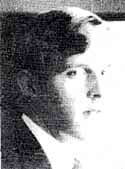
John David Neumann,
who posed as a "homosexual" for course credit
GAY'S AT BYU
Several of my friends have heard it rumored, and have shared that
rumor with me, that there may be a Gay Underground in the
formation stage at BYU.
I am sure that you are aware of the problems and pressure we have
here because of BYU's and the LDS church's views on homosexuality.
We're not permitted to come out of our so-called "closets". It's
just not fair, and I plan on doing something about it.
I hav eput much deep thought into an underground here, and if
there is no truth to the present rumor, I would like to take some
action.
I don't know howmany subscribers you have here at the "Y", but if
there is any way you could voice my interest in this effort to
those who do subscribe (or for anyone interested in the BYU area
for that matter) in one of the next issues, I would be forever
grateful.
If you know someone in this area who is a good organizer, I could
use some help. Either drop them a line and have them get in touch
with me, or give me his name and I'll contact him. First names
only though, please. Security here seems to be working overtime in
the places we've felt relatively safe in, until recently.
So, as you can see, we've got to move fast, or move out, and I
certainly don't want to do that -- I love it here. This place has
real potential.
In the December 1978 and January
1979 issues of The Open Door, Neumann
also placed more unauthorized ads in the classified section, asking
people to contact him to establish the Gay underground group at BYU.
Those interested were told to contact the paper's editors and they
forwarded all letters on to Neumann, never suspecting his role as a
spy for BYU Security. (When Neumann's "superiors found out about the
letter, the action was stopped", indicating that Neumann had been
working on his own. Paul Richards from BYU Public Communications
Office told the news media that "no action was taken to investigate
those who responded" to Neumann's letter - with the exception of
Chipman of course - and that all letters of response sent to Neumann
by The Open Door staff had been destroyed.)
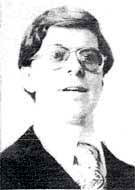
David Chipman
David Chipman, a Gay Mormon from Buffalo, New York,
who had previously been expelled from the "Y" (cause unknown) ,
responded to the
January ad, hoping to help John Neumann deal with
his "homosexuality." Chipman also later testified in court that "he
wanted to talk to Neumann only to tell him how to help LDS friends
who were homosexuals." On February 12, 1979 John and David met on
campus and went driving in Chipman's car. Chipman was unaware that
Neumann was wired and was being followed by an unmarked car with BYU
security officers Sgt. Clive Winn and Detective Malin Shephard
inside. Neumann asked Chipman where to go to meet Gays at BYU, and
Chipman told him about the "public sex environments" at the
Wilkinson Center bathrooms, and the Richard's P.E. building saunas.
30 miles down the road, off-campus and in another county, Chipman
stopped the car and started to chat with Neumann. At one point,
Chipman apparently touched Neumann in a "friendly manner" on the leg
or knee, although Neumann claimed that after touching him on the
leg, Chipman then touched him in the genital area. Neumann screamed
into his hidden microphone, "He touched me! He touched me! Come
arrest him!" BYU security officers Winn and Shephard then approached
the car and initially ticketed Chipman for reckless driving, and
then demanded he return to their offices so he could be formally
charged with the felony of "forcible sexual abuse". This was a
travesty of justice sincee Chipman was not a student, the security
officers were not only off-campus but out of Utah County, were not
deputized police officers with the power to arrest anyone, Neumann
was an illegal, untrained decoy, and was illegally wired. There were
also no outside witnesses to corrobarate the testimony of either
man, leaving it Chipman's word against Neumann's. Chipman was so
upset at the time, that several times during the car trip back to
Provo, he contemplated driving his car off the mountainous cliffs to
kill himself. A Gay friend of Chipman's, Wendell Ballantyne, also
reported that "Security tried to...blackmail [Chipman] into
testifying" against Ballantyne, who was then a Senior at BYU, but
Chipman refused and instead "tried to commit suicide afterwards."
At the May
2, 1979 Board of Directors meeting, BYU
administrators discussed Chipman's background "in some detail
inasmuch as he has visited the offices of a number of General
Authorities and others at the Church Office Building". In
August, at the President's Weekly Meeting, the
University's counsel, Elliott Cameron, again adressed Chipman's case
and Oaks was told to speak about "BYU's policy regarding
homosexuals" at the fall student assembly and the annual fall
faculty meeting, as a direct result of all the negative publicity
BYU was receiving over its treatment of Chipman, and the seemingly
limitless state and ecclesiastical authority of BYU Security
personnel. Oaks defended Security's authority when he informed the
press on two different occasions in September 1979 that BYU "did not
initiate efforts to have the legislation changed", which granted
campus security officers state police powers. However this was
completely false and newspapers quickly pointed out that legislative
records proved that BYU Security Chief Robert Kelshaw and his
predecessor, Swen Nielsen (who had since become Provo police chief),
had gone to the legislature the year previous to request that "peace
officer status be extended to private colleges" in the state, which
had subsequently been granted by the legislature, belying Oaks'
statement. Oaks also misrepresented the Chipman case, when he
defended the school's actions by claiming that, "People should be
able to walk down the street without someone seizing them and
soliciting sexual relations". Oaks conveniently failed to point out
that it was Neumann who had initiated the contact and the
conversation about sexuality, not Chipman, regardless of whether
Chipman had inappropriately touched Neumann or not.
The judge who initially tried the case, David Sam, was
also a Religion instructor at BYU and refused to dismiss himself
from the case for conflict of interest. Sam in fact indicated that
"my background and religious training enforces and strengthens my
professional duty to be entirely unbiased and unprejudiced in any
matter brought before me as a judge". Clearly, however, Judge Sam's
subsequent actions confirmed that he was anything but unbiased. On
April 8, 1980, at the end of the trial, Jude Sam, "[o]n his own
motion" and "without legal precedence", ruled that "there was
insufficient evidence Chipman committed the crime, but enough
evidence he attempted to carry out the crime" (although what that
evidence was is not clear). Chipman was then found guilty of a
lesser offense. Attempted forcible sexual abuse was only a class A
misdemeanor, not a third degree felony. However Chipman's lawyer,
fellow Mormon Ronald R. Stanger, felt that "it wasn't the judge's
place to find Chipman guilty on a lesser offense" and that the
ruling should simply have been guilty or not guilty of the charge of
forcible sexual assault. (Judge Sam also received further notoriety
in 2003 for summarily acquitting two members of the Salt Lake
Olympic Committee, Dave Johnson and Tom Welch, who had been caught
bribing International Olympic Committee members with money taken
from a humanitarian project for impoverished athletes. Ten IOC
members lost their positions for receiving the bribes. Judge Sam's
decision to acquit the bribers drew international criticism.)
In the midst of this lengthy legal battle, Paul
Mortensen, Los Angeles Chapter Director of Affirmation/GMU, sent out
an undated
(circa 1979) letter "To All Members and Friends of Affirmation"
soliciting donations to pay for Chipman's legal defense. As
Mortensen affirmed, many Affirmation members were "familiar with BYU
security tactics in dealing with gay people and are also aware that
such incidents happend regularly in the BYU area. This time,
however, the entrapped person has come forward and is willing to
fight it....We have all heard the horror stories at BYU regarding
the treatment of gay people. Here is a wonderful opportunity to
bring an end to some of the their deplorable activities." Mortensen
also indicated that Stanger ("a good Mormon") took on Chipman's case
"because he feels that such activities by the BYU police is legally
and morally wrong and the Church has no business being involved in
such activities." Mortensen ended the letter by confirming his
"strong testimony of the Church", and because he loved it, he wanted
"so desperately for it to follow Christian principles in their
dealing with our gay brothers and sisters" and passionately insisted
that "when any brother is being treated badly by the Church we are
all diminished."
Chipman appealed the decision to the Utah State
Supreme Court, where BYU President Dallin Oaks had a seat as a
Supreme Court Judge. He eventually dismissed himself from the case
for conflict of interest. Still, the State Supreme Court upheld the
lower court's decision. Chipman, financially ruined from court costs
and mentally exhausted, gave up his fight against a corrupt,
theocratic legal system and paid his $500 for the misdemeanor
charge. A brief announcement regarding Chipman's court loss appeared
in The
Advocate in June, 1980. Impoverished and
homeless, Chipman stayed briefly with Donald Attridge, the Gay
former BYU student who had been so instrumental in the purge of
1965, and they even contemplated a relationship but nothing came of
it. Attridge later learned that despite all that he had been through
at the hands of church and school, Chipman had gone to LDS General
Authority Vaughn J. Featherstone, who told him to change his last
name to Kennedy and get married, which he did. [185]
John David Neumann also participated in other entrapment operations
on campus. Gay BYU student Lee C******* remembers that when the
Chipman scandal broke, a photo of Neumann appeared in the campus
paper, The Daily Universe, and Lee recognized Neumann
immediately. In 2004, Lee wrote me that, "I recognized the officer
[Neumann] from the sauna in the [Richards] PE building. I would use
the sauna quite regularly and he would come in and liked to stand
right in front of me naked....He would put on quite a
display." While it was obvious to Lee that Neumann was being
consciously seductive, he never responded to Neumann's advances
because Lee was still "quite closeted at the time." The saunas at
the Richards PE building were such a common "public sex environment"
used by campus Gays that, later, swimming suits became required in
the sauna and a sign was posted mandating that anyone acting
"strangely" should be reported to the staff.
Neumann and another undercover security agent were also
instrumental in the excommunication and expulsion of two other Gay
students. The two undercover agents compiled "quite a file" in late
1978 and early 1979 on two lovers, Wendell Ballantyne (a senior) and
Steven Whiting (a sophomore). Neumann and his unnamed assistant
turned copies of this file over to both of the students' bishops and
they were immediately excommunicated because Ballantyne and Whiting
"both admitted in their appearance before church officials that they
were gay and both were unrepentant." Despite these unethical
activities that earned him college credit, Neumann is now a lawyer
in Virginia, having passed their state bar exams in July 2001. On
the other hand, Ballantyne had attended UC Irvine, and then served a
mission to France from 1973-76. He then transferred to BYU in 1976
and soon decided to come out. He and Whiting met in 1978 and became
partners at that point. Both were expelled from the Y subsequent to
their excommunication from the church. Holds for "standards
violations" were placed on their records for quite some time, so
they could not transfer elsewhere to finish their degrees. [186]
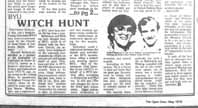
Wendell Ballantyne and Steven Whiting interview
May 1979, The Open Door
[click on image to enlarge]
During the mid-1970s, then married BYU student and returned
missionary Mark S------ was completely ignorant of the sexual
underground on campus until he read an article in the Daily
Universe about the arrests in the Wilkinson Center; despite
the possible consequences, he began frequenting there, merely to
observe what was going on. He was caught in 1977 for peeping through
stall doors by an undercover Security officer in the Wilkinson
Center restrooms. He was then coerced into psychological counseling
at the Counseling Center on campus and put on probabtion by the Y.
Mark began frequenting the restrooms in the Lee Library at that
point, aware that he he was being followed by Security, although he
was able to elude them for a while. In 1979, he was finally arrested
after touching an undercover decoy on the leg in the library
restrooms. Mark was then expelled from the Y and he never completed
his undergraduate work. Despondent and suicidal, Mark finally told
his wife of his homosexuality and recent arrest. She was so upset
that she promptly left him in December 1979 and took their children
with her to her native country, where they have lived ever since.
Mark then filed for divorce and has not seen his own children since
1980, although he does correspond with one child. Mark continued to
receive some Church counseling off-campus but finally decided to
come out by going to the Sun Tavern in Salt Lake City for the first
time. He then moved to Salt Lake in 1981, and completely
disillusioned with Mormonism, requested to have his name removed
from the rolls of the churc. He moved out of state in 1988 and
currently does not "affiliate with any religion or church,
organization, or even political party" because of his experiences
with the LDS Church and BYU. [187]
After Maxine Mudock of BYU Counseling Center conservatively
estimated that "4% of the student body was Gay", the BYU Counseling
Center compiled
and publicized statistics on the numbers of
homosexuals who were using their services. On August 3, 1979,
Richard Johnson of the Counseling Center indicated that of the 95
men counseled Winter Semester 1979 at BYU, 29 reported homosexual
activity and another 16 reported homosexual "fears and fantasies
only". Of the 158 women who were seen, 12 reported homosexual
activity and 9 reported "fears and fantasies". 16 men were also seen
for "gender identification" problems. No women were seen for this
"diagnostic category". Another 33 men were seen for masturbation,
while only one woman reported this as a "problem". Johnson wrote a
memo to David Sorenson (Dean of Student Life) and Maren Mouritsen
(Asst. Dean of Student Life) with the stats on August 3, 1979.
Marked "Private and Confidential", the cover memo also notes that
"depression, inferiority, and relationship problems appear still to
head the list for both groups. However, eating problems belong
primarily to females; sexual disorders primarily to males". These
statistics were then compared to those of one year prior, Winter
Semester 1978, during which only 12 men and 5 women were seen for
homosexual activity or "fantasy".
Jeffrey R. Holland, the new president of BYU in 1980 (now an
apostle), followed homophobic policies similar to those of his
predecessors in his treatement of campus homosexuals. For example,
in an October
7, 1980 memo marked "PERSONAL AND CONFIDENTIAL"
which Holland sent to William Rolfe Kerr (BYU Vice President - now
Church Commissioner of Education), he noted that a BYU student named
Joseph Brian Cole, in an effort "to put his life in order and
prepare for a mission", had confessed to his bishop, John Bennett,
of the Albuquerque, New Mexico 5th Ward, that he had participated in
homosexual activites. As part of his confession, he had given
Bennett the names of "four male BYU students, all returned
missionaries, who were also involved in homosexual activity
(partners?)". The bishop had given those names and details to Elder
Theodore M. Burton (as Area Administrator) and Burton had passed the
information on to Holland. Holland told Kerr that this case had
"both 14 stake president and Student Life implications" and asked
Kerr to proceed with an investigation along both lines, "and let me
know the facts." Holland concluded, "Obviously this should go
quietly and discreetly." (Sadly, 30 year old Joseph Brian Cole died
two days before Christmas, 1991, cause unknown.) [188]
 |
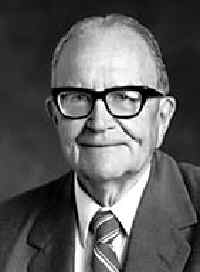 |
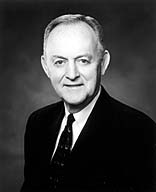 |
Jeffrey R. Holland,
BYU President
|
Theodore M. Burton,
1st Quorum of the Seventy
|
William Rolfe Kerr, BYU Vice
President
|
|
Three players in McCarthyesque
"confidential" activities to expel Gay BYU students
|
Of the four men listed, I know that at least two, Brent C****** and
David O****, were expelled from the Y, having a devestating effect
on their potential educations and careers. For example, David, who
was 25 at the time and a Senior in electrical engineering and music,
had an extremely difficult time transferring to the University of
Utah as a senior (colleges generally refuse to allow senior classmen
to transfer in). Additionally, he received "unoffical withdrawals"
in his classes for his last semester at BYU, which automatically
lapsed to Fs, bringing his GPA down from 3.26 to a 2.89 making it
even harder to transfer to another college. Fortunately the
University of Utah admissions office was sympathetic to his plight
and he was allowed to transfer in as a senior. [189]
MORMONISM & HOMOXUALITY TODAY (2005)
I have not dealt with the period after 1980 because AIDS, which
first appeared in the United States around that year, has radically
changed the face of Gay and Lesbian activism, bringing Gay and
Lesbian issues to the national (and ecclesiastical) forefront like
never before. The juxtaposition of sex, death, morality, and
politics (embodied in AIDS) has been such a complex and painful
issue for both the Gay community and the Mormon Church to negotiate
that it would require its own indepth analysis, going far beyond the
limited scope of this paper.
Suffice it to say that Mormon homophobic discourse has currently
"softened", resorting to "love the sinner, hate the sin". But I find
that is as difficult to believe as if I were to say that I love all
Mormons, while hating Mormonism; that's just not how love works.
Personally I find it nearly impossible to divorce who a person is
from what a person believes or does. Despite attempts at a more
"compassionate" response, anti-Gay rhetoric abounds today in
Mormonism as never before, from the well-paid upper-echelon, to the
lay leaders, and general membership. (See White and White's "Ecclesiastical
Polity and the Challenge of Homosexuality: Two Cases of Divergence
within the Mormon Tradition" for a good overview of
contemporary views of the LDS Church and its largest schism, the
Reorganized LDS Church - now called the Community of Christ.) The
LDS Church "unofficially" supports the Evergreen Foundation and its
claim of success in "reorientation therapy". Despite repeated claims
of success, Evergreen has been plagued with controversiy, especially
when their "poster boy" Russ Gorringe, for eight years on
Evergreen's governing board, left Evergreen in 2003 and publicly now
denounces its claims of "cure".[190] However
Dr. Albert Dean Byrd, formerly a clinical psychologist with LDS
Family Services, continues to promote a religion-based reorientation
therapy for Mormons, which in turn forms the basis for church
leaders' public pronouncements, despite the fact tthat the American
Psychological Association strongly condemns such "therapies".
(Fortunately a growing body of independent Mormon therapists have
decried Byrd et al. - see footnote for details.) In 1992, the church
published the homophobic booklet Understanding and Helping Those
Who Have Homosexual Problems, without realizing that societal
and political homophobia and heterosexism are the only "homosexual
problems" we have. [191] The following year,
the vociferously homophobic Apostle Boyd K. Packer also received
harsh condemnation and critical media attention for a speech he
delivered on May 18, 1993 to an "All-Church Coordinating Council
Meeting". In this speech, Packer identified "three areas where
members of the Church, influenced by social and political unrest,
are being caught up and led away." Those three areas, according to
Packer are "the gay-lesbian movement, the feminist movement, and . .
. the so-called scholars or intellectuals." [192]
Purges of Lesbians, Gays, and Bisexuals at BYU and elsewhere in the
church continue unabated (see below). To me, these certainly are not
acts of love, but of fear.
For unmarried heterosexual Mormons and for Gays and Lesbians who
choose celibacy to remain in Mormonism, heterogamy is still
compulsory. In 1993 an unmarried Mormon over the age of thirty from
Minnesota wrote to the church, questioning its current policy of not
allowing older single people to "serve as ordinance workers" in
Mormon temples. Apostle M. Russell Ballard counseled that rather
than desiring to officiate in the temple, "perhaps it would be more
wise that those who have not married and are over the age of thirty,
should seek to establish for themselves the full blessings of the
atonement of Jesus Christ" by getting married. Ballard continued
that heterogamy "is so paramount in the life of each individual
member of the Church that every effort should be made by individuals
to appropriately and according to their own wisdom find a companion
wherewith they may receive the joys and blessings of an eternal
family unit." [193]
While emphasizing the importance of marriage and the family, Mormon
leaders insist that they can only sanction heterogamy and a family
unit with a heterosexual couple as parents (following the paradigm
of the divine, heterosexual couple who Mormons view as the Father
and Mother in Heaven). This places Gay and Lesbian Mormons in a
no-win situation where they are commanded to marry for eternal
salvation, but are unable to marry the person of their choice and
desire. Furthermore, Mormon leaders move beyond the realm of
theology and enter the political by clearly mandating that any
alternative to this heterosexist family structure requires immediate
societal and legislative condemnation, depsite earlier statements
decrying civil rights abuses.
For example, Joseph Smith himself declared in a statement published
in the June 1, 1842 Times and Seasons (vol. 3, no. 15, p.
808), that both he and Assistant President of the Church, the
radical abolitionist John C. Bennett, were in fact "the
friends of equal rights and privileges to all men (sic)."
LDS President, John Taylor, also declared:
When the people shall have torn to shreds the Constitution of the
United States the Elders of Israel [i.e. Mormon men] will be found
holding it up to the nations of the earth and proclaiming
liberty and equal rights to all men (sic)". (Journal
of Discourses, 21:8)
(Taylor's "prophecy" is completely ironic, given that the LDS
Church has formally issued three
statements in support of a Constitutional amendment banning
legal homogamy, and the apostle Elder Russell M. Nelson signed an
ecumenical petition "to call for a constitutional amendment to
establish a uniform national definition of marriage as the exclusive
union of one man and one woman." Just days after
signing the petition, Russell M. Nelson married a second woman "for
all eternity" in a Mormon temple, making him a "celestial
polygamist". If passed, this Mormon-backed amendment would be the
first time the U.S. Constitution would be used to take away the
civil rights of tax-paying Americans.)
Furthermore, Hugh B. Brown, of the First Presidency, declared in
the October 1963 general conference that,
"We believe that all men [sic] are the children of the same God,
and that it is a moral evil for any person or
group of persons to deny any human being the right to gainful
employment, to full educational opportunity, and to every
privilege of citizenship....
"We call upon all men, everywhere, both within and outside the
Church, to commit themselves to the establishment of full
civil equality for all of God's children." (emphasis
mine)
As more adverse pressure was put upon the LDS church to amend its
racist policy of denying men of black African descent the Mormon
priesthood, on December 15, 1969, the First Presidency issued an
official statement decrying civil rights abuses and emphatically
calling for the African American to have "full constitutional
privileges as a member of society, and we hope that members of the
Church everywhere will do their part as citizens to see that these
rights are held inviolate. Each citizen must have equal
opportunities and protection under the law with reference to
civil rights." (emphasis mine)
In direct opposition to these passionate and compassionate
imperatives, the First Presidency statement issued to the church on
February 13, 1994 explained that "the principles of the gospel and
the sacred responsibilities given" to Mormons, require that the
church "oppose any efforts to give legal authorization to marriage
between persons of the same gender." (See Richley
Crapo's 1997 chronology documenting the LDS Church's
opposition to homogamy for details.) The First Presidency further
encouraged "members to appeal to legislators, judges, and other
government officials to preserve the purposes and sanctity of
marriage between a man and a woman, and to all efforts to give legal
authorization or other official approval or support to marriages
between persons of the same gender." In November 2004, Utahns
strongly supported "Amendment Three" (especially after offical
statements of support from church leaders), voting to amend the Utah
state consititution so that "(1) marriage consists only of the legal
union between a man and a woman; and (2) no other domestic union may
be recognized as a marriage or given the same or substantially equal
legal effect. [194] The consequences of
official Mormon political intervention have been politically
disastrous for the Gay community in both Hawai'i and California as
well, where the LDS Church recently spent millions of dollars in
church funds, successfully opposing homogamy in those states.
Several Gay Mormons committed suicide as a result of these homphobic
political maneuvers by the LDS Church (including the February and
March 2000 triple suicides of Clay
Whitmer, D.J.
Thompson, and Stuart
Matis, who shot himself in protest on the steps of his local
chapel in Los Gatos, California). Consequently Affirmation: Gay and
Lesbian Mormons has held several suicide vigils across the United
States and now maintains a lovely memorial website for all Gay
Mormon suicides and Mormons who have died from AIDS at their online
Book
of Remembrance.
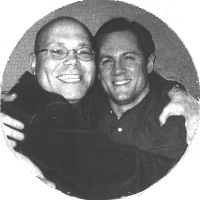 ___
___ 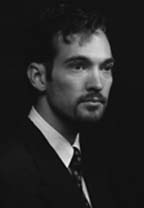
Clay Whitmer, Stuart Matis, and D.J. Thompson [left to
right]
Three Gay Mormons who committed suicide in early 2000 out of
despair for the LDS Church unethically
raising millions in support of Proposition 22 in California, which
made homogamy illegal in the state
Conditions for homosexuals at BYU have improved somewhat, although
many McCarthyesque tactics from the Wilkinson era are still
employed. In 1996 Gay BYU student, Sam Clayton, worked extensively
with Dean of Students, Janet Scharman, and Vice President of Student
Life, Alton Wade, until BYU made "public statements confirming that
gay and lesbian students could attend the university if they abided
by the honor code." A year later however, Clayton became embroiled
in a scandal when BYU officials (namely Ryan Beuhring, a member of
the Standard Four committee which is charged with determining
faculty tenure suitablity, and Beuhring's boss, James Gordon) tried
getting a Gay BYU professor fired by intimidating, harassing, and
manipulating Gay students who knew the preofessor and then
falsifying a written testimony against the professor. Fortunately
Clayton caught them in their machinations and threatened to go
public with what he knew. BYU was then under censure from the
American Association of University Professors for academic freedom
violations, so Gordon dropped the matter and the Gay professor
remained at BYU for another three years but has since gone to
another campus. [195]
When BYU's Comprehensive Clinic was up for reaccreditation by the
American Psychological Assocation (APA) in 1992, an intern at the
clinic contacted me to report that the head of the clinic had
ordered that records of their homosexual clients be falsified so
that the APA would not discover how the clinic was in fact treating
them. I passed this information on to APA's accreditation committee,
but without direct contact and a formal complaint from the intern
(who understandably insisted on remaining anonymous) there was
nothing the committee could do and the Comprehensive Clinic received
its accreditation.
Lesbian, Gay and Bisexual Mormons have responded to their
religion's teachings on sexuality in three ways: (1) remain very
"closeted" to conform to Mormon demands in appearance; (2) come out
of the closet while remaining loyal to Mormonism in order to
struggle for a voice from within the church; or (3) leave the
church. For those who are closeted and trying to remain in
Mormonism, their path is fraught with profound isolation and guilt
for their hypocrisy - especially if they have started families which
further causes them to assume roles for which they are not meant.
For those Lesbian, Gay, and Bisexual Mormons who continue to
struggle for a voice within the church, there are several
organizations available to support them. Affirmation
now has an international network of nine official chapters (three in
Latin America) and many informal groups meeting in 13 different
countries. Affirmation is currently experiencing phenomenal growth
in Latin America; in just three years, Afirmación México grew from
just five to over 150 members in 2005.
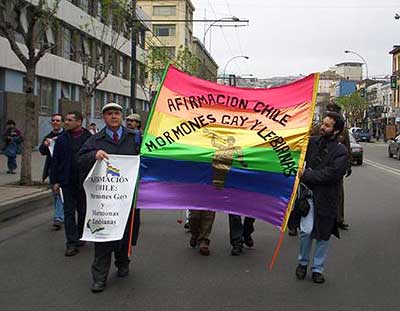
Brus Leguás Contreras (left, holding banner), president of
Afirmación Chile,
marching in Santiago Gay Pride, September 2004;
Contreras
was subsequently excommunicated in January 2005 for
apostasy,
"conduct unbecoming a member " and "teaching Doctrine contrary to
the principles of the Church".
There are also organizations for Gay LDS youth, Gay BYU alumni and
Gay returned missionaries, which meet monthly for their members to
explore and find consolation in their common experiences. There is
also a very strong, vibrant, politically active, and large LGBT
community in Salt Lake City providing a myriad resources for LDS
Gays dealing with their religion and sexuality. (Some 30,000 people
attended Salt Lake City's Gay Pride in 2005.) Periodicals,
pamphlets, books, and symposia are also media through which the
viewpoint of my people has recently been expressed. Others, like
myself, have found Mormonism too rigid, too oppressive to remain
within its structures and have chosen, instead, to continue our
spiritual journeys elsewhere. However, the common bond which all
Lesbian and Gay Mormons share is the questioning of our lives within
Mormonism - the values we learned from and the time and energy we
devoted to it. We all struggle to make meaning out of the
realization that, because the intensity and authenticity of our
desire to love and be loved by someone of our own sex, to "multiply
and replenish" heterosexually is not a realistic imperative for us.
Our bruised and battered bodies, lying at the feet of the church,
demand at the very least a thoughtful, inclusive, and loving
response.
What do I want?
Over the years, as people have read this essay, the question has
regularly arisen, "Just what would you have the LDS Church do?" My
one and only response has been:
REPENT.
And here are the Five Steps of Repentance, as related to this
particular subject:
- Mormon leaders must recognize and admit to themselves that they
have sinned against Lesbian, Gay, Bisexual, and Transgendered
people. (See essay above for numerous examples.)
- Mormon leaders must confess their sins to God and the Gay
community, issuing a formal apology during General Conference. And
have it printed in every major newspaper in every country where
they have a significant number of members.
- Leaders of the LDS Church must have and show true sorrow for
what they have done to us.
- LDS leaders must make restitution, in so far as is possible, to
all the Queer people they have harmed (including but not limited
to paying for therapy to repair the mental and psychological
damage they have caused, funeral expenses for all those who have
committed suicide, increased funding for AIDS/HIV-related
services, etc.)
- LDS leaders must change their lives and attitudes in such a way
that they do not repeat their sins against the Gay community. This
means working actively to secure equal rights under the law for
all Lesbian, Gay, Bisexual, and Transgendered people in every
country where the LDS Church has influence.
That's it! That's all I want....
This does not mean that the Mormons must change any of
their doctrine. If they still believe that God does not
approve of homosexuals or homosexuality, that is fine; just leave
that judgment to God, rather than trying to impose on us a hell on
earth. They simply ought to send us from their community of faith
with their love and their blessing, not their condemnation,
persecution, and fear. Both Justice and Mercy require this.
Remember:
"Inasmuch as ye have done it unto one of the least of
these my brethren, ye have done it unto me."
(Matthew 25:40)
Connell O'Donovan, 2010
I am a freelance historian who has found my Home in Santa
Cruz, California. Born in Syracuse, Utah to a fifth generation
Mormon mother and a convert father, I earned a Duty to God award in
Scouting, completed an LDS mission to Brasil Porto Alegre (1980-82),
served in the Elder's Quorum presidency of a Student Ward in the
Avenues of Salt Lake, worked in the baptistry of the Salt Lake
Temple (where I was also later married), and was a security guard on
Temple Square until I came out of the closet in on July 4, 1985. In
1988 I founded the Lesbian and Gay Historical Society of Utah (now
defunct) and continues to collect documents and ephemera relating to
homosexuality and Mormonism for his archival collection (now
measuring some 8 linear feet). In the late 1980s, I sat on the Board
of Directors for the Wasatch Chapter of Affirmation and served for
several years on the Gay and Lesbian Community Council of Utah,
chairing the Public Relations Committee. I also co-founded Queer
Nation Utah (a radical, non-violent, direct-action political group)
which held two large protests at Temple Square against the LDS
Church's homophobia in the early 1990s. I stopped
believing in the LDS faith in 1987, and was formally
excommunicated on December 5, 1991, under direct order of Apostle
Boyd K. Packer. I continue my studies in early Mormon history.
Because of the LDS church's deep involvement in Proposition 8 in
California (which took away my constitutional right to marry another
man) I became the Santa Cruz County coordinator for Mormons
for Marriage Equality and was very politically involved with
the campaign. As a result of the passage of Prop 8, I attended a
life-changing prayer vigil at the First
Congregational Church-United Church of Christ in Santa Cruz
(which features an Extravagant Welcome Program for LGBT folks) and
immediately fell in love with that community and that religion. I
was just baptized into the United
Church of Christ on July 4, 2010 and am nowpondering going
into the ministry. I work as staff at UC Santa Cruz. You may contact
me at odonovan@ucsc.edu
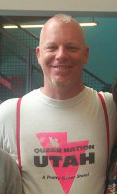
Sporting my Queer Nation Utah T-shirt
Affirmation National Conference in San Francisco, 2004
FOOTNOTES
1. Throughout this
essay, unless quoting others, I capitalize "Lesbian", "Gay", and
"Bisexual", as one way of affirming my belief that we have
constructed an ethnic identity: a social and cultural system which
includes, but is not limited to, a history, a language, and a
political sensibility, and which drastically differs in many ways
from that of the "Straight" community. By homosocial, I am
referring to the spectrum of beliefs, attitudes, loci, signs,
desires, and practices of the many aspects of Queerness.
Homosocial specifically means the dynamic of a group of people of
the same sex who socialize together. "Male bonding" is a form of
homosociality. Other aspects of this "homo-continuum" include the
homopolitical, homospiritual, homointellectual, homophysical,
homoemotional, homophilic, homoerotic, and ultimately, the
homosexual. Homophobia is literally an irrational, unfounded fear
of homosexuals and homosexuality, while I define heterosexism as
the assumption that all people are heterosexuals or ought to be.
Both engender such practices as anti- Gay legislation,
"reorientation" therapies, or passive, but debilitating silence.
2. T. Eugene
Shoemaker, "Human Sexuality in Mormonism: Reflections from the
Bishop's Couch; an Essay on Understanding," submitted for
publication to Sunstone Magazine, Sunstone papers, b.
26, f. 20, no date, Special Collections, University of Utah
Marriott Library.
3. Richard S. Van
Wagoner, Mormon Polygamy: A History (Salt Lake City:
Signature Books, 1989), p. 56.
4. Adrienne Rich,
"Compulsory Heterosexuality and Lesbian Existence", reprinted in The
Lesbian and Gay Studies Reader (New York: Routledge,
1993), pp. 239 and 242.
5. The term
"sister-wife" interestingly combines two intensely sensual,
emotional and personal concepts: conjugality and sorority.
6. Gail Farr
Casterline, "Ellis R.Shipp," in Vicky Burgess-Olson, ed., Sister
Saints (Provo, Utah: Brigham Young University Press, 1978),
p. 371.
7. Casterline, pp.
369-70.
8. Ibid., p. 371,
italics in original.
9. Carol Lasser,
"'Let Us Be Sisters Forever': The Sororal Model of Nineteenth
Century Female Friendship", Signs: Journal of Women in
Culture and Society, 1988, Vol. 1, no.1, p. 161.
10. "Louie B. Felt", Children's
Friend, 18 (18 Dec. 1919): 410.
11. Ibid., 411.
12. "Mary and
May", Children's Friend, 18 (18 Dec. 1919), p. 421.
13. While
Aurelia Spencer Rogers actually founded the first Primary
organization, Louie Felt organized the second branch of it a month
later in September, 1879. On June 19, 1880, Felt became the first
General President of the Primary, and in 1890, called her lover,
May Anderson, to be the General Secretary. May Anderson first
suggested in 1893 that the Primary have its own church-sponsored
publication, and in 1901, the Primary General Board finally
received permission to begin publishing the Children's Friend
with Anderson as editor. Felt and Anderson together conceived of
the idea for the Primary Children's Hospital after seeing a
disabled boy on the streets of Salt Lake City. In 1925, when Louie
B. Felt was released as the Primary General President, her
parttner May Anderson succeeded her in that position. For further
details on the relationship and accomplishments of these two
remarkable women, see their biographies in the following issues of
the Children's Friend "Louie B. Felt", vol. 18 (December
18, 1919), pp. 404-417, "Mary and May", vol. 18 (December 18,
1919), pp. 418-422, "The New Presidency", vol. 24 (November 1925),
pp. 21-23, "Louie B. Felt: A Tribute", vol. 24 (November 1925),
pp. 422- 425, and "A Friend of the Children", vol. 39 (April
1940), pp. 146- 152; as well as Susan Staker Oman, "Nurturing LDS
Primaries: Louie Felt and May Anderson, 1880-1940", Utah
Historical Quarterly, Vol 49, no. 3, pp. 262- 275.
14. "Mary
and May", 420-1.
15. See I
Samuel 18:1-4, and II Samuel 2:25-27. For discussions on David and
Jonathan as historical signifiers of male- male desire and
sexuality, see John Boswell, Christianity, Social Tolerance,
and Homosexuality (Chicago: University of Chicago Press,
1980), 105, 238-39, 252, and 299; and Richard Dellamora, Masculine
Desire: The Sexual Politics of Victorian Aestheticism
University of North Carolina Press, 1990), p. 221.
16. "Veteran
Worker in Primary Recalls History for Jubilee", Deseret News,
21 Apr. 1928.
17. For
biographical information on Thomas, see "Biographical Note"
accompanying the register
for the Kate Thomas papers, donated to the Utah State
Historical Society by her brother, U.S. Senator Elbert Thomas
(D-Utah). Included in the Kate Thomas papers is another biography
written by LeNae Peavey for a university class, entitled "Kate
Thomas (1871- 1950). However, Ms. Peavey went to great lengths to
avoid the Lesbian desire of Thomas's poetry.
18. "To
_________", Record Journal of Love Poems, Kate Thomas Papers, Utah
State Historical Society, Box 3, (Folder 5, p. 34.)
19. "A
Scarlet West", p. 36, Thomas Papers.
20. See
commentary on the 1868 song, "Gay Young Clerk in the Dry Goods
Store" in Jonathan Katz, Gay/Lesbian Almanac (Cambridg,
MA: Harper and Row, 1983) 315. Male dry goods clerks were
stereotyped by Victorian America as effeminate and what we might
today call "homosexual".
21. Katz, Almanac
22. "Narcissus", p.
80.
23. "A Gay
Musician", p. 79.
24. "Biographical
Notes", Kate Thomas Papers.
25. See Polk's
Directory for Salt Lake City, 1923 and 1927, and for Ogden,
Utah, 1919 and 1925.
26. Interview with
L.H. on August 8, 1988, and interview with J.B.B. on January 7,
1990. Cora's niece, Juli Dulmage, also emailed me on May 29, 1999
to let me know that in the 1960s one evening she was having dinner
with her aunt Cora when Cora started to explain why she had never
married but stopped mid-sentence and never told her niece why. The
possibility of lesbianism had not crossed Dulmage's mind until she
read an earlier version of this essay and now admits that her aunt
may have been a Lesbian although any Lesbian relationships she had
must have been "excruciatingly discrete". See also emails to me
from Peter Kasius dated May 6, 7, 25, and 26, 1999 for more
biographical data and family anecdotal material.
27. For biographical
information on Cora Kasius, see "Utah Woman to Join Dutch Welfare
Group", Deseret News 1945.
28. D. Michael Quinn
identifies Fanny Fern as non-Mormon feminist Grata P. Willis
Eldredge Parton and claims that this brief essay was originally
published in the New York Ledger (see D. Michael Quinn, Same-Sex
Dynamics Among Nineteenth-Century Americans: A Mormon Example
(Univ. of Illinois Press, 1996) p. 108. Coincidentally, "fern" is
an archcaic, somewhat derogotory word for a Gay man, similar to
pansy or fairy.
29. See the December
31, 1877 letter from Alice Blackwell to her sister-in-law Kitty
Blackwell for an almost identical description of the painfulness
of manipulative "smashing" at an eastern women's college, in Katz,
Almanac, p. 176. For another amazingly similar non-Mormon
description of "smashing", see Yale University student newspaper
of 1873, quoted in Nancy Salhi, "Smashing: Women's Relationships
Before the Fall," Chrysalis (1979), 8:21.
30. "Women Lovers,"
Woman's Exponent, vol. 1, #22, April 15, 1873, p. 175.
31. Quinn,
Same-Sex Dynamics, p. 108.
32. George Wehner, A
Curious Life, Horace Liveright Press: New York, 1929, pp.
397-400 and Michael Morris, Madam Valentino: The Many Lives
of Natacha Rambova, New York: Abbeville Press, 1991, pp.
191 and 195-197.
33. For information
on John C. Bennett, I am indebted to the Sam Taylor Papers, ms.
50, (Special Collections, University of Utah Marriott Library. On
all his villainy, see his brilliant biography by Andrew F. Smith,
The Saintly Scoundrel: The Life and Times of Dr. John Cook
Bennett, University of Illinois Press, 1997.
34. Samuel Taylor
papers, handwritten notes on typed page of rough draft of Nightfall
at Nauvoo unnumbered first page of Chapter VII, "Every
Species of Abomination," ms. 50, Box 29, Bk. 3.
35. Taylor to Lyon,
February , 1969.
36. T. Edgar Lyon to
Sam Taylor, Taylor papers, February 4, 1969, p. 2.
37. For Danites in
drag, see The Wasp, July 27, 1842, as quoted in Andrew
F. Smith, The Saintly Scoundrel: the Life and Times of Dr.
John Cook Bennett (University of Illinois Press, 1997) p.
94. "Bennettiana: or the Microscope with Double Diamond Lenses," The
Wasp, July 27,1842, on microfilm at the University of Utah
Marriott Library, emphasis is in original. Sam Taylor to Dr. T.
Edgar Lyon, Sam Taylor papers, January 31, 1969.
38. As quoted by
Smith, Saintly Scoundrel, p. 148.
39. L. F. Andrews, Pioneers
of Polk County, Iowa, Vol. I (Baker-Trisler, Des Moines,
1903) pp. 27-31 and 87-91; online at http://books.google.com/books?id=c3kUAAAAYAAJ&pg.
J.P. Munro-Fraser, History of Alameda County, California
(Myron W. Wood, Oakland, 1883) p. 871; Smith, Saintly
Scoundrel, pp. 12 and 27; 1870 Census of Santa Cruz CA,
Santa Cruz Public Library. For "chum", Dr. John Egan email to
Connell O'Donovan, January 24, 2005.
Note also that my own 3rd great grand father,
Robart Cooper, who was about 10 years older than John C. Bennett
and from Westmore County PA, was an early settler of Byrd, Ohio in
the 1820s, where he met Alexander Hill and according to a love
letter currently located in a library there, became lovers.
Throughout their lives, where one moved, the other followed. They
also promised to name all their male descendants after each other
so Robert Cooper's eldest son was named Alexander Hill Cooper and
Alexander Hill's eldest son was named Robert Cooper Hill; indeed,
some 175 years later, my father's and my middle name is Hill in
honor of their love for each other.
40. William H.
Holyoak to John Taylor, October 9, 1886, quoted in correspondence
of Raymond W. Taylor to Samuel W. Taylor, 7 June 1972, 2-3, Taylor
Family Papers, box 20, file 3.
41. Salt Lake
Tribune, 2 August 1886.
42. For Taylor's
excommunication notice, see Deseret News, 28 Aug. 1886.
For rumors published in the newspaper see "City and Neighborhood"
column of the Salt Lake Tribune, 22, 24, 29 August, and 2
September, 1886.
43. Thomas Taylor to
John Taylor and Angus M. Cannon, September 22, 1886, Taylor Family
Papers, p. 5.
44. Rudger Clawson
Journal, January 30, 1894, bk. 4, p. 83, Special Collections,
Marriott Library.
45. Clawson Journal,
bk. 4, p. 84.
46. Clawson Journal,
bk. 4, p. 151.
47. Clawson Journal,
bk. 5, pp. 30-31.
48. Salt Lake
Tribune, 24 December 1886, p. 4.
49. Taylor had three
wives, and Hunsaker had two. Both lost plural wives in divorce
proceedings immediately following revelations of their sexual
contact with other men. Christopher Cramer, Salt Lake's "Pioneer
Florist", was another polygamist who was also a "queer", as one
elderly informant called him in my interview with Cynthia Blood in
1989.
49A. For Arthur Bruce
Taylor's "coming out", see Quinn, pp. 40-1. For the Richfield
"ring", see Quinn, pp. 276. James Henry Moyle, "My History", as
quoted in Gene A. Sessions (ed.), Mormon Democrat: The
Religious and Political Memoirs of James Henry Moyle, as
excerpted at http://www.signaturebooks.com/
50. Daniel
Shellabarger, written comments on the Frederick Jones trial in my
possession, April 23, 1994.
51. For accounts of
the Jones trial and aftermath, see Salt Lake Daily Telegraph,
"A Heavy Case", 27 October 1864; "That Case", 28 October 1864;
"The Death of a Sodomite", 31 October 1864; Daily Union
Vedette, 1 November 1864; and Deseret News, 31
October 1864 and 2 November 1864.
52. Deseret News
2 November 1864.
53. Brigham Young to
Daniel H. Wells and Brigham Young Jr., 18 November 1864, in
"Correspondence", Latter-day Saints Millennial Star 27 (7
January 1865): 14, as quoted in Quinn, Same-sex Dynamics,
pp. 273 and 296.
54. "The Crime
Against Nature," Compiled Laws of Utah, 1876, p. 598.
55. "The Crime
Against Nature", Compiled Laws of the State of Utah, 1907,
c. 28.
56. "The Crime
Against Nature", Laws of the State of Utah, 1923, c. 13.
57. "Sodomy," Utah
Code Annotated, 1953, 8B, title 76 (76-5- 403).
58. For biographical
information on these converts to Mormonism, see passenger lists
for the Mormon emigrant ship "Horizon" (microfilm no. 025,691),
International Geneaglogical Index entries for Lancashire, England
(for Carter) and Sussex, England (for Edwards), and Family Group
Sheets for their families, all at the Family History Library, Salt
Lake City.
59. Josiah Rogerson
memoirs, Salt Lake Tribune, 4 January, 1914.
60. Prior to
beginning any research on Stephens, I had heard from four
unrelated sources the oral tradition passed down through other Gay
Mormons, that this famous Mormon and Horace Ensign of the
Tabernacle Choir, were Gay.
61. "Evan Bach: A
True Story for Little Folk, by a pioneer", Children's Friend
18 (October1919) p. 387.
62. "Evan Bach", p.
389. See also the accompanying intimate photograph of the two
young men, ca. 1875, when both were about 21years old, on p. 388.
On Stephens' impersonation of the "old maid", see "Yesterday's
Concerts," Deseret News, 30 September 1882; Evan
Stephens, "To the Choir Members," Deseret Evening News,
31 August 1887, p. 5. Ray L. Bergman, The Children Sang: The
Life and Music of Evan Stephens (Salt Lake City: Northwest
Publishing Inc., 1992), pp. 6, 83-86.
63. Dean C. Jessee, Letters
of Brigham Young to His Sons (Deseret Book Company, 1974);
Quinn, Same Sex Dynamics, pp. 135, 230-231; Improvement
Era, "In Memory of Three", (April 1931).
63A. Ronald W. Walker,
"Raining Pitchforks: Brigham Young As Preacher", Sunstone, 39
(May-June 1983); for Grow's cross-dressing, see Karl Brooks, “The
Life of Amos Milton Musser” (M.A. thesis, Brigham Young
University, 1961), p. 71.
64. Both are quoted
in Van Wagoner, Mormon Polygamy, pp. 67 and 106,
respectively.
65. United
States Reports, Supreme Court, 98, pp. 166-68, as quoted in
Van Wagoner, Mormon Polygramy, p. 110.
66. Van Wagoner, Mormon
Polygramy, pp. 133- 139.
67.See advertisement
in the Deseret News, 5, 6 Apr. 1882.
68. "Art Decoration:
Oscar Wilde Enlightens a Large Audience on the Subject," Salt
Lake Tribune, April 11, 1882.
69. Alfred
Lambourne, A Play-House (Salt Lake City: n.p., n.d.) p.
28.
70. Helen L. Warner,
"Oscar Wilde's Visit to Salt Lake City," Utah Historical
Quarterly 55 (Fall 1987): 333-334.
71. Deseret News
3, 4, 5, 6, 8, 11, 19, 24, 26, 30 April; 1, 3, 4, 7, 20, 22, 23,
24, 25, 27 May 1895.
72. Dellamora, Masculine
Desire, pp. 301-302.
72.A. See Quinn, p. 131 and
note 99.
73. Report of the 68th
Semiannual General Conference of the Church of Jesus Christ of
Latter-day Saints, (October 1897), pp. 65-66; for
contention amongst the Twelve Apostles, see
Edward L. Lyman, "The Alienation of an Apostle from His Quorum:
The Moses Thatcher Case", reprinted in John Sillito and Susan
Staker (eds.), Mormon Mavericks: Essays on Dissenters
(Salt Lake City: Signature Books, 2002).
74. Journal of Discourses,
vol. 20, p. 200. Interestingly, early Anglican theologian John
Bale wrote in "Apology against a Rank Papist" (London, 1550,
xxvii, xii [v]), that the celibacy of Catholic clergy had set
marriage and virginity "at variance" and replaced them with "two
unhappy gestes, called whoredom and buggery", making celibacy the
cause of homosexuality. Bale later wrote in "The Pageant of Popes"
(London, 1574, p. 36) that in his visitations to English Catholic
monasteries, which had been ordered by Henry VIII, he found "such
swarmes of whoremongers, ruffians, filthie parsouns, giltye of
sinne against nature, Ganimedes [young, effeminate homosexual
men]...and unmarried all, so that thou wouldest thincke that there
were a newer Gomorrah among them"; at Battle Abbey he found some
twenty monks "gilty of sinne against nature" - which sins included
homosexuality, prostitution...and polygamy!
75. Tribune
15 Feb. 1885, quoted in Van Wagoner, Mormon Polygamy, p.
133.
75A. D. Michael Quinn, Elder
Statesman: A Biography of J. Reuben Clark, (Salt Lake
City: Signature Books, 2002) p. 191 and p. 488, note 55; and D.
Michael Quinn, The Mormon Hierarchy: Extensions of Power,
(Salt Lake City: Signature Books, 1997) p. 307.
76. Eldred G. Smith,
who replaced Joseph F. Smith as Patriarch to the Church, claimed
that the young man was named Norville Service. George Albert Smith
diary, 10 July and 16 Sept. 1946; Joseph F. Smith diary, 10 July
1946; J. Reuben Clark office diary, 30 July and 16 September 1946;
typescripts in my possession.
77. See conference
report in the Improvement Era, Nov. 1946, pp. 685 and 708.
78. George F.
Richards diary, December 6, 1947, typescript in my possession.
79. David O. McKay
office diary, April 10, May 9, and July 10, 1957; First Presidency
files, 1959; typescripts in my possession
80. "Rexburg
Investigates Moral Practices", (Pocatello) Idaho State
Journal, September 14, 1950, p. 8. I have thoroughly
reviewed all issues of the weekly Rexburg Standard
newspaper from July to November 1950, and I could find no article
announcing this anti-homosexual investigation. However, in the
microfilm copy that I used (borrowed from "Ricks College", now BYU
Idaho through interlibrary loan), two articles had been blacked
out with duct tape before being microfilmed, so it is possible
those referred to this investigation and had been censored by
Ricks. I did note that every single issue had at least one (and
sometimes two or more) article or opinion piece rabidly opposing
Communism. Both the Ricks College and the Rexburg High School
studentbodies were widely involved in the "Freedom Crusade" to
raise money for a "shrine to freedom" in Berlin. Most of the
anti-Communist articles had a paranoid, almost hysterical tone to
them, as if huge numbers of Communists were poised just outside
Rexburg, ready to invade and conquer this Mormon bastion of
Capitalism and "liberty". J. Reuben Clark diary, September 11,
1950. Stephen L. Richards office diary, October 29, 1951. For
Storer, see "Homosexuals find understanding at Boise church", Idaho
Statesman, September 2, 1978, p. 5B.
81. Clark, "Home and
the Building of Home Life," Relief Society Magazine 39
(December 1952): pp. 793-4; Conference Reports, October
1954, p. 79.
82. John Gerassi, The
Boys of Boise: Furor, Vice, and Folly in an American City,
(New York: Macmillan, 1966). Ken Storer email to Connell
O'Donovan, September 16, 2004.
83. "Police Nab 23
in 27-Day Morals Drive", Salt Lake Tribune, May 29,
1958; see also "Suspect Held in Boys Morals Ring", Salt Lake
Tribune, February 13, 1958, p. 10; http://historytogo.utah.gov/jblee.html;
Congressional Record, Vol. 109, 88th Congress, 1st Session,
Appendix pp. A1-A2842.
84. Connell O'Donovan
interview with "Farris", August 15, 1991, notes in my possession.
84A. My main source has been
the online autobiography of Dr. Dorius My Four Lives,
formerly online at joeldorius.com; however since his death that
web domain no longer exists due to unpaid fees. I have obatined
some legal rights to its material and hope to upload it on the web
in the future. Other sources for this biogrpahical material are:
"Joel Dorius - gay professor in '60s porn scandal", San
Francisco Chronicle, Feb. 19, 2006, p. B8, http://www.nytimes.com/2006/02/20/obituaries/20dorius.html
and http://familysearch.org.
85. Edward L.
Kimball and Andrew E. Kimball, Jr., Spencer W. Kimball:
Twelfth President of the Church of Jesus Christ of Latter-day
Saints (Salt Lake City: Bookcraft, 1977), p. 381.
86.Spencer W.
Kimball, "A Counselling Problem in the Church", July 10, 1964, LDS
Church Archives. For Callis's early role in dealing with
homosexuality among Mormons, see Kimball and Kimball, Spencer
W. Kimball, p. 271. For arrests of Utah homosexuals
published in newspapers at that time, see for example "Suspect
Held in Boys Morals Ring", Salt Lake Tribune, 13
February 1958, and "Police Nab 23 in 27-Day Morals Drive", Salt
Lake Tribune, 29 May 1958.
87. Kimball and
Kimball, Spencer W. Kimball, pp. 383-384.
88. Spencer W.
Kimball, "A Counselling Problem in the Church"; The Miracle of
Forgiveness, (Salt Lake City: Bookcraft, 1969), Chapter Six,
"The Crime Against Nature,"; "New Hope fo Transgressors", 1970,
"New Horizons for Homosexuals," 1971, and "A Letter to a Friend,"
1978, all published by the Church of Jesus Christ of Latter-day
Saints. Minor works and speeches of Kimball against homosexuality
include "Love versus Lust," January 5, 1965, LDS Church Archives;
"Voices of the Past, of the Present, of the Future," Ensign,
1 (June 1971); "God Will Not Be Mocked," Ensign, 4 (Nov.
1974); "The Foundations of Righteousness," Ensign, 7 (Nov.
1977); and "President Kimball Speaks Out on Morality," Ensign,
10 (Nov. 1980).
89. Kimball,
"Counselling," p. 12.
90. A similar policy was still
in place in August 1980, when I was required to meet with General
Authority Paul H. Dunn before I could proceed with receiving a
mission call. Dunn met me in his office in the Church
Administration Building for approximately one and a half minutes
total, proclaimed me "clean and worthy", and commanded me to marry
"one of the righteous daughters of Zion" upon my return from my
mission. He bore solemn witness to me that the experience of
"normal sex" with a woman would "cure" me. As a memento of our
extremely brief meeting, I asked him to autograph my Triple
Combination, which I still have.
91. Life, 26
June 1964, and Medical World News, 5 June 1964.
92. John D'Emilio, Sexual
Politics, Sexual Communities (Chicago: University of Chicago
Press, 1983), p. 162.
93. Kimball,
"Counselling", p. 13.
94. D'Emilio, Sexual
Politics p. 164.
95. Kimball,
"Counselling", p. 13.
96. Spencer W.
Kimball, "Love versus Lust", BYU Speeches of the Year,
1964-1965 (Provo, UT: BYU Press, 1965), pp. 1-30, esp. 24.
97. Edward L. Kimball indicated
that "Horizons" was based on a 1966 letter, but a brief quote from
the "12/20/65" letter on p. 274 is also found in "Horizons"; see
p. 632, notation for item 71-19; The Teachings of Spencer W.
Kimball, Twelfth President of The Church of Jesus Christ of
Latter-day Saints, Edward L. Kimball, editor, (Bookcraft,
Salt Lake City, 1982).
98. Kimball and
Kimball, pp. 381-3.
99. Cloy Jenkins in The
Advocate, February
22, 1978, p. 11.
100. David Buerger interview
with Bill Marshall interview, March 22, 1978, copy in my
possession. Duane E. Jeffrey interview with Victor L. Brown, Jr.,
December 21, 1977, copy of notes in my possession.
101. D. Michael
Quinn, Same-Sex Dynamics among Nineteenth-Century Americans: A
Mormon Example (Univ. of Illinois Press, 1996) p. 382 and
footnote 81; and http://familysearch.org
for vital statistics on Desmond. Obituary in the Spokesman-Review,
May 12, 1983. For the Eucharistic Catholic Church, see their 1972
pamphlet online at http://www.lgbtran.org/View.asp?ID=BLD&Page=1;
for the Restoration Church of Jesus Christ, see Rosemary Winters,
"Gay Mormons find acceptance in Restoraion Church", Salt Lake
Tribune, June 5, 2004, available online at http://166.70.44.66/2004/Jun/06052004/saturday/saturday.asp
102. First
Presidency Circular Letter, March 19, 1970, LDS Church Archives,
typescript in my possession.
103. Priesthood
Bulletin, February 1973.
104. Homosexuality:
Welfare Services Packet I (Salt Lake City: Corporation of
the Church of Jesus Christ of Latter-day Saints, 1973), n.p. In
versions of this prior to 2015, I incorrectly identified Dr. Allen
Bergin as a collaborator in authoring this pamphlet, for which I
apologize.
105. Interview
with Bill Marshall, March 22, 1978. Copy of notes in my
possession. Antonio A. Feliz, journal excerpts for June 1980, copy
in my possession.
106. See:
http://www.leonardmatlovich.com/
http://www.affirmation.org/history/leonard_matlovich.shtml
http://www.365gay.com/lifestylechannel/intime/months/07-july/matlovich.htm
http://www.xq.com/cliff/leonard.html
http://www.findagrave.com/cgi-bin/fg.cgi?page=gr&GRid=2660
http://www.xq.com/apollomedia/miriam.html
107. Boyd K.
Packer, To Young Men Only (Corporation of the Church of
Jesus Christ of Latter-day Saints, 1976) n.p.
108. Long
Road to Freedom: the Advocate History of the Gay and Lesbian
Movement, Mark Thompson ed. (New York, St. Martin's Press,
1994), pp. xxiii, 214-5. The day before Harris died "from a rare
form of cancer", he told another staff member, "The quality of my
life has been reduced to such a miserable level that I don't think
it's worth going on", (p. 215).
109. "No dance at
rotunda", Deseret News, April 23, 1977.
109A."Gays will sponsor
rights convention", Utah Daily Chronicle, June 3, 1977;
"Convention for gays canceled by Hotel Utah", Deseret News,
June 9, 1977; "S.L. Hotel Cancels 'Rights' Convention Sponsored by
Gays" by Roger Bennet, Ogden Standard Examiner, June 9,
1977; "Hotel Utah Cancels Homosexual Parley", Salt Lake
Tribune, June 9, 1977; "Speaker Arrives for Gay Confab", Salt
Lake Tribune, June 10, 1977; "Gays get place to meet", Deseret
News, June 10, 1977, B-5; "Gays open S.L. convention, Deseret
News, June 11, 1977, p. A-4; and "Homosexuals Open
Symposium", Salt Lake Tribune, June 11, 1977. For
the Dade County victory, see "Heavy vote on gay issue", Deseret
News, June 7, 1977, p. A-7; and "Voters repal gay rights
law: Vindicated, singer says", Deseret News, June 8,
1977, pp. A-1 and A-6. For Senator Hatch's confusing statement
about Bryant, see Ben Williams, "The Anita Bryant Fairgrounds
Affair", online at http://slmetro.com/2005/6/williams_ben.shtml
<accessed July 18, 2007>.
Note the hypocrisy in the fact that just two
weeks after canceling the Gay rights convention reservations, a
large convention of "born-again Christian" businessmen, under the
auspices of the Full Gospel Business Men's Fellowship
International, met undisturbed at the Hotel Utah, even though the
vast majority of those in attendance bore immense animosity toward
Mormonism, which they view as a non-Christian, indeed Satanic
cult. See convention report as politely covered in "Get to know
Jesus, ex-grid star says", Deseret
News, June 24, 1977, p. B-6.
110. For the
governor's refusal to study Gay rights issues, see "Local 'Gays'
Ask for Utah Study, Salt Lake Tribune, June 9, 1977.
Bruce Steed, "Hollow Homes", Sunstone, no. 6, pp. 7 and
48.
111. Bill Sievert,
"The Killing of Mr. Greenjeans", Mother Jones, Sept/Oct
1977, pp. 39-56. Rev. Malcolm Boyd, "As An Advocating and
Practicing Homosexual", Integrity Forum (for Gay
Episcopalians), vol. 4 no. 4, April-May, 1978, available online at
http://www.integrityusa.org/voice/1978/AprilMay1978.htm.
Susan Stryker and Jim Van Buskirk, Gay by the Bay: A
History of Queer Culture, Chronicle Books (San Francisco,
1996), pp. 76-78.
112. Larry
Agriesti, as quoted in Donald Eckert, "Bigots on Parade: Gay
Parade 1977", available online at http://thecastro.net/parade/parade/paradebigots.html;
Sukie de la Croix, "A Very Personal Gay and Lesbian History",
online at http://www.outlineschicago.com/archives/current/outlines/archives/112697/history.html;
"Gays Parade: 100,00 in S.F.", Deseret News, June 27,
1977, p. A-7. Sievert, "The Killing of Mr. Greenjeans", p. 42.
113. Various
websites have accounts, photos, and downloadable film footage of
this humorous and historical moment, including: http://www.historychannel.com/speeches/archive/speech_327.html
http://desmoinesregister.com/apps/pbcs.dll/article?AID=/99999999/ENT/502270313
http://www.bbcmotiongallery.com/customer/common/search/searchDetails.jsp?catRefId=sku50612&clipItemId=prod60612
For Bringhurst's announcement about the State
Fair, see Ben Williams, "The Anita Bryant Fairgrounds Affair",
online at http://slmetro.com/2005/6/williams_ben.shtml.
On effects of Bryant on homosexuals, see editorial "Anita's
Squeeze Play", Mother Jones, August 1977, p. 56. On the
Memory Grove vigil and on almost being attacked, Bob Waldrop email
to Connell O'Donovan, June 29, 2005.
On Mormon lauding of Bryant, see "Relief Society
Leader Hails Anita Bryant's Homosexual Stand," Salt Lake
Tribune, June 11, 1977; "LDS Leader Hails Anti-Gay Stand," Salt
Lake Tribune, November 5, 1977; and "Relief Society commends
Anita", Deseret News, June 11, 1977, B1. "Unnatural,
without excuse," Church News supplement of the Deseret
News July 9, 1977; see note 117 about Petersen as author.
114. "House
opposes marriage of gays", Deseret News, June 29, 1977,
p. A-5; Michael Novak, "A 'Gay' moral claim?", Deseret News,
June 22,1977 p. A-5.
115.Elliott
Landau, "Opinions vary on the explosive topic of homosexuality", Deseret
News, June 29, 1977, p. C10.
115A. See http://www.affirmation.org/history/in_the_beginning.shtml
115B. Affirmation/G.M.U.
Newsletter, December 11, 1977 [here
as a PDF]
116."Unnatural,
without excuse", July 9, 1977, "The strong delusions", January 14,
1978, "On the safe side," February 4,1978, "Calling the kettle
clean," March 18, 1978, "Is it a menace?," and "Sin is no excuse",
July 29, 1979, all in the "Church News" section of the Deseret
News.
117. Rev. Robert
Waldrop, "An Open Response to a Nameless General Authority Who
Wants to Call Some Kettles Clean", Salt Lake Open Door,
April 1978, p. 20; note that this was written six years before it
was disclosed in the Church News on January 15, 1984
that Petersen "had written the editorials since the beginning of
the weekly publication in 1931".
118. Gunn McKay, as quoted in
The Open Door (Ray Hencke, editor), September 1977, vol.
1, no. 9. Ellett's opinion is found in Salt Lake City v.
James D. Piepenburg, Supreme Court of Utah, 571 P.2d 1299
(1977). This opinion is found online at http://www.law.umkc.edu/faculty/projects/ftrials/conlaw/obscenity.htm
and http://www.outlineschicago.com/archives/current/outlines/archives/111997/history.html
119. Seattle
Post-Intelligencer, September 7, 2004 and pp. 3-4 of Castle
v. State
[PDF]
120. Willy
Marshal (former records clerk at the Salt Lake City Police
Department) email to Connell O'Donovan, August 12, 2004; Salt
Lake Tribune, January 12, 1978, p. 14A, and New York
Times, January 13, 1978, Sec. 4, p.13.
121. "Anti-Gay
Leader,” Sunstone Magazine, May-June 1978, p. 7, citing
Christianity Today; Jay Bell email to Connell O'Donovan,
Arpil 18, 2000 and http://www.historylink.org/output.cfm?file_ID=1403
122. Why Mormon Women
Oppose the ERA (Salt Lake City: Relief Society, 1979) n. p.
and The Church and the Proposed Equal Rights Amendment: A
Moral Issue, (The Ensign Magazine 1980), 9 and 22.
"Women's Rights", Sunstone, Issue 16, July 1979.
123. Debra Burrington email
to Connell O'Donovan, August 21, 2004.
124."Mormon Media Image", Sunstone,
issue 8, January 1978.
125. "Standards of
Morality and Fidelity," First Presidency Letter to All Members of
the Church of Jesus Christ of Latter-day Saints, November 14,
1991. Emphasis is mine.
126. Spencer W.
Kimball, "New Horizons for Homosexuals," (Salt Lake City: Church
of Jesus Christ of Latter-day Saints, 1971).
127. Kimball, Mirace
of Forgiveness, pp. 80- 81.
128. Shoemaker,
"Sexuality in Mormonism", pp. 5-6.
129. Duane E.
Jeffrey interview with Victor L. Brown, Jr., December 21, 1977, p.
2, copy of notes in my possession.
130. Ibid., p. 2.
131. "Gays Parley Discusses
Homosexuality", Salt Lake Tribune, June 25,
1978, p. 6.
131A. Anonymous letter to
the editor, The Open Door, September 1978, vol 2. no. 9,
p. 5.
131B. Ray Henke (editor),
"Gays Unite Against Harassment", The Open Door, vol 2.
no. 10 (October 1978) p. 8.
131C. Mark Thompson,
"Singing the Gay and Lesbian", The Advocate, December
27, 1979, pp. 24-27. Pearson, Goodbye, pp. 147 and 156.
See also the San
Francisco Gay Men's Chorus memorial for those who have died
from AIDS, including Gerald Pearson.
131D. Victor L. Brown Jr.,
DSW, "Truth, Sin, Guilt, Punishment, and Redemption", AMCAP
Journal, Vol. 1, iss. 1, Oct 1975, p. 44.
132. "The Unquiet
Life and Death of Kristi Independence Kelly" at http://www.transhistory.org/history/TH_Kristi_Kelly.html.
Kay Brown emails to Connell O'Donovan, July 5 and 6, 2005. For
Kimball's anti-transsexual speeches, see them quoted in Edward L.
Kimball, The Teachings of Spencer W. Kimball, pp. 278
and 634-5. Besides the murder of Frederick Jones in October 1864,
recorded above, Mormon Eagle Scout Lance Wood tortured Gay Mormon
Gordon Ray Church to death on November 23, 1988 in southern Utah
(receiving a life sentence) and Mormon Russell A. Henderson
assisted in the torture and murder of Matthew Shepard in Laramie,
Wyoming on October 6, 1998. Henderson was later excommunicated for
Shepard's murder. I have been unable to find out if the LDS Church
disciplined Lance Wood in any way for his part in the murder of
Gordon Church. On the Hawker gay-bashing, see Miriam Rand, "Cache
gay-bashing incident a decade ago similar to Laramie case", The
Herald Journal (Logan, Utah), October 15, 1998, as quoted
at http://listserv.unl.edu/cgi-bin/wa?A2=ind9810&L=lmw-l&T=0&P=43949
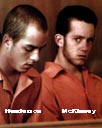
Mormon Russell A. Hendrson in court for the murder
of Gay student Matthew Shepard in Laramie [click to enlarge]
133. ***** Crockett email to
Connell O'Donovan, April 2, 2002.
134. Ernest L.
Wilkinson (ed.), Brigham Young University: The First One Hundred
Years (BYU Press 1976) vo. 3, pp. 269-70; for LAPD
treatment of Gays, see John D'Emilio, Sexual Politics, Sexual
Communities: The Making of a Homosexual Minority in the United
States, 1940-1970 (University of Chicago Press, 1983) and Long
Road to Freedom: the Advocate History of the Gay and Lesbian
Movement, Mark Thompson ed. (New York, St. Martin's Press,
1994). The following is drawn from Long Road to Freedom:
In Los Angeles, Gays were harasssed by police
under city code "647A", lewd conduct. The LA Police Commision's
"Rule 9" also forbade drag performances on stage, which was
overturned in January 1969 under growing public pressure to treat
Gays better. During the 1950s especially, the LA newspapers
published the names of all gay bar patrons that the police had
arrested. (p. 17) Lesbians were particularly susceptible to police
harassment. One Lesbian woman in the 1950s was raped by a cop and
then arrested by him. (p. 18)
In the early months of 1967, the LAPD led a crack
down on the Black Cat bar. Ten more Gays were arrested for "lew
conduct" (simply for being in a Gay bar) in Silver Lake in August.
Gays organized large protests in the wake of these arrests. Things
grew more sinister when in February 1968, a 60 year old man from
Pasadena named Jack McQuoid killed himself after being entrapped
for "lewd conduct" by members of the LAPD. (pp. 3,4, and 12)
The very first issue of the Advocate
(September 1967) asked, "Will the day come when law officers will
not be allowed to vent their hatred of homosexuals...? That day
will come. We do not ask for our rights on bended knee. We demand
them, standing tall, as dignified human beings. We will not go
away." Follwoing issues included cautionary articles on how to
deal with entrapment, bar raids, and being arrested. (pp. 1 and 3)
The January 1969 issue reported that police had quotas to fill at
gay bars and parks. (p. 18)
Troy Perry founded the Metropolitan Community
Church in October 1968 in Los Angeles "after witnessing police
repression". (p. 19) The situation turned lethal when Howard
Efland, a small, timid male nurse was arrested on March 9, 1969 by
LA vice officers Lemuel Chauncey and Richard Halligan. Chauncey
claimed that Efland groped him so the two arrested him, drug him
out into the street, and in front of several witnesses the two
police officers beat the unarmed, unresistant Gay man to death.
The LAPD at first informed his parents that their son had merely
died of a heart attack. The nominal jury ruled Elfland's death an
"excusable homicide" and the story was withheld from the straight
press. However the Advocate responded by calling the
LAPD "psychotics" and Rev. Troy Perry led 120 marchers in a rally
at the site of Efland's murder to commemorate his fatal beating.
In the 1970s, Gay relations with the LAPD drastically improved.
135. David
C. Martin to 7th East Press, July 21, 1982, copy in my
possession.
136. Wilkinson
private journal, May 21, 1959, copy in my possession.
137. Ibid.,
September 12, 1962.
138. Deseret
News, "Church News" supplement, November 13, 1965, p. 11.
Emphasis is mine.
139. Martin to 7th East
Press, 1982.
140. Robert I.
McQueen, "Outside
the Temple Gates - The Gay Mormon", The Advocate, 13
Aug. 1975; and Vanguard, student newspaper at Portland
State University, October 28, 1975.
141. "Annual
Report/Summary of Cases," BYU, 1 September 1967 to 31 August 1968,
copy in my possession.
142. Brigham
Young University Bulletin: Catalog of Courses 1968/70, pp.
39-40.
143. Erick Myers
interviewed by Connell O'Donovan, August 14, 1991, transcript in
my possession.
144. Donald R********
email to Connell O'Donovan, April 26, 2002.
145. Earl Donald
Attridge, We'll Find A Place, 1997, online at http://www.geocities.com/Athens/Column/5252/,
Chap. 8.
146. K.A.
Lauritzen to E.L. Wilkinson, June 18, 1969, copy in my
possession.
147. Donal
Attridge (writing anonymously), "Mormon and Gay...One man's tale
of bloody knuckles", Daily Utah Chronicle, Jan. 31,
1978, p. 1. Those who responded on February 2 were Charles F.
Hunt, "Wisdom of the ages"; Pink Triangle (Anon.), "Chrony does
service"; Larry Dean Hardison, "Old sinful nature"; Dominick
Carson, "Timely article"; on February 3, Douglass R. Hunger, "Lack
of validity"; James Allen, "Purely fictional"; on February 6, Rev.
E. John Langlitz, "our walls of paranoia"; Frank Eddings, "Hard up
for news"; Claude Warner, "Being a member"; on February 7, Wall
Earl, "A Chrony chuckle"; Scott H. Naegle, "Conform with rules";
on February 8, name withheld, "I can sleep well"; Michael C.
Cress, "$30 burial plot". For the response from the one who had
been blacklisted at BYU, see "The misery and suffering of
homosexuals at B.Y.U.", Daily Utah Chronicle, February
7, 1978.
148. Minutes, BYU
Board of Trustees, May 2, 1973, copy in my possession.
149. Ibid.,
December 6, 1972.
150. Ibid., May 2,
1973.
151. David C.
Martin to 7th East Press, July 21, 1982, copy
in my possession.
152. Dean
Huffaker, "Homosexuality at BYU" p. 2, 7th East Press,
April 12, 1982, pp. 1 and 12; BYU's Monday Magazine,
March 24, 1975.
153. Huffaker,
"Homosexuality at BYU" p. 2, pp. 1 and 12; Jerold and Sandra
Tanner to the New York Times, Feb. 1975; Ben Williams
interview with Connell O'Donovan, August 15, 1991, notes in my
possession; regarding Security surveillance of Gays, see "Gays
Protest Power - BYU Security Personnel Can Operate Off Campus", Salt
Lake Tribune, October 23, 1979, p. D2; regarding the
T-shirts, see Lee C. email to Connell O'Donovan, July 13, 2004. I
personally recall being on BYU campus in the summers of 1976 and
1977 for the World Conference on [Genealogical] Records and
noticing that the men's restrooms in the Wilkinson Center were
highly used for sexual activity. Large holes were cut through
stall walls and extremely graphic graffiti covered them. I was a
naive farm boy in my mid-teens and this was my first experience
with such a blatant "public sex environment", all the more
disturbing to me at the time because of it's location at the heart
of "the Lord's university". I noticed many years later, after the
rennovation of the Wilkinson Center, that all the flimsy stalls
had been replaced with thick brick walls, floor to ceiling.
154. Interview
with Sgt. Kal O. Farr, February 3, 1978, copy of notes in my
possession; Provo Daily Herald, March 22,1976.
155. Ben Williams
interview with Connell O'Donovan, August 15, 1991. Carlyle D.
Marsden obituaries, Ogden Standard Examiner, March 10,
1976, pp. 11A and 10B.
156. Huffaker,
"Homosexuality at BYU", pt. 2, p. 12; Larry M***** email to
Connell O'Donovan, October 5, 1995, copy in my possession.
157. Minutes,
Combined Boards' Meeting, September 1, 1976, copy in my
possession.
158. Dallin H.
Oaks to Thomas S. Monson, September 13, 1979.
159. Ibid.; Victor
L. Brown Jr. to Robert K. Thomas, November 14, 1978, p. 1, Dallin
H. Oaks to J. Richard Clarke, March 7, 1979, and Victor L. Brown
Jr. to Robert K. Thomas, September 11, 1979, copies of all in my
possession.
160. Victor L.
Brown Jr. to Robert K. Thomas, November 14, 1978, copy in my
possession.
160A. Allen E. Bergin,
"Bringing the Resoration into the Academic World", BYU
Studies 19 (1979), pp. 463-4. Bergin,"Psychotherapy and
Religious Values", Journal of Consulting and Clinical
Psychology 48, no. 1 [1980], pp. 95–105. Alan P. Bell and
Martin S. Weinberg, Homosexualities: a Study of Diversity
Among Men and Women ( New York: Simon & Schuster) 1978,
p. 196. For LDS response to Bergin's paper, see Mary Lynn Bahr,
"Against the Current", BYU Magazine, Summer 1999, vol.
53, no. 2, available online at http://magazine.byu.edu/g/?act=view&a=224
<accessed May 10, 2010>.
161. Copy of Lauritsen's "The
Role of the Father in Male Homosexuality" in my possession.
162. Michael R.
Bergin email to Hugo Salinas and Connell O'Donovan, January 13,
2003.
163. Gary James Bergera and
Ronald Priddis, Brigham Young University: A House of Faith
(Salt Lake City: Signature Books, 1985), pp. 83- 84.
164. Gary Bergera interview
with Gerald Dye, February 1, 1978, pp. 1 and 2, copy of notes in
my possession.
165. Bergera-Dye interview,
p. 2.
166. Max Ford McBride, Effect
of Visual Stimuli in Electric Aversion Therapy, PhD
Dissertaion, BYU, August 1976; John Cameron email to Connell
O'Donovan, June 30, 1999.
167. Transcript of
Legacies at http://www.lds-mormon.com/legacies.shtml.
167A. Carol Lynn
Pearson, Goodbye, I Love You (New York: Random House,
1986), pp. 98-99. For Sam's "gay-bashing" see p. 175.
168. "Gay
Activists To Picket LDS Temple", Salt Lake Tribune,
October 2, 1981, p. D6 and "LDS Stand Chided - Group Marches for
Gay Rights", Salt Lake Tribune, October 5, 1981, p. B6.
169. The Open
Door, August 1978, p. 17, Daily Utah Chronicle,
July 20, 1978, p. 1, and Sunstone Review, Sept. 1982, p.
8. As of 2003, the KQED archives in San Francisco has the audio
tape of the 1978 documentary, but the archivist is unable to
locate the video images.
170. For the law
suit against D. Eugene Thorne and the Provo Canyon School, see http://familyrightsassociation.com/bin/title42sec1983/milonas_v_williams.htm
and http://www.beyondbusiness.net/provotruth.htm.
Merrill J. Bateman to Connell O'Donovan (email sent via Brent
Harker, BYU Director of Public Communications), April
9, 1997, copy in my possession. Bateman incorrectly assumed
that I was a "professor" and addressed me as such in this email.
171. Connell
O'Donovan interview with "Farris" (colleague of Howard Salisbury),
regarding Salisbury's role in editing Prologue, August
15, 1991, notes in my possession; BYU Executive Committee Minutes,
September 15, 1977, copy in my possession; Prologue: An
Examination of Mormon Attitudes Towards Homosexuality,
(n.c.: Prometheus Enterprises, 1978), reprinted by Affirmation:
Gay and Lesbian Mormons.
172. The Open
Door, September 1977, Marriott Library, University of Utah.
173.
Buerger-Marshall interview (see note 100).
174. Ibid.; Dean
Huffaker, "Homosexuality at BYU", pt. 2, Seventh East Press,
April 1982, p. 12; and BYU Executive Committee Minutes, September
15, 1977.
175. Huffaker,
"Homosexuality at BYU," pt. 2, p. 12.
176.
Buerger-Marshall interview.
177. Anonymous,
handwritten statement on frontispiece of one copy of Bergin's
"Reply" in my possession.
178. BYU Executive
Committee Minutes, September 15, 1977.
179. For Packer
turning down Kimball, see Lucile C. Tate, Boyd K. Packer: A
Watchman on the Tower, (Salt Lake City: Bookcraft, 1995),
p. 300. Dallin H. Oaks to Boyd K. Packer, February 14, 1978, copy
in my possession; The Advocate, February 22, 1978.
180. Dallin H.
Oaks to Jeffrey R. Holland, November 9, 1978, copy in my
possession.
181. Boyd K. Packer, "To the
One", (Salt Lake City: Church of Jesus Christ of Latter-day
Saints, 1978), March 5, 1978. Ironically, the Greek philosopher
Plato took an opposite point of view, theorizing that selfishness
causes homophobia, not homosexuality: "Thus whenever it is
accepted that it is shameful to value same-sex lovers, this is due
to malice in the legislature, selfishness in the rulers, and
cowardice in the governed." Plato, Symposium 182-D, my
translation). Larry M***** email to Connell O'Donovan, October 5,
1995, copy in my possession.
182.
Buerger-Marshall interview.
183. Salt Lake
Open Door, Apr. 1978, p. 5.
184. Anonymous
letter, Salt Lake Open Door, April 1978, p. 11.
185."Gays at
BYU", The Open Door, November 1978 (vol. 2, no. 11);
classified section, The Open Door, December 1978 and January 1979;
"Provoan bound over in sex case", The Daily Universe,
March 28, 1979, p. 3; BYU Board of Directors' minutes, p. 2-3,
copy in my possession; Minutes of the President's Weekly Meeting,
p. 3, copy in my possession; "Other Minorities", Sunstone,
Issue 15, May 1979; "'Mormon Militia' of Morality - Attorney
Challenging Arrest by Y. Campus Police", Salt Lake Tribune,
September 8, 1979; "Stanger and Child Protest Utah Law - Lunnen,
Oaks Refute Critics of 'Y' Security Powers", Daily Herald,
September 3, 1979; "Y aide clarifies harassment story" and "Court
day set for Oct. 25 in felony trial", Daily Universe,
September 28, 1979, p. 1; "Trial in BYU Gay Arrest Postponed", Ogden
Standard Examiner, October 18, 1979, p. 11A; "Gays Protest
Power - BYU Security Personnel Can Operate Off Campus", Salt
Lake Tribune, October 23, 1979, p. D2; "Groups Protest
Power of BYU Police", Sunstone, Issue 17-18, December
1979;"Y sexual abuse case, decision forthcoming", Daily
Universe, April 1, 1980, p. 1; "Chipman found guilty of
attempted abuse", Deseret News, April 8, 1980, p. 1;
"Salt Lake will appeal conviction in Provo case", Deseret
News, April 12, 1980, p. A7; "Provoan Sentenced On Morals
Charge", Daily Universe, April 13, 1980, p. 27; "Former
Y student's conviction upheld", Daily Universe, January
12, 1982, p. 3. Ballantyne and Whiting interview in "BYU-Witch
Hunt", The Open Door, May 1979, p. 1.
186. Lee C. emails
to Connell O'Donovan, May 27 and July 13, 2004. Virginia
Lawyers Weekly, July 14, 2001; see http://www.valawyersweekly.com/barpassjul01.htm;
"BYU-Witch Hunt", The Open Door, May 1979, p. 1.
Chipman's case has a similar repeat 10 years later when two Gay
BYU students met at the Richards PE building, began to fall in
love, and one evening went for a drive up Provo Canyon. They
pulled into a state park and began kissing and some heavy petting.
A Utah State Trooper intervened, asked if they were BYU students,
to which they lied, and he merely took down their driver's license
numbers and left. Five days later, Daniel H----- was called into
Burton Kelley's office at the Standards Office. The police officer
had filed a report with Kelley that he had seen Daniel and his
partner having anal sex, which was patently false. Daniel's
ecclesiastical endorsement was withdrawn and he was forced to
withdraw from school. Daniel's partner was nearly finished with
his bachelor's degree so he was allowed to stay in only after a
psychiatrist had treated him until he claimed that his sexual
orientation was "normal and heterosexual", although he was lying
just to get out of the difficult situation. They consulted a
lawyer, who told them they had a really good case against the
police and BYU, but decided to forego any legal action to save
their families from the scandal of publicity. Daniel H------ to
Connell O'Donovan, email, May 27, 1991, copy in my possession.
187. Mark S-------
interview with Connell O'Donovan August 11, 2004 and Mark S-------
email to Connnell O'Donovan, August 22, 2004, copy in my
possession.
188. Jeffrey
Holland to William Rolfe Kerr, October 7, 1980, copy
in my possession.
189. Phone
interview with David O**** on April 17, 1991; his Brigham Young
University transcripts, copy in my possession.
190. "Evergreen
International's Principles and Programs", (n.c.: n.p., 1993). For
Russ Gorringe's story see "Ex-Gay.
Evergreen's Promise, One Man's Struggle". He is also the
subject of a film documentary called Marriages, Hopes, and
Realities.
191. For one
example of Byrd 's viewpoint, see Byrd, Cox, and Robinson's "Homosexuality:
The Innate-Immutability Argument Finds No Basis in Science".
Packard, Packard, and Schow then responded to Byrd et al. with
"There is No Evicence
Homosexuals Can Change, Only Evidence of Deception". Mormon
clinical social worker with LDS Family Services, G. Allen Gundry
(a dear friend of mine) also more cautiously disagrees with Byrd's
claims in his 2003 pro-marriage "Counseling
with Homosexual Latter-day Saints". For official church
view, see Understanding and Helping Those Who Have Homosexual
Problems: Suggestions for Ecclesiastical Leaders, (Salt Lake
City: Church of Jesus Christ of Latter-day Saints, 1992).
192. "Apostle
Packer Says 'So-Called' Scholars, Gays, Feminists Are Leading LDS
Astray," Salt Lake Tribune, July 24, 1993, p. B1.
193. M. Russell
Ballard to Mike Triggs, August 10, 1993, copy in my possession.
194. Hugh B. Brown
and First Presdiency statements of 1963 and 1969, as quoted in
Leonard J. Arrington, Adventures of a Church Historian,
(Urbana and Chicago: University of Illionis Press, 1998),
pp.180-1. First Presidency statement, February 13, 1994, copy in
my possession. See Richley H. Crapo's 1997 "Chronology
Of Mormon / LDS Involvement In Same-Sex Marriage Politics"
and 1999 "LDS
Doctrinal Rhetoric and the Politics of Same-Sex Marriage".
195. See Sam Clayton,
"Winning and Losing: One Kid's Best Shot at BYU" at http://www.affirmation.org/learning/winning_or_losing.shtml

© 1994, Connell
O'Donovan, revised 2004
Please do not copy without my express, written permission.
.
